In Business Since 2004
Enzymes & Proteins
Proteins are polypeptide structures consisting of one or more long chains of amino acid residues. Each amino acid contains a central carbon, a hydrogen, a carboxyl group, an amino group, and a variable R group. The R group specifies which class of amino acids it belongs to: electrically charged hydrophilic side chains, polar but uncharged side chains, nonpolar hydrophobic side chains, and special cases. Proteins carry out a wide variety of functions, including cellular regulation and replication, transportation of small molecules, catalyzing metabolic reactions, and providing structural support to cells. Moreover, proteins are significant therapeutic targets, interfering with the regulation of pathogens or cancer cells. To learn more about our enzyme and protein products and services, please contact the experts at CASSIA, LLC.
Acyltransferases
Template
- Description: Add Description Here.
- Synonyms: Name #1; Name #2; Nrame #3
- Reaction: Reactent = Product
- Unit Definition: One unit will interconvert 1.0 μmole of X to Y per min at pH 7.5 and 30 oC.
- Chemical Purity: ≥ 90% (SDS-PAGE)
- Form: 1X PBS Buffer, pH 7.5; 50% Glycerol
- Storage: ≤ -20 oC; Avoid Freeze-Thaw Cycles
| Product Number | Description - Stable Isotope Position | Availability | Unit Size | Price |
|---|---|---|---|---|
| UNIPROT-1 | G. species ABC [EC #.#.#.#]; ≥ 1 units/mg protein; Recombinant from E. coli | 30-Day Lead Time | 1 mg | Quote |
| Custom Expression | (Please Explore our Custom Expression Options for Insperation) | Variable Lead Times | TBD | Quote |
* Stable isotope labeled proteins are exclusively marketed & sold through Cambridge Isotope Laboratories (CIL).
Glucosamine-Phosphate N-Acetyltransferase
- Description: Add Description Here.
- Synonyms: Name #1; Name #2; Nrame #3
- Reaction: Reactent = Product
- Unit Definition: One unit will interconvert 1.0 μmole of X to Y per min at pH 7.5 and 30 oC.
- Chemical Purity: ≥ 90% (SDS-PAGE)
- Form: 1X PBS Buffer, pH 7.5; 50% Glycerol
- Storage: ≤ -20 oC; Avoid Freeze-Thaw Cycles
| Product Number | Description - Stable Isotope Position | Availability | Unit Size | Price |
|---|---|---|---|---|
| Q4WCU5-1 | N. fumigata afuA [EC 2.3.1.4]; ≥ 1 units/mg protein; Recombinant from E. coli | 30-Day Lead Time | 1 mg | Quote |
| Custom Expression | (Please Explore our Custom Expression Options for Insperation) | Variable Lead Times | TBD | Quote |
* Stable isotope labeled proteins are exclusively marketed & sold through Cambridge Isotope Laboratories (CIL).
Phosphate Acetyltransferase
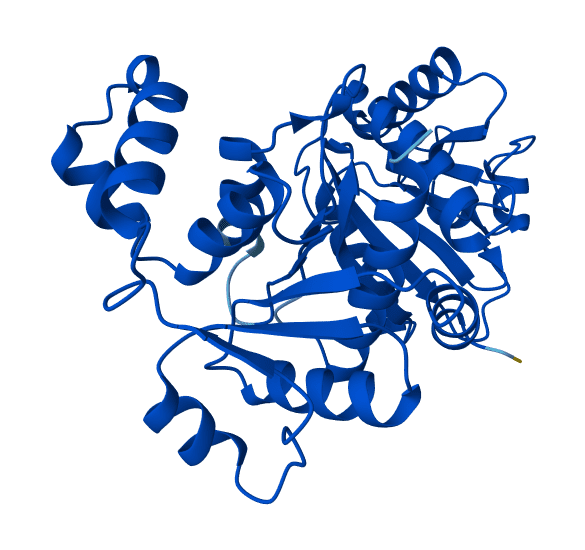
- Description: Phosphate Acetyltransferase (PTAS) participates in three (3) metabolic pathways: taurine and hypotaurine metabolism, pyruvate metabolism, and propanoate metabolism. It is commonly used to study these metabolic pathways in various bacterium.
- Synonyms: Phosphoacylase; Phosphotransacetylase
- Reaction: Acetyl-CoA + Phosphate = Acetylphosphate + CoA
- Unit Definition: One unit will convert 1.0 μmole of CoA to acetyl-CoA per min at pH 7.4 at 25 oC using Acetylphosphate as substrate.
- Chemical Purity: ≥ 90% (SDS-PAGE)
- Form: 1X PBS Buffer, pH 7.5; 50% Glycerol
- Storage: ≤ -20 oC; Avoid Freeze-Thaw Cycles
| Product Number | Description - Stable Isotope Position | Availability | Unit Size | Price |
|---|---|---|---|---|
| P38503-1 | M. thermophila PTAS [EC 2.3.1.8]; ≥ 250 units/mg protein; Recombinant from E. coli | 30-Day Lead Time | 1 mg | Quote |
| K9HZU2-1 | B. stearothermophilus PTAS [EC 2.3.1.8]; ≥ 250 units/mg protein; Recombinant from E. coli | 30-Day Lead Time | 1 mg | Quote |
| Custom Expression | (Please Explore our Custom Expression Options for Insperation) | Variable Lead Times | TBD | Quote |
* Stable isotope labeled proteins are exclusively marketed & sold through Cambridge Isotope Laboratories (CIL).
Dehydrogenases
Template
- Description: Add Description Here.
- Synonyms: Name #1; Name #2; Nrame #3
- Reaction: Reactent = Product
- Unit Definition: One unit will interconvert 1.0 μmole of X to Y per min at pH 7.5 and 30 oC.
- Chemical Purity: ≥ 90% (SDS-PAGE)
- Form: 1X PBS Buffer, pH 7.5; 50% Glycerol
- Storage: ≤ -20 oC; Avoid Freeze-Thaw Cycles
| Product Number | Description - Stable Isotope Position | Availability | Unit Size | Price |
|---|---|---|---|---|
| UNIPROT-1 | G. species ABC [EC #.#.#.#]; ≥ 1 units/mg protein; Recombinant from E. coli | 30-Day Lead Time | 1 mg | Quote |
| Custom Expression | (Please Explore our Custom Expression Options for Insperation) | Variable Lead Times | TBD | Quote |
* Stable isotope labeled proteins are exclusively marketed & sold through Cambridge Isotope Laboratories (CIL).
Alcohol Dehydrogenase

- Description: Alcohol Dehydrogenase (ADH) is found in many organisms and facilitate the interconversion between alcohols and aldehydes or ketones with the reduction of nicotinamide adenine dinucleotide (NAD+ to NADH). ADH serves to also break down alcohols that otherwise are toxic, as well as, participate in the generation of useful aldehyde, ketone, or alcohol groups during biosynthesis of various metabolites. In yeast, plants, and many bacteria, some alcohol dehydrogenases catalyze the opposite reaction as part of fermentation. Alcohol Dehydrogenases are often used for the synthesis of enantiomerically pure stereoisomers of chiral alcohols.
- Synonyms: Alcohol:NAD+ Oxidoreductase; Aldehyde Reductase; ADH
- Reaction: A Primary Alcohol (or Secondary Alcohol) + NAD+ = An Aldehyde (or Ketone) + H+ + NADH
- Unit Definition: One unit will convert 1.0 μmole of ethanol to acetaldehyde per min at pH 8.5 and 25 oC.
- Chemical Purity: ≥ 90% (SDS-PAGE)
- Form: 1X PBS Buffer, pH 7.5; 50% Glycerol
- Storage: ≤ -20 oC; Avoid Freeze-Thaw Cycles
| Product Number | Description - Stable Isotope Position | Availability | Unit Size | Price |
|---|---|---|---|---|
| P00330 | S. cerevisiae ADH [EC 1.1.1.1] NAD/H Dependant; ≥ 300 units/mg protein; from Baker's Yeast | 30-Day Lead Time | 1 mg | Quote |
| Custom Expression | (Please Explore our Custom Expression Options for Insperation) | Variable Lead Times | TBD | Quote |
* Stable isotope labeled proteins are exclusively marketed & sold through Cambridge Isotope Laboratories (CIL).
Glucose-6-Phosphate Dehydrogenase

- Description: Glucose 6-Phosphate Dehydrogenase (G6PDH) is a key regulatory enzyme in the first step of the pentose phosphate pathway. G6PDH has been used to investigate the effect of dehydroepiandrosterone on cell growth and mitochondrial function in TM-3 cells, the incidence of apoptosis and transcript abundance in bovine follicular cells, and to test ketose reductase activity in developing maize endosperm.
- Synonyms: Glucose-6-Phosphate 1-Dehydrogenase; G6PDH
- Reaction: D-Glucose-6-Phosphate + NAD(P)+ = 6-Phospho-D-Glucono-1,5-Lactone + H+ + NAD(P)H
- Unit Definition: One unit will oxidize 1.0 μmole of D-glucose-6-phosphate to 6-phospho-D-gluconate per min at pH 7.5 and 30 oC.
- Chemical Purity: ≥ 90% (SDS-PAGE)
- Form: 1X PBS Buffer, pH 7.5; 50% Glycerol
- Storage: ≤ -20 oC; Avoid Freeze-Thaw Cycles
| Product Number | Description - Stable Isotope Position | Availability | Unit Size | Price |
|---|---|---|---|---|
| P0AC53-1 | E. coli G6PDH [EC 1.1.1.49] NADP/H Dependant; ≥ 600 units/mg protein; Recombinant from E. coli | 30-Day Lead Time | 1 mg | Quote |
| P11412 | S. cerevisiae G6PDH [EC 1.1.1.49] NADP/H Dependant; ≥ 200 units/mg protein; from Baker's Yeast | 30-Day Lead Time | 1 mg | Quote |
| P11411-1 | L. mesenteroides G6PDH [EC 1.1.1.363] NAD(P)/H Dependant; ≥ 500 units/mg protein; Recombinant from E. coli | 30-Day Lead Time | 1 mg | Quote |
| Custom Expression | (Please Explore our Custom Expression Options for Insperation) | Variable Lead Times | TBD | Quote |
* Stable isotope labeled proteins are exclusively marketed & sold through Cambridge Isotope Laboratories (CIL).
Glutamate Dehydrogenase

- Description: Glutamate Dehydrogenase (GluDH) is an oxidoreductase enzyme found in both prokaryotes and eukaryotes. GluDH relates the catabolic and anabolic pathways of carbon and nitrogen metabolism. This enzyme is a robust and ideal candidate for research use, with applications in the diagnostics and food industries.
- Synonyms: Glutamic Dehydrogenase; GluDH; GLDH; GDH
- Reaction: H2O + L-Glutamate + NAD(P)+ = 2-Oxoglutatate + H+ + NAD(P)H + NH4+
- Unit Definition: One unit will reduce 1.0 μmole of 2-oxoglutarate to L-glutamate per min at pH 7.5 and 25 oC, in the presence of ammonium ions.
- Chemical Purity: ≥ 90% (SDS-PAGE)
- Form: 1X PBS Buffer, pH 7.5; 50% Glycerol
- Storage: ≤ -20 oC; Avoid Freeze-Thaw Cycles
| Product Number | Description - Stable Isotope Position | Availability | Unit Size | Price |
|---|---|---|---|---|
| P00366 | B. taurus GluDH [EC 1.4.1.3] NAD(P)/H Dependant; ≥ 30 units/mg protein; from Bovine Liver | 30-Day Lead Time | 1 mg | Quote |
| P00370-1 | E. coli GluDH [EC 1.4.1.4] NADP/H Dependant; ≥ 250 units/mg protein; Recombinant from E. coli | 30-Day Lead Time | 1 mg | Quote |
| B4F018 | P. mirabilis GluDH [EC 1.4.1.4] NADP/H Dependant; ≥ 400 units/mg protein; from P. mirabilis | 30-Day Lead Time | 1 mg | Quote |
| Custom Expression | (Please Explore our Custom Expression Options for Insperation) | Variable Lead Times | TBD | Quote |
* Stable isotope labeled proteins are exclusively marketed & sold through Cambridge Isotope Laboratories (CIL).
IMP Dehydrogenase
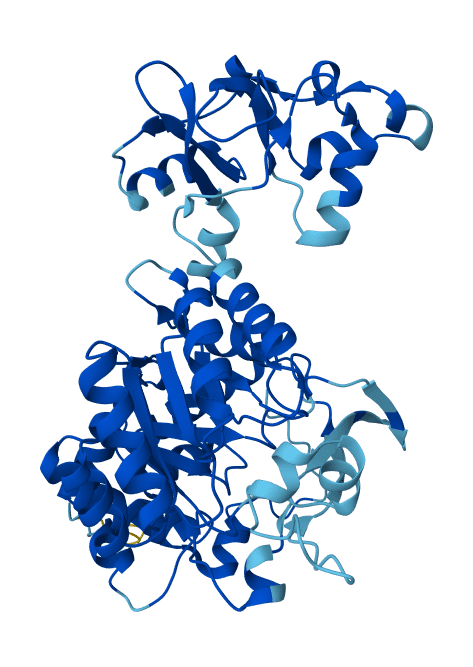
- Description: IMP Dehydrogenase (IMPDH) is a purine biosynthetic enzyme that catalyzes the nicotinamide adenine dinucleotide (NAD+)-dependent oxidation of inosine 5′-monophosphate (IMP) to xanthosine 5′-monophosphate (XMP) in the first committed and rate-limiting step in the de novo biosynthesis of guanine nucleotides. IMPDH is a regulator of the intracellular guanine nucleotide pool, and is therefore important for DNA and RNA synthesis, signal transduction, energy transfer, glycoprotein synthesis, as well as, other process that are involved in cellular proliferation. In humans, IMPDH expression is found to be upregulated in some tumor tissues and cell lines, and therefore has been addressed as a drug target for immunosuppressive and cancer chemotherapy.
- Synonyms: IMP Oxidoreductase; Inosinate Dehydrogenase; IMPDH
- Reaction: H2O + IMP + NAD+ = H+ + NADH + XMP
- Unit Definition: One unit will oxidize 1.0 μmole of IMP to XMP per min at pH 7.5 and 25 oC.
- Chemical Purity: ≥ 90% (SDS-PAGE)
- Form: 1X PBS Buffer, pH 7.5; 50% Glycerol
- Storage: ≤ -20 oC; Avoid Freeze-Thaw Cycles
| Product Number | Description - Stable Isotope Position | Availability | Unit Size | Price |
|---|---|---|---|---|
| P0ADG7-1 | E. coli IMPDH [EC 1.1.1.205] NAD/H Dependant; ≥ 1 unit/mg protein; Recombinant from E. coli | 30-Day Lead Time | 1 mg | Quote |
| Custom Expression | (Please Explore our Custom Expression Options for Insperation) | Variable Lead Times | TBD | Quote |
* Stable isotope labeled proteins are exclusively marketed & sold through Cambridge Isotope Laboratories (CIL).
Lactate Dehydrogenase

- Description: Lactate Dehydrogenase (LDH) is a crucial enzyme that plays a vital role in the anaerobic metabolic pathway, and crucial to cellular energy production in environments with low oxygen levels or hypoxic conditions. High Lactate Dehydrogenase activity is associated with various medical conditions, such as liver disease, anemia, heart attack, bone fractures, muscle trauma, and certain types of cancer. LDH activity is also significant in tumor glycolysis and the Warburg effect, as well as, a potential marker of cell injury and death.
- Synonyms: Lactic Dehydrogenase; Lactic Acid Dehydrogenase; LDH
- Reaction: Lactate + NAD+ = Pyruvate + H+ + NADH
- Unit Definition: One unit will convert 1.0 μmole of pyruvate to lactate per min at pH 7.5 and 25 oC.
- Chemical Purity: ≥ 90% (SDS-PAGE)
- Form: 1X PBS Buffer, pH 7.5; 50% Glycerol
- Storage: ≤ -20 oC; Avoid Freeze-Thaw Cycles
| Product Number | Description - Stable Isotope Position | Availability | Unit Size | Price |
|---|---|---|---|---|
| Q5E9B1 | B. taurus L-LDH [EC 1.1.1.27] NAD/H Dependant; ≥ 500 units/mg protein; from Bovine Heart | 30-Day Lead Time | 1 mg | Quote |
| P19858 | B. taurus L-LDH [EC 1.1.1.27] NAD/H Dependant; ≥ 500 units/mg protein; from Bovine Muscle | 30-Day Lead Time | 1 mg | Quote |
| P13491 | O. cuniculus L-LDH [EC 1.1.1.27] NAD/H Dependant; ≥ 750 units/mg protein; from Rabbit Muscle | 30-Day Lead Time | 1 mg | Quote |
| P00339 | S. scrofa L-LDH [EC 1.1.1.27] NAD/H Dependant; ≥ 200 units/mg protein; from Porcine Heart | 30-Day Lead Time | 1 mg | Quote |
| P52643-1 | E. coli D-LDH [EC 1.1.1.28] NAD/H Dependant; ≥ 100 units/mg protein; Recombinant from E. coli | 30-Day Lead Time | 1 mg | Quote |
| Q88VJ2 | L. leichmannii D-LDH [EC 1.1.1.28] NAD/H Dependant; ≥ 150 units/mg protein; from L. leichmannii | 30-Day Lead Time | 1 mg | Quote |
| Q5HLA0 | S. epidermidis D-LDH [EC 1.1.1.28] NAD/H Dependant; ≥ 75 units/mg protein; from S. epidermidis | 30-Day Lead Time | 1 mg | Quote |
| Custom Expression | (Please Explore our Custom Expression Options for Insperation) | Variable Lead Times | TBD | Quote |
* Stable isotope labeled proteins are exclusively marketed & sold through Cambridge Isotope Laboratories (CIL).
Phenylalanine Dehydrogenase
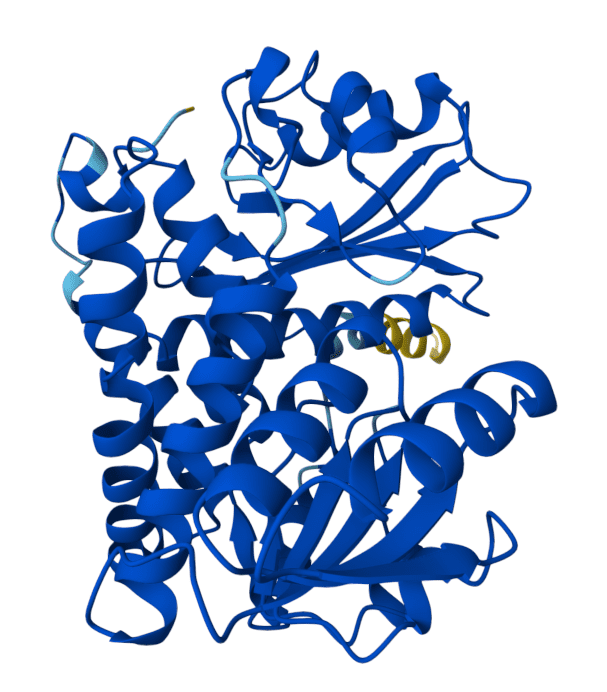
- Description: Phenylalanine Dehydrogenase (PheDH) plays an important role in pharmaceutical and fine chemical industries due to their ability to produce primary amines via asymmetrically reductive amination. PheDH is commonly used to study phenylalanine metabolism, as well as, the biosynthesis of phenylalanine, tyrosine, and tryptophan. Phenylalanine Dehydrogenase is also considered as an effective enzyme to estimate the quantity of phenylalanine to distinguish phenylketonuria (PKU) disease.
- Synonyms: L-Phenylalanine Dehydrogenase; PheDH
- Reaction: H2O + L-Phenylalanine + NAD+ = 3-Phenylpyruvate + H+ + NADH + NH4+
- Unit Definition: One unit will oxidize 1.0 μmole of L-phenylalanine per min at pH 10.5 and 30 oC.
- Chemical Purity: ≥ 90% (SDS-PAGE)
- Form: 1X PBS Buffer, pH 7.5; 50% Glycerol
- Storage: ≤ -20 oC; Avoid Freeze-Thaw Cycles
| Product Number | Description - Stable Isotope Position | Availability | Unit Size | Price |
|---|---|---|---|---|
| Q59224-1 | B. badius PheDH [EC 1.4.1.20] NAD/H Dependant; ≥ 100 units/mg protein; Recombinant from E. coli | 30-Day Lead Time | 1 mg | Quote |
| P23307-1 | L. sphaericus PheDH [EC 1.4.1.20] NAD/H Dependant; ≥ 150 units/mg protein; Recombinant from E. coli | 30-Day Lead Time | 1 mg | Quote |
| Custom Expression | (Please Explore our Custom Expression Options for Insperation) | Variable Lead Times | TBD | Quote |
* Stable isotope labeled proteins are exclusively marketed & sold through Cambridge Isotope Laboratories (CIL).
6-Phosphogluconate Dehydrogenase
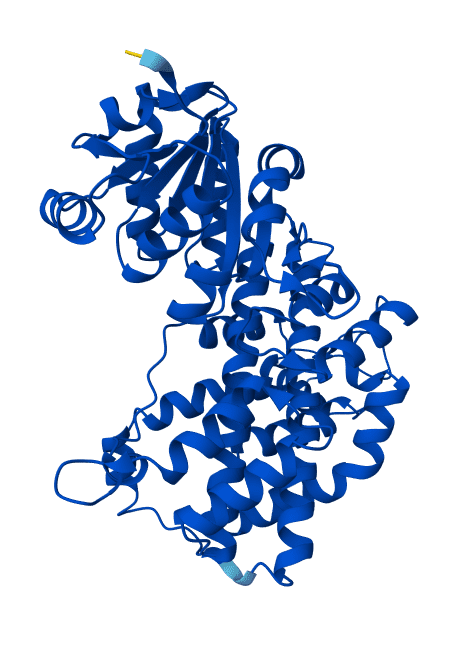
- Description: 6-Phosphogluconate Dehydrogenase (6PGDH) is a key enzyme in the oxidative portion of the hexose monophosphate shunt, specific for nicotinamide adenine dinucleotide phosphate (NADP+). 6PGDH is involved in the production of ribulose-5-phosphate, which is involved in nucleotide synthesis and the pentose phosphate pathway. 6-Phosphogluconate Dehydrogenase is used to study nucleotide synthesis, glucose metabolism, and the protection of cells from oxidative damage. Mutations within the gene result in 6-phosphogluconate dehydrogenase deficiency (an autosomal hereditary disease of red blood cells), and being involved in cancer cell metabolism.
- Synonyms: 6-Phosphogluconic Carboxylase; 6-Phosphogluconic Dehydrogenase; 6PGDH
- Reaction: 6-Phospho-D-Gluconate + NADP+ = CO2 + D-Ribulose-5-Phosphate + NADPH
- Unit Definition: One unit will oxidize 1.0 μmole of 6-phospho-D-gluconate to D-ribulose-5-phosphate and CO2 per min at pH 7.5 and 25 oC.
- Chemical Purity: ≥ 90% (SDS-PAGE)
- Form: 1X PBS Buffer, pH 7.5; 50% Glycerol
- Storage: ≤ -20 oC; Avoid Freeze-Thaw Cycles
| Product Number | Description - Stable Isotope Position | Availability | Unit Size | Price |
|---|---|---|---|---|
| P00350-1 | E. coli 6PGDH [EC 1.1.1.44] NADP/H Dependant; ≥ 100 units/mg protein; Recombinant from E. coli | 30-Day Lead Time | 1 mg | Quote |
| P53319 | S. cerevisiae 6PGDH [EC 1.1.1.44] NADP/H Dependant; ≥ 2 units/mg protein; from Baker's Yeast | 30-Day Lead Time | 1 mg | Quote |
| Custom Expression | (Please Explore our Custom Expression Options for Insperation) | Variable Lead Times | TBD | Quote |
* Stable isotope labeled proteins are exclusively marketed & sold through Cambridge Isotope Laboratories (CIL).
UDP-Glucose 6-Dehydrogenase
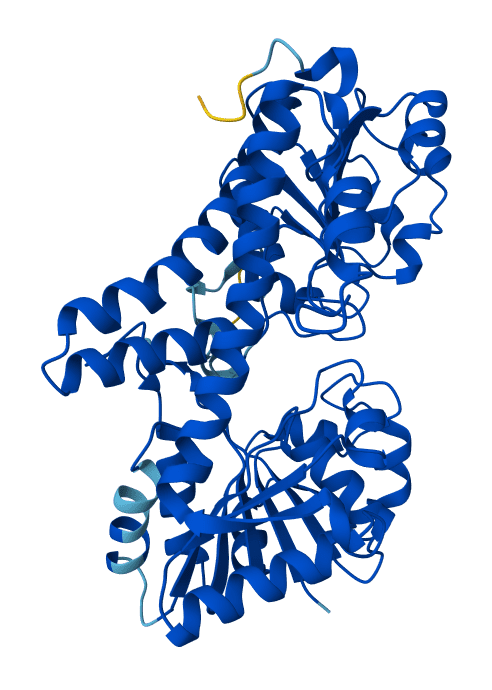
- Description: UDP-Glucose 6-Dehydrogenase (UGDH) that participates in the biosynthesis of nucleotide sugars for glycosaminoglycans such as hyaluronan, chondroitin sulfate, and heparan sulfate. These glycosylated compounds are common components of the extracellular matrix and likely play roles in signal transduction, cell migration, and cancer growth and metastasis. The expression of this gene is up-regulated by transforming growth factor-β and down-regulated by hypoxia, as well as, required for the formation of cell wall ingrowths on the outer cell walls of nematode-induced syncytia.
- Synonyms: UDP-α-D-Glucose:NAD Oxidoreductase; Name #2; Nrame #3
- Reaction: H2O + 2 NAD+ + UDP-α-D-Glucose = 3 H+ + 2 NADH + UDP-α-D-Glucuronate
- Unit Definition: One unit will oxidize 1.0 μmole of UDP-α-D-Glucose to UDP-α-D-Glucuronate per min at pH 8.5 and 25 oC.
- Chemical Purity: ≥ 90% (SDS-PAGE)
- Form: 1X PBS Buffer, pH 7.5; 50% Glycerol
- Storage: ≤ -20 oC; Avoid Freeze-Thaw Cycles
| Product Number | Description - Stable Isotope Position | Availability | Unit Size | Price |
|---|---|---|---|---|
| Q9LIA8-1 | A. thaliana ugdH [EC 1.1.1.22] NAD/H Dependant; ≥ 50 units/mg protein; Recombinant from E. coli | 30-Day Lead Time | 1 mg | Quote |
| P0C0I8-1 | S. pyogenes hasC [EC 1.1.1.22] NAD/H Dependant; ≥ 2 units/mg protein; Recombinant from E. coli | 30-Day Lead Time | 1 mg | Quote |
| Custom Expression | (Please Explore our Custom Expression Options for Insperation) | Variable Lead Times | TBD | Quote |
* Stable isotope labeled proteins are exclusively marketed & sold through Cambridge Isotope Laboratories (CIL).
Epimerases
Template
- Description: Add Description Here.
- Synonyms: Name #1; Name #2; Nrame #3
- Reaction: Reactent = Product
- Unit Definition: One unit will interconvert 1.0 μmole of X to Y per min at pH 7.5 and 30 oC.
- Chemical Purity: ≥ 90% (SDS-PAGE)
- Form: 1X PBS Buffer, pH 7.5; 50% Glycerol
- Storage: ≤ -20 oC; Avoid Freeze-Thaw Cycles
| Product Number | Description - Stable Isotope Position | Availability | Unit Size | Price |
|---|---|---|---|---|
| UNIPROT-1 | G. species ABC [EC #.#.#.#]; ≥ 1 units/mg protein; Recombinant from E. coli | 30-Day Lead Time | 1 mg | Quote |
| Custom Expression | (Please Explore our Custom Expression Options for Insperation) | Variable Lead Times | TBD | Quote |
* Stable isotope labeled proteins are exclusively marketed & sold through Cambridge Isotope Laboratories (CIL).
UDP-N-Acetylglucosamine 4-Epimerase
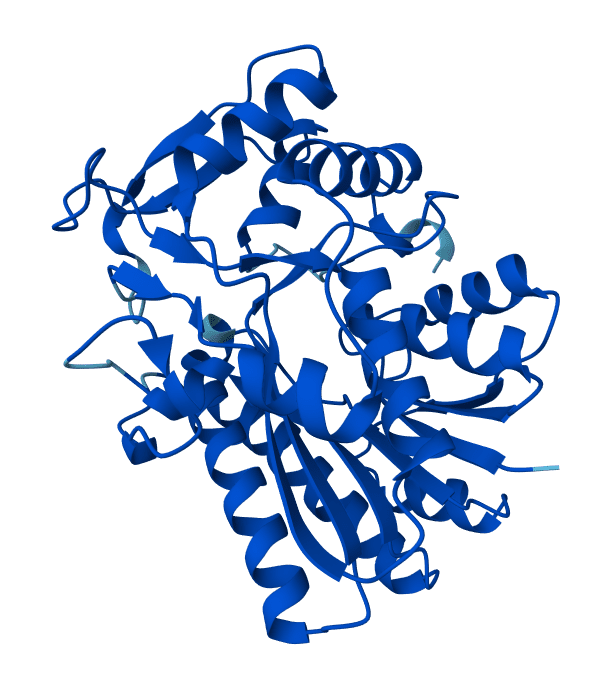
- Description: UDP-N-Acetylglucosamine 4-Epimerase (UGNE) plays a critical role in the Leloir pathway, catalyzing the interconversion of UDP-N-acetyl-D-glucosamine (UDP-GlcNAc) and UDP-N-acetyl-D-galactosamine (UDP-GalNAc). It contributes to the catabolism of dietary galactose and enables the endogenous biosynthesis of both UDP-Galactose (UDP-Gal) and UDP-GalNAc when exogenous sources are limited. Both UDP-sugar interconversions are important in the synthesis of glycoproteins and glycolipids. Autosomal recessive deficiency in UGNE manifests with galactosemia, liver failure, and aminoaciduria.
- Synonyms: UDP-GlcNAc 4-Epimerase; Uridine Diphosphoacetylglucosamine Epimerase
- Reaction: UDP-N-Acetyl-α-D-Glucosamine = UDP-N-Acetyl-α-D-Galactosamine
- Unit Definition: One unit will interconvert 1.0 μmole of UDP-GlcNAc to UDP-GalNAc per min at pH 7.5 and 25 oC.
- Chemical Purity: ≥ 90% (SDS-PAGE)
- Form: 1X PBS Buffer, pH 7.5; 50% Glycerol
- Storage: ≤ -20 oC; Avoid Freeze-Thaw Cycles
| Product Number | Description - Stable Isotope Position | Availability | Unit Size | Price |
|---|---|---|---|---|
| E8MF10-1 | B. longum UGNE [EC 5.1.3.7]; ≥ 200 units/mg protein; Recombinant from E. coli | 30-Day Lead Time | 1 mg | Quote |
| Custom Expression | (Please Explore our Custom Expression Options for Insperation) | Variable Lead Times | TBD | Quote |
* Stable isotope labeled proteins are exclusively marketed & sold through Cambridge Isotope Laboratories (CIL).
UDP-Glucose 4-Epimerase

- Description: UDP-Glucose 4-Epimerase (UGE) plays a critical role in the Leloir pathway, catalyzing the interconversion of UDP-glucose (UDP-Glc) and UDP-galactose (UDP-Gal). It contributes to the catabolism of dietary galactose and enables the endogenous biosynthesis of both UDP-Gal and UDP-N-acetyl-D-galactosamine (UDP-GalNAc) when exogenous sources are limited. Both UDP-sugar interconversions are important in the synthesis of glycoproteins and glycolipids. Autosomal recessive deficiency in UGE manifests with galactosemia, liver failure, and aminoaciduria.
- Synonyms: Galactowaldenase; Uridine Diphosphogalactose Epimerase
- Reaction: UDP-α-D-Glucose = UDP-α-D-Galactose
- Unit Definition: One unit will interconvert 1.0 μmole of UDP-Glc to UDP-Gal per min at pH 7.5 and 25 oC.
- Chemical Purity: ≥ 90% (SDS-PAGE)
- Form: 1X PBS Buffer, pH 7.5; 50% Glycerol
- Storage: ≤ -20 oC; Avoid Freeze-Thaw Cycles
| Product Number | Description - Stable Isotope Position | Availability | Unit Size | Price |
|---|---|---|---|---|
| E8MF10-1 | B. longum UGE [EC 5.1.3.2]; ≥ 60 units/mg protein; Recombinant from E. coli | 30-Day Lead Time | 1 mg | Quote |
| Custom Expression | (Please Explore our Custom Expression Options for Insperation) | Variable Lead Times | TBD | Quote |
* Stable isotope labeled proteins are exclusively marketed & sold through Cambridge Isotope Laboratories (CIL).
UDP-Glucuronate 4-Epimerase

- Description: UDP-Glucuronate 4-Epimerase (UGAE) plays a critical role in the Leloir pathway, catalyzing the interconversion of UDP-glucuronate (UDP-GlcA) and UDP-galacturonate (UDP-GalA). UGAE contributes to the biosynthesis of the negatively charged monosaccharides that form numerous cell-surface polysaccharides in bacteria and plants, as well as, the backbone of pectic cell-wall components. Autosomal recessive deficiency in UGAE manifests with galactosemia, liver failure, and aminoaciduria.
- Synonyms: UDP-Galacturonate 4-Epimerase; Uridine Diphosphoglucuronate Epimerase
- Reaction: UDP-α-D-Glucuronate = UDP-α-D-Galacturonate
- Unit Definition: One unit will interconvert 1.0 μmole of UDP-GlcA to UDP-GalA per min at pH 7.5 and 25 oC.
- Chemical Purity: ≥ 90% (SDS-PAGE)
- Form: 1X PBS Buffer, pH 7.5; 50% Glycerol
- Storage: ≤ -20 oC; Avoid Freeze-Thaw Cycles
| Product Number | Description - Stable Isotope Position | Availability | Unit Size | Price |
|---|---|---|---|---|
| E8MF10-1 | B. longum UGAE [EC 5.1.3.6]; ≥ 100 units/mg protein; Recombinant from E. coli | 30-Day Lead Time | 1 mg | Quote |
| Custom Expression | (Please Explore our Custom Expression Options for Insperation) | Variable Lead Times | TBD | Quote |
* Stable isotope labeled proteins are exclusively marketed & sold through Cambridge Isotope Laboratories (CIL).
Glycosyltransferases
We apologize for the inconvenience, but this section of our website is currently under development. However, new glycosyltransferases are being added regularly… please check back again soon!
Template
- Description: Add Description Here.
- Synonyms: Name #1; Name #2; Nrame #3
- Reaction: Reactent = Product
- Unit Definition: One unit will interconvert 1.0 μmole of X to Y per min at pH 7.5 and 30 oC.
- Chemical Purity: ≥ 90% (SDS-PAGE)
- Form: 1X PBS Buffer, pH 7.5; 50% Glycerol
- Storage: ≤ -20 oC; Avoid Freeze-Thaw Cycles
| Product Number | Description - Stable Isotope Position | Availability | Unit Size | Price |
|---|---|---|---|---|
| UNIPROT-1 | G. species ABC [EC #.#.#.#]; ≥ 1 units/mg protein; Recombinant from E. coli | 30-Day Lead Time | 1 mg | Quote |
| Custom Expression | (Please Explore our Custom Expression Options for Insperation) | Variable Lead Times | TBD | Quote |
* Stable isotope labeled proteins are exclusively marketed & sold through Cambridge Isotope Laboratories (CIL).
Sucrose 6F-Phosphate Phosphorylase
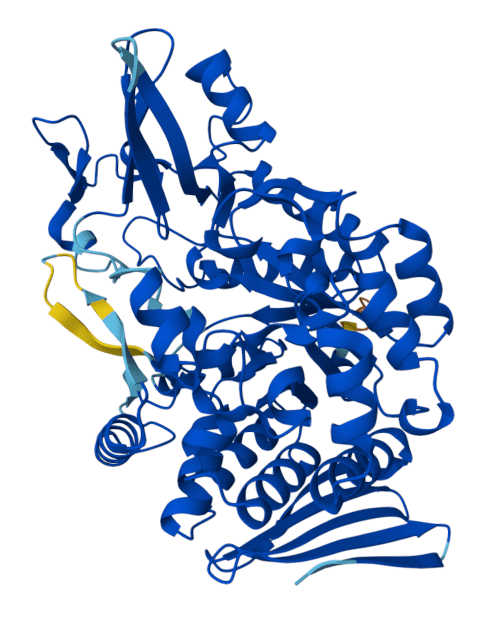
- Description: Sucrose 6F-Phosphate Phosphatase (SPP); not the be confused with sucrose phosphorylase [EC 2.4.1.7], catalyzes the reversible phosphorolysis and strict specificity for sucrose 6F-phosphate into α-D-glucose 1-phosphate and D-fructose 6-phosphate. The enzyme may be involved in a new pathway for the degradation of sucrose, which could become phosphorylated on its fructose moiety during uptake via a phosphotransferase system. SPP has been isolated from the thermophilic bacterium Thermoanaerobacterium thermosaccharolyticum, and the marine sand bacterium Ilumatobacter coccineus.
- Synonyms: Sucrose 6′-Phosphate Phosphorylase; SPP
- Reaction: Phosphate + Sucrose 6F-Phosphate = α-D-Glucose 1-Phosphate + β-D-Fructose 6-Phosphate
- Unit Definition: One unit will form 1.0 μmole of Sucrose 6F-Phosphate per min at pH 7.5 and 30 oC.
- Chemical Purity: ≥ 90% (SDS-PAGE)
- Form: 1X PBS Buffer, pH 7.5; 50% Glycerol
- Storage: ≤ -20 oC; Avoid Freeze-Thaw Cycles
| Product Number | Description - Stable Isotope Position | Availability | Unit Size | Price |
|---|---|---|---|---|
| M5A566-1 | I. coccineus supP [EC 2.4.1.329]; ≥ 50 units/mg protein; Recombinant from E. coli | 30-Day Lead Time | 1 mg | Quote |
| Custom Expression | (Please Explore our Custom Expression Options for Insperation) | Variable Lead Times | TBD | Quote |
* Stable isotope labeled proteins are exclusively marketed & sold through Cambridge Isotope Laboratories (CIL).
Sucrose-Phosphate Synthase
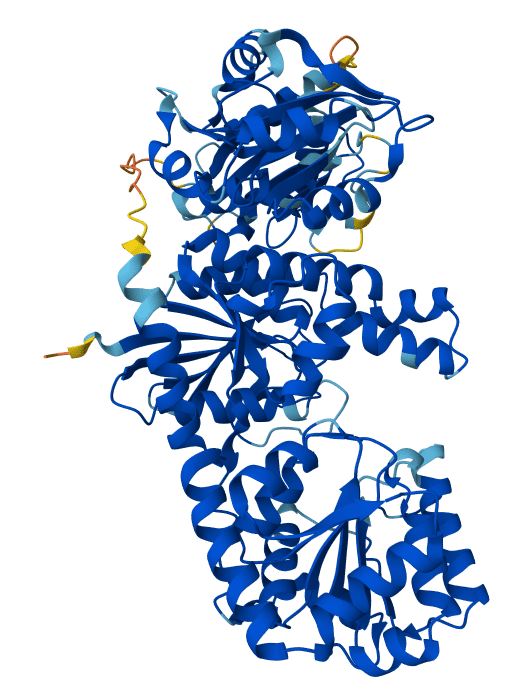
- Description: Sucrose-Phosphate Synthase (SpSy) is a plant enzyme involved in sucrose biosynthesis. This enzyme catalyzes the transfer of a glucose from uridine diphosphate glucose (UDP-glucose) to D-fructose 6-phosphate to form UDP and D-sucrose-6-phosphate. This reversible step acts as the key regulatory control point in sucrose biosynthesis, and is an excellent example of various key enzyme regulation strategies such as allosteric control and reversible phosphorylation. SpSy participates in starch and sucrose metabolism, playing a major role in partitioning carbon between sucrose and starch in photosynthetic and non-photosynthetic tissues, affecting the growth and development of the plant. Additionally, SpSy is also active in cells that mostly degrade sucrose, participating in futile cycles that allow for large, rapid changes in sucrose flux.
- Synonyms: Sucrosephosphate-UDP Glucosyltransferase; UDP-Glucose-Fructose-Phosphate Glucosyltransferase
- Reaction: β-D-Fructose 6-Phosphate + UDP-α-D-Glucose = Sucrose 6F-Phosphate + UDP + H+
- Unit Definition: One unit will form 1.0 μmole of Sucrose 6F-Phosphate per min at pH 7.5 and 30 oC.
- Chemical Purity: ≥ 90% (SDS-PAGE)
- Form: 1X PBS Buffer, pH 7.5; 50% Glycerol
- Storage: ≤ -20 oC; Avoid Freeze-Thaw Cycles
| Product Number | Description - Stable Isotope Position | Availability | Unit Size | Price |
|---|---|---|---|---|
| Q55440-1 | Synechocystis sp. strain PCC 6803 spsA [EC 2.4.1.14]; ≥ 10 units/mg protein; Recombinant from E. coli | 30-Day Lead Time | 1 mg | Quote |
| Custom Expression | (Please Explore our Custom Expression Options for Insperation) | Variable Lead Times | TBD | Quote |
* Stable isotope labeled proteins are exclusively marketed & sold through Cambridge Isotope Laboratories (CIL).
Sucrose Synthase
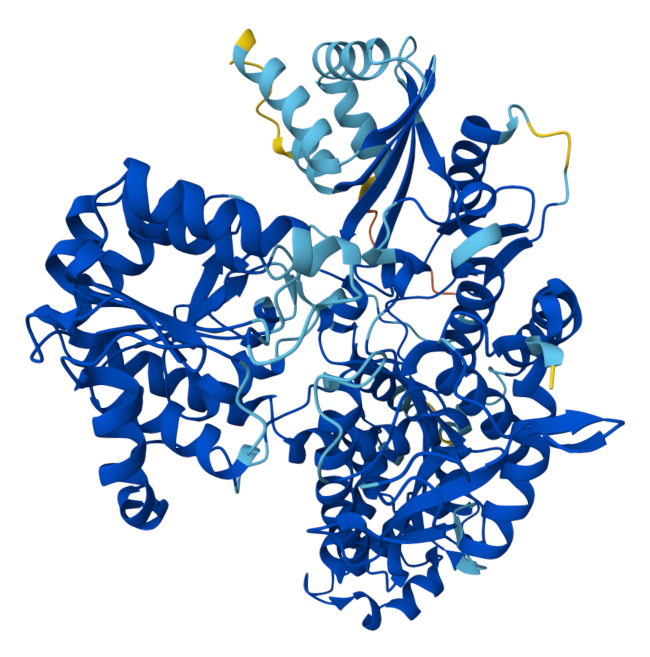
- Description: Sucrose Synthase (SuSy) is a glycosyl transferase enzyme that plays a key role in sugar metabolism, primarily in plant sink tissues. SuSy catalyzes the reversible cleavage of sucrose into fructose and either uridine diphosphate glucose (UDP-Glc). Sucrose is the end product of photosynthesis and the primary sugar transported in the phloem of most plants, and cleavage of sucrose by SuSy makes UDP-Glc available for many metabolic pathways, such as the synthesis of complex carbohydrates.
- Synonyms: Sucrose Synthetase; Sucrose-UDP Glucosyltransferase; SuSy
- Reaction: NDP-α-D-Glucose + D-Fructose = NDP + Sucrose + H+
- Unit Definition: One unit will form 1.0 μmole of sucrose per min at pH 7.5 and 30 oC.
- Chemical Purity: ≥ 90% (SDS-PAGE)
- Form: 1X PBS Buffer, pH 7.5; 50% Glycerol
- Storage: ≤ -20 oC; Avoid Freeze-Thaw Cycles
| Product Number | Description - Stable Isotope Position | Availability | Unit Size | Price |
|---|---|---|---|---|
| P10691-1 | S. tuberosum susA [EC 2.4.1.13]; ≥ 5 units/mg protein; Recombinant from E. coli | 30-Day Lead Time | 1 mg | Quote |
| Custom Expression | (Please Explore our Custom Expression Options for Insperation) | Variable Lead Times | TBD | Quote |
* Stable isotope labeled proteins are exclusively marketed & sold through Cambridge Isotope Laboratories (CIL).
Fucosylgalactoside α-(1,3)-N-Acetylgalactosaminyltransferase [EC 2.4.1.40]
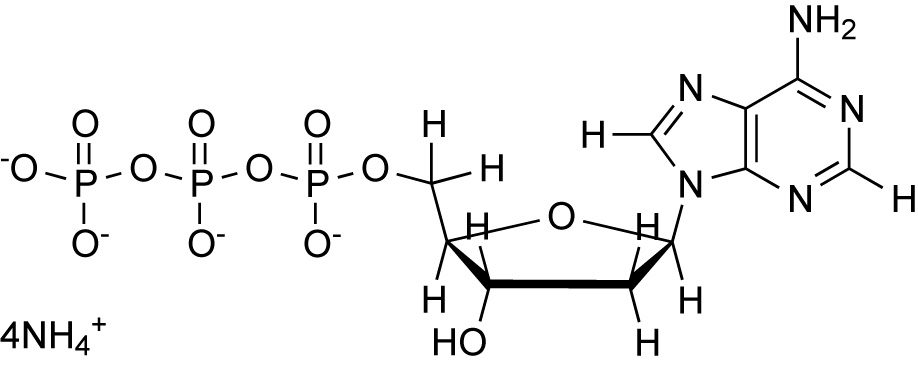
- Synonyms: 2′-Deoxy-ATP; dATP
- CAS: 1927-31-7 (Natural Abundance; Free Acid)
- Empirical Formula: C10H28N9O12P3
- Molecular Weight: 559.31
- Exact Mass: 489.9936 [C10H16N5O12P3 – H]–
- Salt Form: Ammonium
- Chemical Purity: ≥ 95% (HPLC)
- Unit Size: 0.1 mmole (100 mM) in H2O, pH 7.5
- Storage: ≤ -20 oC; Avoid Freeze-Thaw Cycles
- Note: Untested in PCR or Transcription
| Product Number | Description - Stable Isotope Position | Availability | Unit Size | Price |
|---|---|---|---|---|
| D3UIY4-1 | (Natural Abundance) | 30-Day Lead Time | 0.1 mmole | $675.00 |
| Custom Synthesis | (Please Explore our Custom Synthesis Options for Insperation) | Variable Lead Times | 1.0+ mmole | Quote |
* Stable isotope labeled nucleotides are exclusively marketed & sold through Cambridge Isotope Laboratories (CIL).
N-Acetyllactosaminide α-(1,3)-Galactosyltransferase [EC 2.4.1.87]
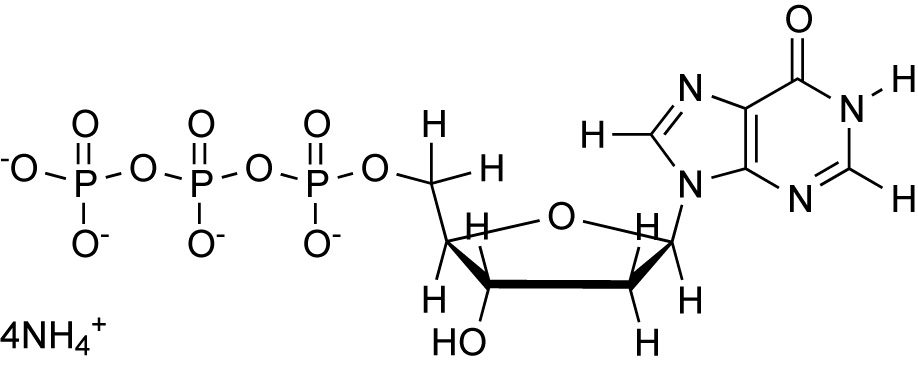
- Synonyms: 2′-Deoxy-ITP; dITP
- CAS: 16595-02-1 (Natural Abundance; Free Acid)
- Empirical Formula: C10H27N8O13P3
- Molecular Weight: 560.29
- Exact Mass: 490.9776 [C10H15N4O13P3 – H]–
- Salt Form: Ammonium
- Chemical Purity: ≥ 95% (HPLC)
- Unit Size: 0.1 mmole (100 mM) in H2O, pH 7.5
- Storage: ≤ -20 oC; Avoid Freeze-Thaw Cycles
- Note: Untested in PCR or Transcription
| Product Number | Description - Stable Isotope Position | Availability | Unit Size | Price |
|---|---|---|---|---|
| P14769-1 | (Natural Abundance) | 30-Day Lead Time | 0.1 mmole | $675.00 |
| Custom Synthesis | (Please Explore our Custom Synthesis Options for Insperation) | Variable Lead Times | 1.0+ mmole | Quote |
* Stable isotope labeled nucleotides are exclusively marketed & sold through Cambridge Isotope Laboratories (CIL).
Fucosylgalactoside α-(1,3)-Galactosyltransferase [EC 2.4.1.309]

- Synonyms: 2′-Deoxy-ITP; dITP
- CAS: 16595-02-1 (Natural Abundance; Free Acid)
- Empirical Formula: C10H27N8O13P3
- Molecular Weight: 560.29
- Exact Mass: 490.9776 [C10H15N4O13P3 – H]–
- Salt Form: Ammonium
- Chemical Purity: ≥ 95% (HPLC)
- Unit Size: 0.1 mmole (100 mM) in H2O, pH 7.5
- Storage: ≤ -20 oC; Avoid Freeze-Thaw Cycles
- Note: Untested in PCR or Transcription
| Product Number | Description - Stable Isotope Position | Availability | Unit Size | Price |
|---|---|---|---|---|
| Q5JBG6-1 | (Natural Abundance) | 30-Day Lead Time | 0.1 mmole | $675.00 |
| Custom Synthesis | (Please Explore our Custom Synthesis Options for Insperation) | Variable Lead Times | 1.0+ mmole | Quote |
* Stable isotope labeled nucleotides are exclusively marketed & sold through Cambridge Isotope Laboratories (CIL).
N-Acetyl-β-D-glucosaminide β-(1,3)-Galactosyltransferase [EC 2.4.1.86]

- Synonyms: 2′-Deoxy-ITP; dITP
- CAS: 16595-02-1 (Natural Abundance; Free Acid)
- Empirical Formula: C10H27N8O13P3
- Molecular Weight: 560.29
- Exact Mass: 490.9776 [C10H15N4O13P3 – H]–
- Salt Form: Ammonium
- Chemical Purity: ≥ 95% (HPLC)
- Unit Size: 0.1 mmole (100 mM) in H2O, pH 7.5
- Storage: ≤ -20 oC; Avoid Freeze-Thaw Cycles
- Note: Untested in PCR or Transcription
| Product Number | Description - Stable Isotope Position | Availability | Unit Size | Price |
|---|---|---|---|---|
| B1B4J9-1 | (Natural Abundance) | 30-Day Lead Time | 0.1 mmole | $675.00 |
| Custom Synthesis | (Please Explore our Custom Synthesis Options for Insperation) | Variable Lead Times | 1.0+ mmole | Quote |
* Stable isotope labeled nucleotides are exclusively marketed & sold through Cambridge Isotope Laboratories (CIL).
Galactoside β-(1,3)-N-Acetylglucosaminyltransferase [EC 2.4.1.149]

- Synonyms: 2′-Deoxy-ITP; dITP
- CAS: 16595-02-1 (Natural Abundance; Free Acid)
- Empirical Formula: C10H27N8O13P3
- Molecular Weight: 560.29
- Exact Mass: 490.9776 [C10H15N4O13P3 – H]–
- Salt Form: Ammonium
- Chemical Purity: ≥ 95% (HPLC)
- Unit Size: 0.1 mmole (100 mM) in H2O, pH 7.5
- Storage: ≤ -20 oC; Avoid Freeze-Thaw Cycles
- Note: Untested in PCR or Transcription
| Product Number | Description - Stable Isotope Position | Availability | Unit Size | Price |
|---|---|---|---|---|
| dITP | (Natural Abundance) | 30-Day Lead Time | 0.1 mmole | $675.00 |
| Custom Synthesis | (Please Explore our Custom Synthesis Options for Insperation) | Variable Lead Times | 1.0+ mmole | Quote |
* Stable isotope labeled nucleotides are exclusively marketed & sold through Cambridge Isotope Laboratories (CIL).
β-Galactoside α-2,3-Sialyltransferase [EC 2.4.3.4]

- Synonyms: 2′-Deoxy-ITP; dITP
- CAS: 16595-02-1 (Natural Abundance; Free Acid)
- Empirical Formula: C10H27N8O13P3
- Molecular Weight: 560.29
- Exact Mass: 490.9776 [C10H15N4O13P3 – H]–
- Salt Form: Ammonium
- Chemical Purity: ≥ 95% (HPLC)
- Unit Size: 0.1 mmole (100 mM) in H2O, pH 7.5
- Storage: ≤ -20 oC; Avoid Freeze-Thaw Cycles
- Note: Untested in PCR or Transcription
| Product Number | Description - Stable Isotope Position | Availability | Unit Size | Price |
|---|---|---|---|---|
| K0Z1D9-1 | (Natural Abundance) | 30-Day Lead Time | 0.1 mmole | $675.00 |
| Custom Synthesis | (Please Explore our Custom Synthesis Options for Insperation) | Variable Lead Times | 1.0+ mmole | Quote |
* Stable isotope labeled nucleotides are exclusively marketed & sold through Cambridge Isotope Laboratories (CIL).
β-Galactoside α-2,6-Sialyltransferase [EC 2.4.3.1]

- Synonyms: 2′-Deoxy-ITP; dITP
- CAS: 16595-02-1 (Natural Abundance; Free Acid)
- Empirical Formula: C10H27N8O13P3
- Molecular Weight: 560.29
- Exact Mass: 490.9776 [C10H15N4O13P3 – H]–
- Salt Form: Ammonium
- Chemical Purity: ≥ 95% (HPLC)
- Unit Size: 0.1 mmole (100 mM) in H2O, pH 7.5
- Storage: ≤ -20 oC; Avoid Freeze-Thaw Cycles
- Note: Untested in PCR or Transcription
| Product Number | Description - Stable Isotope Position | Availability | Unit Size | Price |
|---|---|---|---|---|
| O66375-1 | (Natural Abundance) | 30-Day Lead Time | 0.1 mmole | $675.00 |
| K0Z1D9-2 | (Natural Abundance) | 30-Day Lead Time | 0.1 mmole | $675.00 |
| Custom Synthesis | (Please Explore our Custom Synthesis Options for Insperation) | Variable Lead Times | 1.0+ mmole | Quote |
* Stable isotope labeled nucleotides are exclusively marketed & sold through Cambridge Isotope Laboratories (CIL).
α-N-acetylgalactosaminide α-2,6-Sialyltransferase [EC 2.4.3.3]

- Synonyms: 2′-Deoxy-ITP; dITP
- CAS: 16595-02-1 (Natural Abundance; Free Acid)
- Empirical Formula: C10H27N8O13P3
- Molecular Weight: 560.29
- Exact Mass: 490.9776 [C10H15N4O13P3 – H]–
- Salt Form: Ammonium
- Chemical Purity: ≥ 95% (HPLC)
- Unit Size: 0.1 mmole (100 mM) in H2O, pH 7.5
- Storage: ≤ -20 oC; Avoid Freeze-Thaw Cycles
- Note: Untested in PCR or Transcription
| Product Number | Description - Stable Isotope Position | Availability | Unit Size | Price |
|---|---|---|---|---|
| O66375-2 | (Natural Abundance) | 30-Day Lead Time | 0.1 mmole | $675.00 |
| Custom Synthesis | (Please Explore our Custom Synthesis Options for Insperation) | Variable Lead Times | 1.0+ mmole | Quote |
* Stable isotope labeled nucleotides are exclusively marketed & sold through Cambridge Isotope Laboratories (CIL).
Hydrolases
Template
- Description: Add Description Here.
- Synonyms: Name #1; Name #2; Nrame #3
- Reaction: Reactent = Product
- Unit Definition: One unit will interconvert 1.0 μmole of X to Y per min at pH 7.5 and 30 oC.
- Chemical Purity: ≥ 90% (SDS-PAGE)
- Form: 1X PBS Buffer, pH 7.5; 50% Glycerol
- Storage: ≤ -20 oC; Avoid Freeze-Thaw Cycles
| Product Number | Description - Stable Isotope Position | Availability | Unit Size | Price |
|---|---|---|---|---|
| UNIPROT-1 | G. species ABC [EC #.#.#.#]; ≥ 1 units/mg protein; Recombinant from E. coli | 30-Day Lead Time | 1 mg | Quote |
| Custom Expression | (Please Explore our Custom Expression Options for Insperation) | Variable Lead Times | TBD | Quote |
* Stable isotope labeled proteins are exclusively marketed & sold through Cambridge Isotope Laboratories (CIL).
Acid Phosphatase
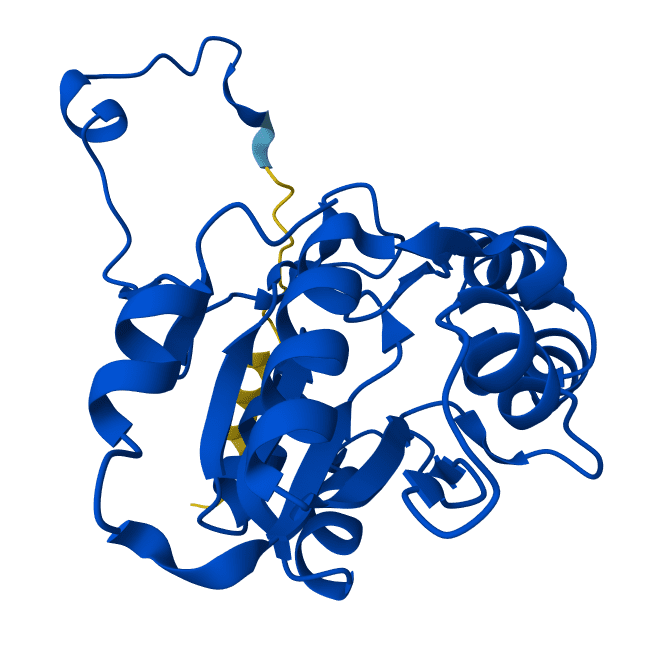
- Description: Acid Phosphatase (APase) non-specifically catalyzes the hydrolysis of monoesters and anhydrides of phosphoric acids; such as 5′-nucleotides and O-phospho-L-amino acids, to produce inorganic phosphate. It is used to study the production, transport, and recycling of phosphate and the metabolic and energy transduction processes of the cell.
- Synonyms: Phosphomonoesterase; Glycerophosphatase
- Reaction: Phosphate Monoester + H2O = Alcohol + Phosphate
- Unit Definition: One unit will hydrolyze 1.0 μmole of p-nitrophenylphosphate per min at pH 4.8 and 37 oC.
- Chemical Purity: ≥ 90% (SDS-PAGE)
- Form: 1X PBS Buffer, pH 7.5; 50% Glycerol
- Storage: ≤ -20 oC; Avoid Freeze-Thaw Cycles
| Product Number | Description - Stable Isotope Position | Availability | Unit Size | Price |
|---|---|---|---|---|
| Q9SE00 | I. batatas APase [EC 3.1.3.2]; ≥ 10 units/mg protein; from Sweet Potato | 30-Day Lead Time | 1 mg | Quote |
| Q6J5M7 | S. tuberosum APase [EC 3.1.3.2]; ≥ 5 units/mg protein; from Potato | 30-Day Lead Time | 1 mg | Quote |
| F6MIW5 | T. aestivum APase [EC 3.1.3.2]; ≥ 0.5 units/mg protein; from Wheat Germ | 30-Day Lead Time | 1 mg | Quote |
| Custom Expression | (Please Explore our Custom Expression Options for Insperation) | Variable Lead Times | TBD | Quote |
* Stable isotope labeled proteins are exclusively marketed & sold through Cambridge Isotope Laboratories (CIL).
Alkaline Phosphatase

- Description: Acid Phosphatase (ALPase) non-specifically catalyzes the hydrolysis of a broad range of monoesters and anhydrides of phosphoric acids; such as 5′-nucleotides and DNA/RNA, to produce inorganic phosphate. It is used to study the production, transport, and recycling of phosphate and the metabolic and energy transduction processes of the cell.
- Synonyms: Phosphomonoesterase; Glycerophosphatase
- Reaction: Phosphate Monoester + H2O = Alcohol + Phosphate
- Unit Definition: One unit will hydrolyze 1.0 μmole of p-nitrophenylphosphate per min at pH 9.8 and 37 oC.
- Chemical Purity: ≥ 90% (SDS-PAGE)
- Form: 1X PBS Buffer, pH 7.5; 50% Glycerol
- Storage: ≤ -20 oC; Avoid Freeze-Thaw Cycles
| Product Number | Description - Stable Isotope Position | Availability | Unit Size | Price |
|---|---|---|---|---|
| P19111 | B. taurus APLI [EC 3.1.3.1]; ≥ 5000 units/mg protein; from Calf Intestine | 30-Day Lead Time | 1 mg | Quote |
| Custom Expression | (Please Explore our Custom Expression Options for Insperation) | Variable Lead Times | TBD | Quote |
* Stable isotope labeled proteins are exclusively marketed & sold through Cambridge Isotope Laboratories (CIL).
Glucosamine-6-Phosphate Deaminase

- Description: Glucosamine-6-Phosphate Deaminase (GNPD) belongs to the family of hydrolases, acting on carbon-nitrogen bonds other than peptide bonds. GNPD participates in aminosugars metabolism, using a ring opening and isomerization mechanism of the aldose-ketose type to convert the -CH(-NH2)-CH=O group of glucosamine 6-phosphate into -C(=NH)-CH2-OH, forming 2-deoxy-2-imino-D-arabino-hexitol, which in turn hydrolyses to yield fructose 6-phosphate and ammonia. N-Acetyl-D-glucosamine 6-phosphate is a known effector.
- Synonyms: Glucosamine-6-Phosphate Isomerase; Glucosamine Phosphate Deaminase; GNPI
- Reaction: α-D-Glucosamine 6-Phosphate + H2O = β-D-Fructose 6-Phosphate + NH4+
- Unit Definition: One unit will interconvert 1.0 μmole of glucosamine-6-Phosphate and fructose 6-phosphate per min at pH 7.5 and 30 oC.
- Chemical Purity: ≥ 90% (SDS-PAGE)
- Form: 1X PBS Buffer, pH 7.5; 50% Glycerol
- Storage: ≤ -20 oC; Avoid Freeze-Thaw Cycles
| Product Number | Description - Stable Isotope Position | Availability | Unit Size | Price |
|---|---|---|---|---|
| O97439-1 | G. intestinalis nagB [EC 3.5.99.6]; ≥ 30 units/mg protein; Recombinant from E. coli | 30-Day Lead Time | 1 mg | Quote |
| Custom Expression | (Please Explore our Custom Expression Options for Insperation) | Variable Lead Times | TBD | Quote |
* Stable isotope labeled proteins are exclusively marketed & sold through Cambridge Isotope Laboratories (CIL).
Inorganic Diphosphatase
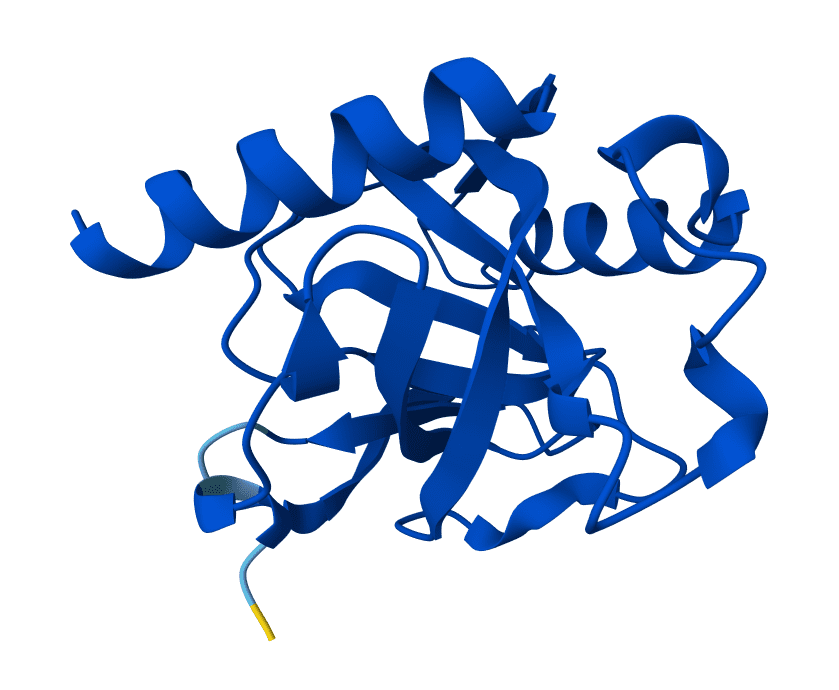
- Description: Inorganic Diphosphatase (IPPase) plays a critical role in a variety of biochemical transformations. It is also a highly exergonic reaction, and therefore can be coupled to unfavorable biochemical transformations in order to drive these transformations to completion.
- Synonyms: Inorganic Pyrophosphatase; Diphosphate Phosphohydrolase
- Reaction: Diphosphate + H2O = 2 Phosphate
- Unit Definition: One unit will hydrolyze 1.0 μmole of Diphosphate per min at pH 9.0 and 25 oC.
- Chemical Purity: ≥ 90% (SDS-PAGE)
- Form: 1X PBS Buffer, pH 7.5; 50% Glycerol
- Storage: ≤ -20 oC; Avoid Freeze-Thaw Cycles
| Product Number | Description - Stable Isotope Position | Availability | Unit Size | Price |
|---|---|---|---|---|
| P0A7A9-1 | E. coli IPPase [EC 3.6.1.1]; ≥ 450 units/mg protein; Recombinant from E. coli | 30-Day Lead Time | 1 mg | Quote |
| Custom Expression | (Please Explore our Custom Expression Options for Insperation) | Variable Lead Times | TBD | Quote |
* Stable isotope labeled proteins are exclusively marketed & sold through Cambridge Isotope Laboratories (CIL).
Sucrose-Phosphate Phosphatase
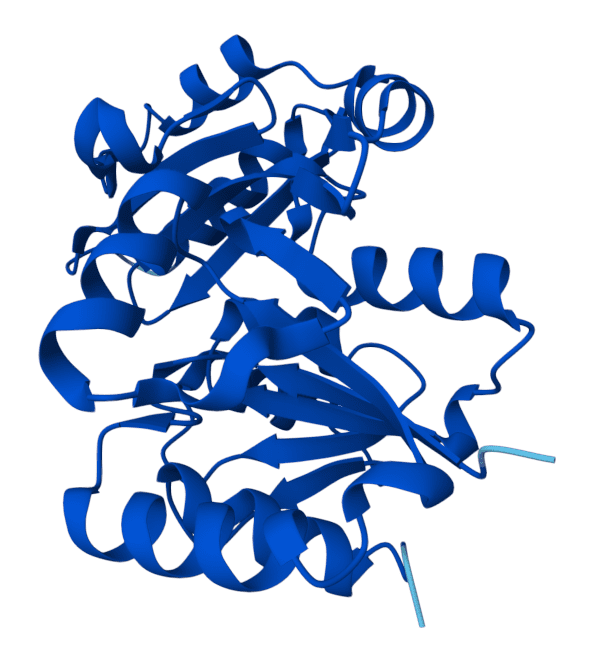
- Description: Sucrose-Phosphate Phosphatase (SPP) is a plant enzyme involved in the final step in the sucrose-biosynthesis pathway, catalyzing the irreversible hydrolysis of phosphate from D-sucrose-6F-phosphate. SPP is highly specific for sucrose 6F-phosphate, with fructose 6-phosphate unable to act as a substrate. SPP is active in cells that mostly degrade sucrose and other soluble sugars, participating in futile cycles that allow for rapid changes in sucrose flux, affecting the growth, development, and energy storage of the plant.
- Synonyms: Sucrose-6-Phosphate Phosphatase; Sucrose Phosphatase; SPP
- Reaction: H2O + Sucrose 6F-Phosphate = Phosphate + Sucrose
- Unit Definition: One unit will hydrolyze 1.0 μmole of Sucrose 6F-Phosphate per min at pH 7.5 and 30 oC.
- Chemical Purity: ≥ 90% (SDS-PAGE)
- Form: 1X PBS Buffer, pH 7.5; 50% Glycerol
- Storage: ≤ -20 oC; Avoid Freeze-Thaw Cycles
| Product Number | Description - Stable Isotope Position | Availability | Unit Size | Price |
|---|---|---|---|---|
| P74325-1 | Synechocystis sp. strain PCC 6803 sppA [EC 3.1.3.24]; ≥ 50 units/mg protein; Recombinant from E. coli | 30-Day Lead Time | 1 mg | Quote |
| Custom Expression | (Please Explore our Custom Expression Options for Insperation) | Variable Lead Times | TBD | Quote |
* Stable isotope labeled proteins are exclusively marketed & sold through Cambridge Isotope Laboratories (CIL).
Isomerases
Template
- Description: Add Description Here.
- Synonyms: Name #1; Name #2; Nrame #3
- Reaction: Reactent = Product
- Unit Definition: One unit will interconvert 1.0 μmole of X to Y per min at pH 7.5 and 30 oC.
- Chemical Purity: ≥ 90% (SDS-PAGE)
- Form: 1X PBS Buffer, pH 7.5; 50% Glycerol
- Storage: ≤ -20 oC; Avoid Freeze-Thaw Cycles
| Product Number | Description - Stable Isotope Position | Availability | Unit Size | Price |
|---|---|---|---|---|
| UNIPROT-1 | G. species ABC [EC #.#.#.#]; ≥ 1 units/mg protein; Recombinant from E. coli | 30-Day Lead Time | 1 mg | Quote |
| Custom Expression | (Please Explore our Custom Expression Options for Insperation) | Variable Lead Times | TBD | Quote |
* Stable isotope labeled proteins are exclusively marketed & sold through Cambridge Isotope Laboratories (CIL).
Glucose-6-Phosphate Isomerase
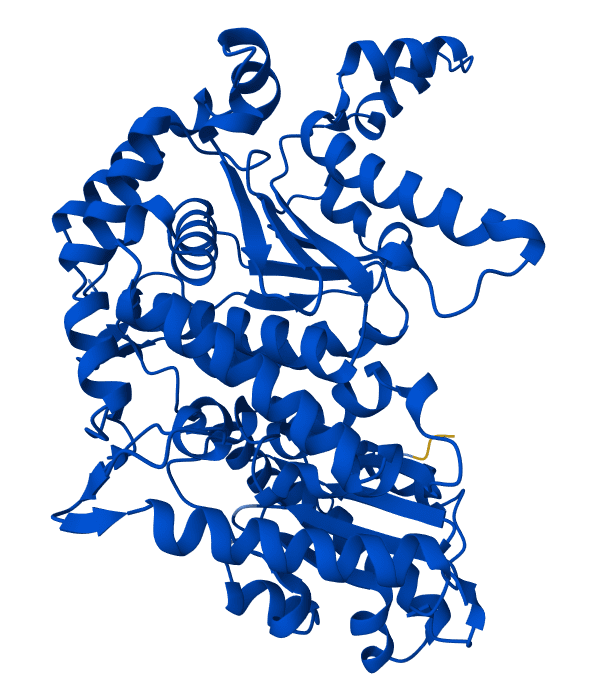
- Description: Glucose-6-Phosphate Isomerase (PGI) is responsible for steps in both glycolysis and glucogenesis, crucial for the interconversion of D-glucose 6-phosphate and D-fructose 6-phosphate. PGI is highly conserved in bacteria through eukaryotes. Autosomal recessive genetic GPI deficiency is the second most frequent erythroenzymopathy in glycolysis, being associated with non-spherocytic haemolytic anaemia and neurological impairment. Mammalian GPI also functions as a tumor-secreted cytokine and an angiogenic factor (AMF) which stimulates endothelial cell motility.
- Synonyms: Phosphoglucoisomerase; Glucose-6-Phosphate Ketol-Isomerase; GPI
- Reaction: Glucose-6-Phosphate = Fructose-6-Phosphate
- Unit Definition: One unit will interconvert 1.0 μmole of G6P to F6P per min at pH 7.5 and 25 oC.
- Chemical Purity: ≥ 90% (SDS-PAGE)
- Form: 1X PBS Buffer, pH 7.5; 50% Glycerol
- Storage: ≤ -20 oC; Avoid Freeze-Thaw Cycles
| Product Number | Description - Stable Isotope Position | Availability | Unit Size | Price |
|---|---|---|---|---|
| P13375-1 | B. stearothermophilus PGI [EC 5.3.1.9]; ≥ 500 units/mg protein; Recombinant from E. coli | 30-Day Lead Time | 1 mg | Quote |
| P06744-1 | H. sapiens PGI [EC 5.3.1.9]; ≥ 200 units/mg protein; Recombinant from E. coli | 30-Day Lead Time | 1 mg | Quote |
| Q9N1E2 | O. cuniculus PGI [EC 5.3.1.9]; ≥ 200 units/mg protein; from Rabbit Muscle | 30-Day Lead Time | 1 mg | Quote |
| P12709 | S. cerevisiae PGI [EC 5.3.1.9]; ≥ 400 units/mg protein; from Baker's Yeast | 30-Day Lead Time | 1 mg | Quote |
| Custom Expression | (Please Explore our Custom Expression Options for Insperation) | Variable Lead Times | TBD | Quote |
* Stable isotope labeled proteins are exclusively marketed & sold through Cambridge Isotope Laboratories (CIL).
Ribose-5-Phosphate Isomerase

- Description: Ribose-5-Phosphate Isomerase (RPI) is a member of a larger class of isomerases which plays a vital role in biochemical metabolism in both the pentose phosphate pathway and the Calvin cycle. Due to its central metabolic role, RPI is highly conserved in most bacteria, plants, and animals. RPI isessential to the pathogenesis of the malaria parasite Plasmodium falciparum, as well as, regulating cell proliferation and colony formation in human hepatocellular carcinoma.
- Synonyms: D-Ribose-5-Phosphate Ketol-Isomerase; Phosphoriboisomerase; RPI
- Reaction: Ribose-5-Phosphate = Ribulose-5-Phosphate
- Unit Definition: One unit will interconvert 1.0 μmole of R5P to Ru5P per min at pH 7.5 and 30 oC.
- Chemical Purity: ≥ 90% (SDS-PAGE)
- Form: 1X PBS Buffer, pH 7.5; 50% Glycerol
- Storage: ≤ -20 oC; Avoid Freeze-Thaw Cycles
| Product Number | Description - Stable Isotope Position | Availability | Unit Size | Price |
|---|---|---|---|---|
| P0A7Z0-1 | E. coli RPI [EC 5.3.1.6]; ≥ 50 units/mg protein; Recombinant from E. coli | In Pipeline | - | - |
| Q8RU73 | S. oleracea RPI [EC 5.3.1.6]; ≥ 40 units/mg protein; from Spinach | 30-Day Lead Time | 1 mg | Quote |
| Q8RU73-1 | S. oleracea RPI [EC 5.3.1.6]; ≥ 40 units/mg protein; Recombinant from E. coli | In Pipeline | - | - |
| Custom Expression | (Please Explore our Custom Expression Options for Insperation) | Variable Lead Times | TBD | Quote |
* Stable isotope labeled proteins are exclusively marketed & sold through Cambridge Isotope Laboratories (CIL).
Kinases
Template
- Description: Add Description Here.
- Synonyms: Name #1; Name #2; Nrame #3
- Reaction: Reactent = Product
- Unit Definition: One unit will interconvert 1.0 μmole of X to Y per min at pH 7.5 and 30 oC.
- Chemical Purity: ≥ 90% (SDS-PAGE)
- Form: 1X PBS Buffer, pH 7.5; 50% Glycerol
- Storage: ≤ -20 oC; Avoid Freeze-Thaw Cycles
| Product Number | Description - Stable Isotope Position | Availability | Unit Size | Price |
|---|---|---|---|---|
| UNIPROT-1 | G. species ABC [EC #.#.#.#]; ≥ 1 units/mg protein; Recombinant from E. coli | 30-Day Lead Time | 1 mg | Quote |
| Custom Expression | (Please Explore our Custom Expression Options for Insperation) | Variable Lead Times | TBD | Quote |
* Stable isotope labeled proteins are exclusively marketed & sold through Cambridge Isotope Laboratories (CIL).
Acetate Kinase
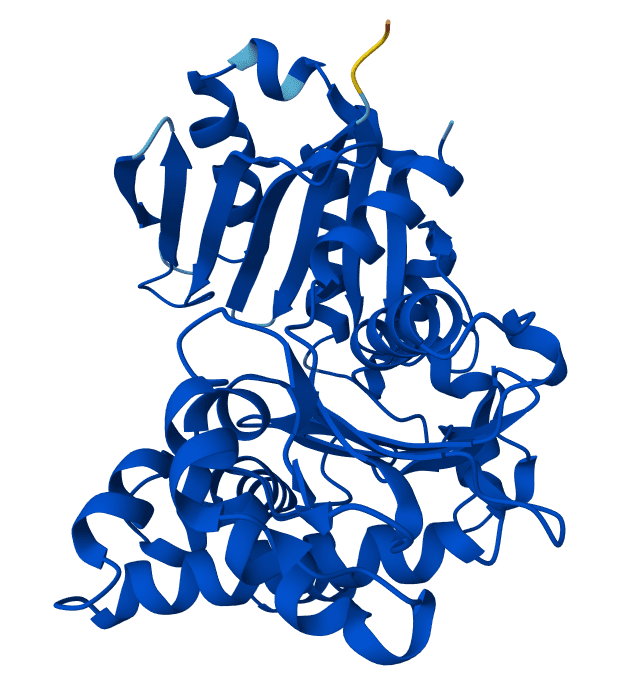
- Description: Acetate Kinase (AK); which is predominantly found in micro-organisms, facilitates the production of acetyl-CoA by phosphorylating acetate in the presence of ATP and a divalent cation. Short-chain fatty acids play a major role in carbon cycle and can be utilized as a source of carbon and energy in bacteria. AK is important in the processes of glycolysis, and the metabolism of propanoate, pyruvate and taurine. Acetate Kinase has been used as part of an ATP-regenerating system to study the kinetics of agonist-stimulated transphosphatidylation, and the enzymatic synthesis of nucleotides.
- Synonyms: Acetate Kinase (Phosphorylating); Acetic Kinase; Acetokinase; AK
- Reaction: Acetate + ATP = Acetyl-Phosphate + ADP
- Unit Definition: One unit will phosphorylate 1.0 μmole of acetate to acetyl-phosphate per min at pH 7.6 and 25 oC.
- Chemical Purity: ≥ 90% (SDS-PAGE)
- Form: 1X PBS Buffer, pH 7.5; 50% Glycerol
- Storage: ≤ -20 oC; Avoid Freeze-Thaw Cycles
| Product Number | Description - Stable Isotope Position | Availability | Unit Size | Price |
|---|---|---|---|---|
| P76556-1 | E. coli AK [EC 2.7.2.1]; ≥ 150 units/mg protein; Recombinant from E. coli | 30-Day Lead Time | 1 mg | Quote |
| P63411-1 | S. typhimurium AK [EC 2.7.2.1]; ≥ 150 units/mg protein; Recombinant from E. coli | 30-Day Lead Time | 1 mg | Quote |
| Custom Expression | (Please Explore our Custom Expression Options for Insperation) | Variable Lead Times | TBD | Quote |
* Stable isotope labeled proteins are exclusively marketed & sold through Cambridge Isotope Laboratories (CIL).
Adenylate Kinase
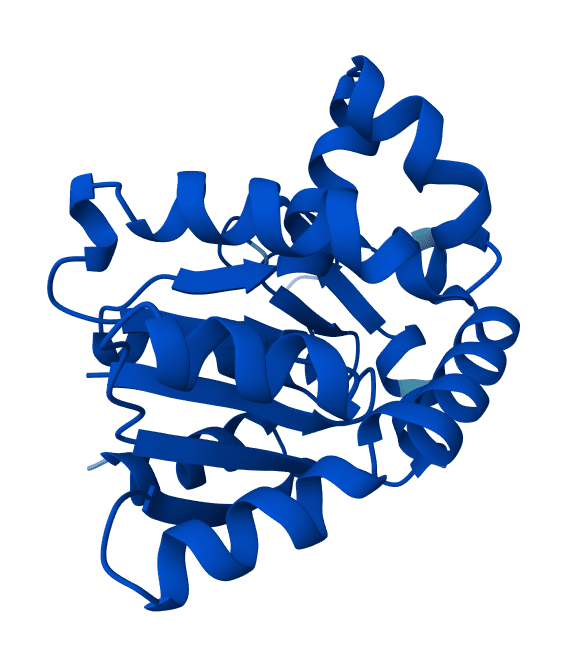
- Description: Adenylate kinase (AMPK) is a phosphotransferase enzyme that catalyzes the interconversion of the various adenosine phosphates (ATP, ADP, and AMP). By continually monitoring phosphate nucleotide levels inside the cell, AMP plays an important role in cellular energy homeostasis. Adenylate Kinase can be used as part of an ATP-regenerating system for the enzymatic synthesis of nucleotides, and ligand-binding property studies of peptide fragments.
- Synonyms: Adenylic Kinase; Adenylokinase; Myokinase; AMPK
- Reaction: (d)AMP + (d)ATP = 2 (d)ADP
- Unit Definition: One unit will convert 1.0 μmole of ATP and 1.0 μmole of AMP to 2.0 μmoles of ADP per min at pH 7.5 and 25 oC.
- Chemical Purity: ≥ 90% (SDS-PAGE)
- Form: 1X PBS Buffer, pH 7.5; 50% Glycerol
- Storage: ≤ -20 oC; Avoid Freeze-Thaw Cycles
| Product Number | Description - Stable Isotope Position | Availability | Unit Size | Price |
|---|---|---|---|---|
| P69441-1 | E. coli AMPK [EC 2.7.4.3]; ≥ 750 units/mg protein; Recombinant from E. coli | 30-Day Lead Time | 1 mg | Quote |
| P00569 | O. cuniculus AMPK [EC 2.7.4.3]; ≥ 1000 units/mg protein; from Rabbit Muscle | 30-Day Lead Time | 1 mg | Quote |
| P07170 | S. cerevisiae AMPK [EC 2.7.4.3]; ≥ 100 units/mg protein; from Baker's Yeast | 30-Day Lead Time | 1 mg | Quote |
| Custom Expression | (Please Explore our Custom Expression Options for Insperation) | Variable Lead Times | TBD | Quote |
* Stable isotope labeled proteins are exclusively marketed & sold through Cambridge Isotope Laboratories (CIL).
Creatine Kinase
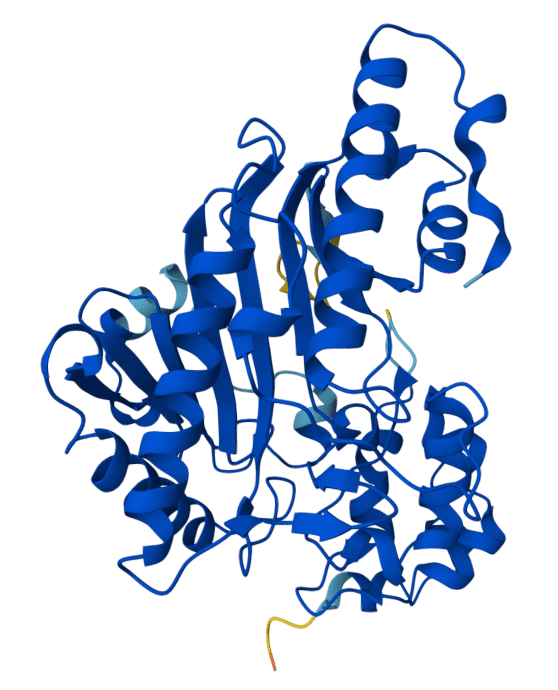
- Description: Creatine Kinase (CPK) plays a key role in the energy metabolism of cells with intermittently high and fluctuating energy requirements, by catalyzing the reversible transfer of the phosphoryl group from creatine phosphate to ADP. CPK has been used to investigate ischemic heart stimulated endothelial cell growth, the kinetic influence of bound CPK on Ca2+-activated myosin ATPase, and evaluating dietary intake of copper and selenium on metabolism. Creatine Kinase has also been used for the enzymatic hydrolysis of protein samples during tryptophan estimation by pyrolysis gas chromatography, as well as, part of an ATP-regenerating system for enzymatic the synthesis of nucleotides.
- Synonyms: Creatine Phosphokinase; Creatine Phosphotransferase; CPK
- Reaction: ATP + Creatine = ADP + H+ + N-Phosphocreatine
- Unit Definition: One unit will transfer 1.0 μmole of phosphate from phosphocreatine to ADP per min at pH 7.5 and 30 oC.
- Chemical Purity: ≥ 90% (SDS-PAGE)
- Form: 1X PBS Buffer, pH 7.5; 50% Glycerol
- Storage: ≤ -20 oC; Avoid Freeze-Thaw Cycles
| Product Number | Description - Stable Isotope Position | Availability | Unit Size | Price |
|---|---|---|---|---|
| Q5EA61 | B. taurus CPK [EC 2.7.3.2]; ≥ 30 units/mg protein; from Bovine Heart | 30-Day Lead Time | 1 mg | Quote |
| P00567 | O. cuniculus CPK [EC 2.7.3.2]; ≥ 150 units/mg protein; from Rabbit Muscle | 30-Day Lead Time | 1 mg | Quote |
| Custom Expression | (Please Explore our Custom Expression Options for Insperation) | Variable Lead Times | TBD | Quote |
* Stable isotope labeled proteins are exclusively marketed & sold through Cambridge Isotope Laboratories (CIL).
(d)CMP Kinase
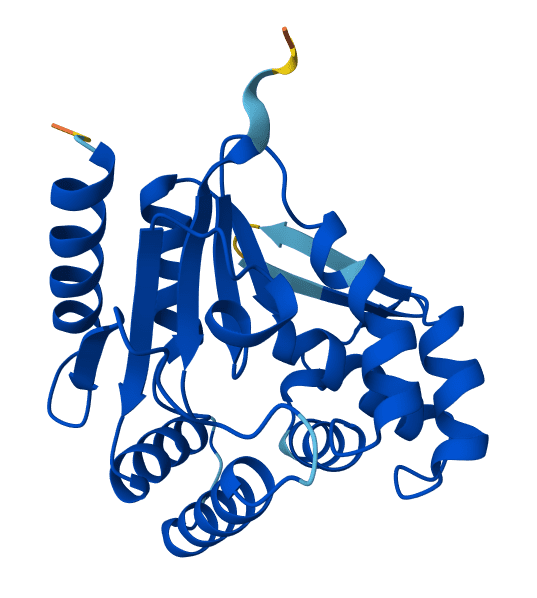
- Description: (d)CMP Kinase (CMPK) is a member of the nucleoside monophosphate (NMP) kinase family, and plays a crucial role in biosynthesis of nucleoside precursors. In bacteria, CMPK catalyses the transfer of a phosphoryl group from ATP to CMP or dCMP. This differs from the activity of eukaryotic UMP/CMP Kinases [EC 2.7.4.14], which catalyse the conversion of UMP and CMP to their respective diphosphate forms. Structurally, bacterial CMPK’s are different from other members of the NMP kinase family.
- Synonyms: CMP Kinase; Cytidylate Kinase; CMPK
- Reaction: ATP + (d)CMP = ADP + (d)CDP
- Unit Definition: One unit will convert 1.0 μmole of ATP and 1.0 μmole of CMP to 1.0 μmole of ADP and 1.0 μmole of CDP per min at pH 7.5 and 25 oC.
- Chemical Purity: ≥ 90% (SDS-PAGE)
- Form: 1X PBS Buffer, pH 7.5; 50% Glycerol
- Storage: ≤ -20 oC; Avoid Freeze-Thaw Cycles
| Product Number | Description - Stable Isotope Position | Availability | Unit Size | Price |
|---|---|---|---|---|
| P0A6I0-1 | E. coli CMPK [EC 2.7.4.25]; ≥ 100 units/mg protein; Recombinant from E. coli | 30-Day Lead Time | 1 mg | Quote |
| Custom Expression | (Please Explore our Custom Expression Options for Insperation) | Variable Lead Times | TBD | Quote |
* Stable isotope labeled proteins are exclusively marketed & sold through Cambridge Isotope Laboratories (CIL).
Deoxycytidine Kinase
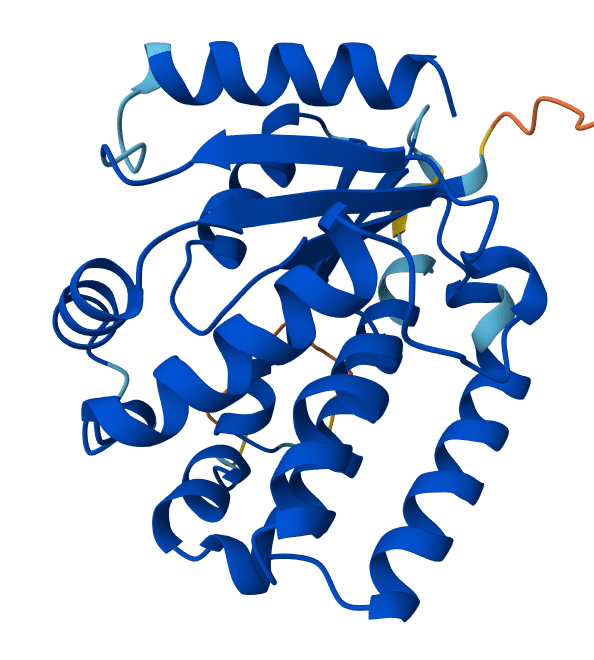
- Description: Deoxycytidine Kinase (dCK) is a key enzyme in the nucleoside salvage pathway. Specifically, dCK recycles 2′-deoxynucleosides (dN’s) from degrading DNA to re-synthesize 2′-deoxynucleotides (dNTPs). Moreover, dCK can act to produce dNTP’s in the event of downregulation in the de novo nucleotide pathway. Research has identified dCK’s as therapeutic targets, because dCK deficiency is associated with resistance to antiviral and anticancer agents, while increased activity is associated with increased sensitivity to these agents.
- Synonyms: (d)NTP:Deoxycytidine 5′-Phosphotransferase; dCK
- Reaction: 2′-Deoxycytidine + (d)NTP = (d)NDP + dCMP + H+
- Unit Definition: One unit will convert 1.0 μmole of ATP and 1.0 μmole of 2′-deoxycytidine to 1.0 μmole of ADP and 1.0 μmole of dCMP per min at pH 7.5 and 25 oC.
- Chemical Purity: ≥ 90% (SDS-PAGE)
- Form: 1X PBS Buffer, pH 7.5; 50% Glycerol
- Storage: ≤ -20 oC; Avoid Freeze-Thaw Cycles
| Product Number | Description - Stable Isotope Position | Availability | Unit Size | Price |
|---|---|---|---|---|
| P27707-1 | H. sapiens dCK [EC 2.7.1.74]; ≥ 10 units/mg protein; Recombinant from E. coli | 30-Day Lead Time | 1 mg | Quote |
| Custom Expression | (Please Explore our Custom Expression Options for Insperation) | Variable Lead Times | TBD | Quote |
* Stable isotope labeled proteins are exclusively marketed & sold through Cambridge Isotope Laboratories (CIL).
Deoxynucleoside Kinase

- Description: Deoxynucleoside Kinase (dNK) is a key enzyme in the nucleoside salvage pathway. Specifically, dNK recycles 2′-deoxynucleosides (dN’s) from degrading DNA to re-synthesize 2′-deoxynucleotides (dNTPs), as well as act to produce dNTP’s in the event of downregulation in the de novo nucleotide pathway. Research has identified dNK’s as enzymatic synthesis tools, due to their high efficiency and broad substrate specificity.
- Synonyms: Multifunctional Deoxynucleoside Kinase; Multisubstrate Deoxyribonucleoside Kinase; dNK
- Reaction: 2′-Deoxynucleoside + (d)NTP = (d)NDP + dNMP + H+
- Unit Definition: One unit will convert 1.0 μmole of ATP and 1.0 μmole of 2′-deoxynucleoside to 1.0 μmole of ADP and 1.0 μmole of dNMP per min at pH 7.5 and 25 oC.
- Chemical Purity: ≥ 90% (SDS-PAGE)
- Form: 1X PBS Buffer, pH 7.5; 50% Glycerol
- Storage: ≤ -20 oC; Avoid Freeze-Thaw Cycles
| Product Number | Description - Stable Isotope Position | Availability | Unit Size | Price |
|---|---|---|---|---|
| Q9XZT6-1 | D. melanogaster dNK [EC 2.7.1.145]; ≥ 30 units/mg protein; Recombinant from E. coli | 30-Day Lead Time | 1 mg | Quote |
| Custom Expression | (Please Explore our Custom Expression Options for Insperation) | Variable Lead Times | TBD | Quote |
* Stable isotope labeled proteins are exclusively marketed & sold through Cambridge Isotope Laboratories (CIL).
Galactokinase
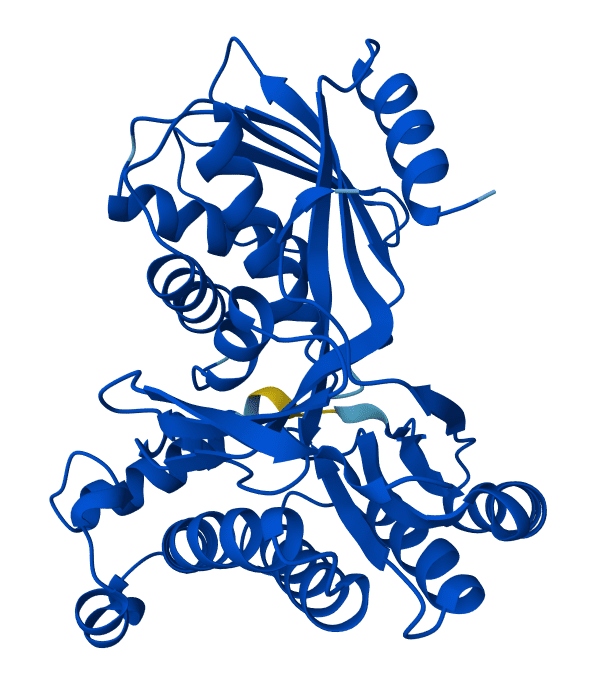
- Description: Galactokinase (galK) is an enzyme catalyzing the second step of the Leloir pathway, a metabolic pathway found in most organisms for the catabolism of D-galactose to glucose 1-phosphate. Galactokinases displays a great diversity of substrate specificities and kinetic properties across different species, and has been dramatically expanded through directed evolution and structure-based protein engineering. The corresponding broadly permissive sugar anomeric kinases serve as a cornerstone for in vitro and in vivo synthetic utility.
- Synonyms: Galactose Kinase; galK
- Reaction: D-Galactose + ATP = ADP + D-Galactose 1-Phosphate + H+
- Unit Definition: One unit will convert 1.0 μmole of D-galactose to D-galactose 1-phosphate per min at pH 7.5 and 30 oC.
- Chemical Purity: ≥ 90% (SDS-PAGE)
- Form: 1X PBS Buffer, pH 7.5; 50% Glycerol
- Storage: ≤ -20 oC; Avoid Freeze-Thaw Cycles
| Product Number | Description - Stable Isotope Position | Availability | Unit Size | Price |
|---|---|---|---|---|
| C4ZXS8-1 | E. coli galK [EC 2.7.1.6]; ≥ 20 units/mg protein; Recombinant from E. coli | 30-Day Lead Time | 1 mg | Quote |
| P51570-1 | H. sapiens galK1 [EC 2.7.1.6]; ≥ 1 unit/mg protein; Recombinant from E. coli | 30-Day Lead Time | 1 mg | Quote |
| Custom Expression | (Please Explore our Custom Expression Options for Insperation) | Variable Lead Times | TBD | Quote |
* Stable isotope labeled proteins are exclusively marketed & sold through Cambridge Isotope Laboratories (CIL).
Galacturonokinase
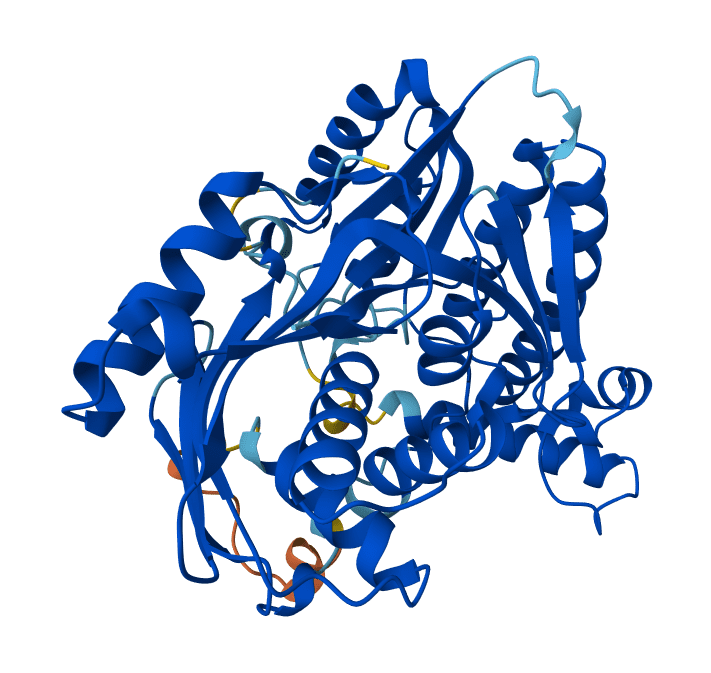
- Description: Galacturonokinase (galAK) is an enzyme participates in nucleotide sugars metabolism, displaying a great diversity of substrate specificities and kinetic properties across different species. Directed evolution and structure-based protein engineering has dramatically expanded the in vitro and in vivo synthetic utility.
- Synonyms: D-Galacturonic Acid Kinase; GALAK
- Reaction: ATP + D-Galacturonate = 1-Phospho-α-D-Galacturonate + ADP + H+
- Unit Definition: One unit will convert 1.0 μmole of D-galacturonate to 1-phospho-α-D-galacturonate per min at pH 7.5 and 30 oC.
- Chemical Purity: ≥ 90% (SDS-PAGE)
- Form: 1X PBS Buffer, pH 7.5; 50% Glycerol
- Storage: ≤ -20 oC; Avoid Freeze-Thaw Cycles
| Product Number | Description - Stable Isotope Position | Availability | Unit Size | Price |
|---|---|---|---|---|
| Q8VYG2-1 | A. thaliana galAK [EC 2.7.1.44]; ≥ 20 units/mg protein; Recombinant from E. coli | 30-Day Lead Time | 1 mg | Quote |
| Custom Expression | (Please Explore our Custom Expression Options for Insperation) | Variable Lead Times | TBD | Quote |
* Stable isotope labeled proteins are exclusively marketed & sold through Cambridge Isotope Laboratories (CIL).
Glucuronokinase
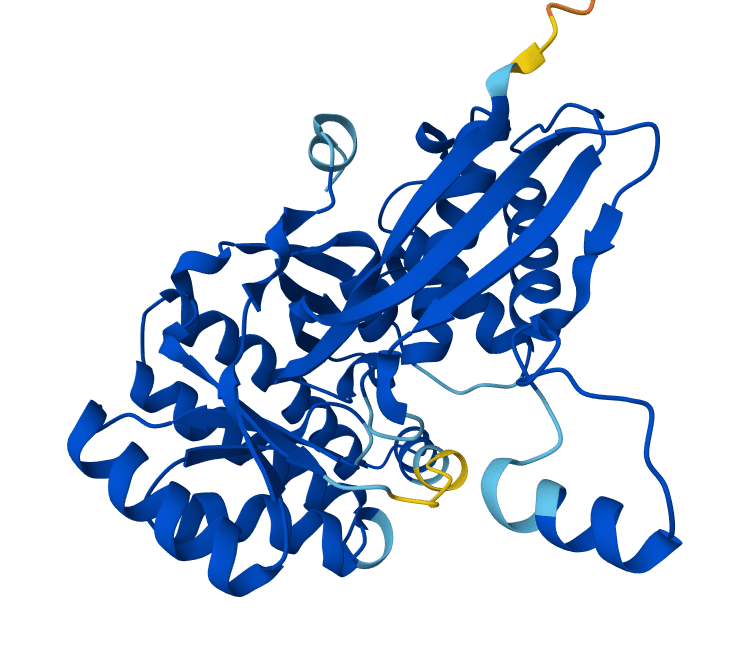
- Description: Glucuronokinase (glcAK) is an enzyme participates in nucleotide sugars metabolism, displaying a great diversity of substrate specificities and kinetic properties across different species, demonstrating exceptional synthetic utility.
- Synonyms: D-Glucuronic Acid Kinase; GLCAK
- Reaction: ATP + D-Glucuronate = 1-Phospho-α-D-Glucuronate + ADP + H+
- Unit Definition: One unit will convert 1.0 μmole of D-glucuronate to 1-phospho-α-D-glucuronate per min at pH 7.5 and 30 oC.
- Chemical Purity: ≥ 90% (SDS-PAGE)
- Form: 1X PBS Buffer, pH 7.5; 50% Glycerol
- Storage: ≤ -20 oC; Avoid Freeze-Thaw Cycles
| Product Number | Description - Stable Isotope Position | Availability | Unit Size | Price |
|---|---|---|---|---|
| Q93ZC9-1 | A. thaliana glcAK1 [EC 2.7.1.43]; ≥ 1 units/mg protein; Recombinant from E. coli | 30-Day Lead Time | 1 mg | Quote |
| Q9LY82-1 | A. thaliana glcAK2 [EC 2.7.1.43]; ≥ 1 units/mg protein; Recombinant from E. coli | 30-Day Lead Time | 1 mg | Quote |
| Custom Expression | (Please Explore our Custom Expression Options for Insperation) | Variable Lead Times | TBD | Quote |
* Stable isotope labeled proteins are exclusively marketed & sold through Cambridge Isotope Laboratories (CIL).
Guanylate Kinase
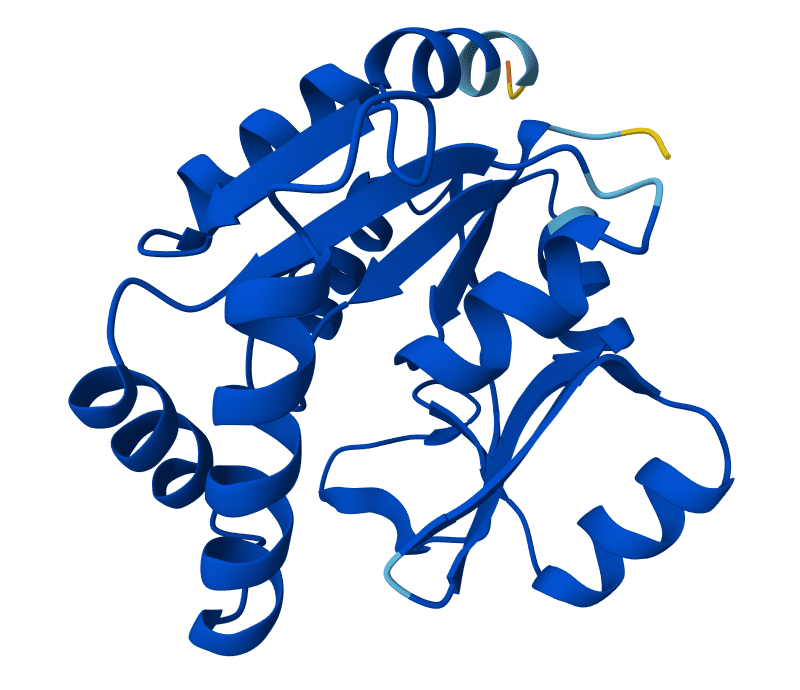
- Description: Guanylate Kinase (GMPK) catalyzes the ATP-dependent phosphorylation of GMP into GDP. It is essential for recycling GMP and indirectly, cGMP. Guanylate Kinase is a highly conserved monomeric protein found in both prokaryotes and eukaryotes.
- Synonyms: Deoxyguanylate Kinase; GMP Kinase; Guanosine Monophosphate Kinase; GMPK
- Reaction: ATP + GMP = ADP + GDP
- Unit Definition: One unit will convert 1.0 μmole of ATP and 1.0 μmole of GMP to 1.0 μmoles of ADP and 1.0 μmole of GDP per min at pH 7.5 and 30 oC.
- Chemical Purity: ≥ 90% (SDS-PAGE)
- Form: 1X PBS Buffer, pH 7.5; 50% Glycerol
- Storage: ≤ -20 oC; Avoid Freeze-Thaw Cycles
| Product Number | Description - Stable Isotope Position | Availability | Unit Size | Price |
|---|---|---|---|---|
| P60546-1 | E. coli kguA [EC 2.7.4.8]; ≥ 300 units/mg protein; Recombinant from E. coli | 30-Day Lead Time | 1 mg | Quote |
| Custom Expression | (Please Explore our Custom Expression Options for Insperation) | Variable Lead Times | TBD | Quote |
* Stable isotope labeled proteins are exclusively marketed & sold through Cambridge Isotope Laboratories (CIL).
Hexokinase
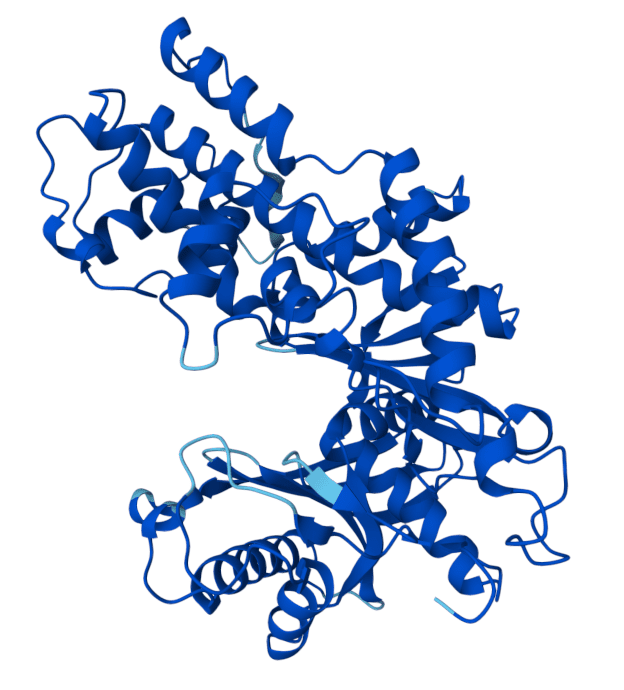
- Description: Hexokinase (hxkA) is an enzyme that irreversibly phosphorylates hexoses, forming hexose 6-phosphate. In prokaryotes through eukaryotes, glucose is the most important substrate in the first step of glycolysis for hexokinases to act on. Hexokinase should not be confused with glucokinase [EC 2.7.1.2], which is specific for D-glucose. All hexokinases are capable of phosphorylating several hexoses (D-glucose, D-mannose, D-fructose, D-glucosamine, and sorbitol). Hexokinase has been used in enzyme assays, as well as, used to determine ATP concentration.
- Synonyms: Hexokinase Type-I; Hexokinase Type-ll; Hexokinase Type-III; hxkA
- Reaction: D-Hexose + ATP = D-Hexose 6-Phosphate + ADP + H+
- Unit Definition: One unit will convert 1.0 μmole of D-glucose to D-glucose 6-phosphate per min at pH 7.5 and 30 oC.
- Chemical Purity: ≥ 90% (SDS-PAGE)
- Form: 1X PBS Buffer, pH 7.5; 50% Glycerol
- Storage: ≤ -20 oC; Avoid Freeze-Thaw Cycles
| Product Number | Description - Stable Isotope Position | Availability | Unit Size | Price |
|---|---|---|---|---|
| P04806 | S. cerevisiae hxkA/B [EC 2.7.1.1]; ≥ 100 units/mg protein; from Baker's Yeast | 30-Day Lead Time | 1 mg | Quote |
| Custom Expression | (Please Explore our Custom Expression Options for Insperation) | Variable Lead Times | TBD | Quote |
* Stable isotope labeled proteins are exclusively marketed & sold through Cambridge Isotope Laboratories (CIL).
N-Acetylhexosamine 1-Kinase

- Description: N-Acetylhexosamine 1-Kinase (nahK) is involved in the lacto-N-biose I/galacto-N-biose degradation pathway in the probiotic bacterium Bifidobacterium longum. NahK irreversibly phosphorylates phosphorylate both N-acetylgalactosamine and N-acetylglucosamine at similar rates. This enzyme should not be confused with N-acetylgalactosamine kinase [EC 2.7.1.157], which is specific for N-acetylgalactosamine.
- Synonyms: N-Acetylgalactosamine/N-Acetylglucosamine 1-Kinase; nahK
- Reaction: ATP + N-Acetyl-D-Hexosamine = ADP + N-Acetyl-α-D-Hexosamine 1-Phosphate + H+
- Unit Definition: One unit will convert 1.0 μmole of N-acetyl-D-hexosamine to N-acetyl-D-hexosamine 1-phosphate per min at pH 7.5 and 30 oC.
- Chemical Purity: ≥ 90% (SDS-PAGE)
- Form: 1X PBS Buffer, pH 7.5; 50% Glycerol
- Storage: ≤ -20 oC; Avoid Freeze-Thaw Cycles
| Product Number | Description - Stable Isotope Position | Availability | Unit Size | Price |
|---|---|---|---|---|
| C2GVB2-1 | B. longum nahK [EC 2.7.1.162]; ≥ 1 unit/mg protein; Recombinant from E. coli | 30-Day Lead Time | 1 mg | Quote |
| Custom Expression | (Please Explore our Custom Expression Options for Insperation) | Variable Lead Times | TBD | Quote |
* Stable isotope labeled proteins are exclusively marketed & sold through Cambridge Isotope Laboratories (CIL).
Nucleoside-Diphosphate Kinase

- Description: Nucleoside-Diphosphate Kinase (NDPK) catalyzes the reversible exchange of terminal phosphate between different nucleoside diphosphates (NDP) and triphosphates (NTP) to maintain the equilibrium concentrations between nucleotide triphosphates. NDPK is found in prokaryotes through eukaryotes, displaying little specificity towards the types of nucleoside bases and are capable of accepting nucleotides and deoxyribonucleotides as substrates or donors.
- Synonyms: Nucleoside 5′-Diphosphate Phosphotransferase; Nucleoside Diphosphokinase; NDPK; NDK
- Reaction: Ribonucleoside 5′-Diphosphate + ATP = Ribonucleoside 5′-Triphosphate + ADP
- Unit Definition: One unit will convert 1.0 μmole each of TDP and ATP to TTP and ADP per min at pH 7.5 and 25 oC.
- Chemical Purity: ≥ 90% (SDS-PAGE)
- Form: 1X PBS Buffer, pH 7.5; 50% Glycerol
- Storage: ≤ -20 oC; Avoid Freeze-Thaw Cycles
| Product Number | Description - Stable Isotope Position | Availability | Unit Size | Price |
|---|---|---|---|---|
| P52174 | B. taurus ndkA/B [EC 2.7.4.6]; ≥ 500 units/mg protein; from Bovine Liver | 30-Day Lead Time | 1 mg | Quote |
| P0A763-1 | E. coli ndkA [EC 2.7.4.6]; ≥ 1500 units/mg protein; Recombinant from E. coli | 30-Day Lead Time | 1 mg | Quote |
| Custom Expression | (Please Explore our Custom Expression Options for Insperation) | Variable Lead Times | TBD | Quote |
* Stable isotope labeled proteins are exclusively marketed & sold through Cambridge Isotope Laboratories (CIL).
6-Phosphofructokinase

- Description: 6-Phosphofructokinase (PFK) catalyses the phosphorylation of fructose-6-phosphate to fructose-1,6-bisphosphate, a key regulatory step in the glycolysis and gluconeogenesis metabolic pathways. PFK is allosterically inhibited by ATP and allosterically activated by AMP, thus indicating the energetic needs of the cell. 6-Phosphofructokinase is commonly used to study the interaction with neuronal nitric oxide synthase (nNOS) which causes a defect in glycolytic metabolism and increased fatigability in dystrophic muscle.
- Synonyms: Fructose 6-Phosphate Kinase; Phosphohexokinase; PFK
- Reaction: ATP + β-D-Fructose 6-Phosphate = ADP + β-D-Fructose 1,6-Bisphosphate + H+
- Unit Definition: One unit will convert 1.0 μmole of fructose 6-phosphate and ATP to fructose 1,6-diphosphate and ADP per minute at pH 9.0 at 30 oC.
- Chemical Purity: ≥ 90% (SDS-PAGE)
- Form: 1X PBS Buffer, pH 7.5; 50% Glycerol
- Storage: ≤ -20 oC; Avoid Freeze-Thaw Cycles
| Product Number | Description - Stable Isotope Position | Availability | Unit Size | Price |
|---|---|---|---|---|
| P00512 | B. stearothermophilus pfkA [EC 2.7.1.11]; ≥ 50 units/mg protein; from B. stearothermophilus | 30-Day Lead Time | 1 mg | Quote |
| Custom Expression | (Please Explore our Custom Expression Options for Insperation) | Variable Lead Times | TBD | Quote |
* Stable isotope labeled proteins are exclusively marketed & sold through Cambridge Isotope Laboratories (CIL).
Pyruvate Kinase
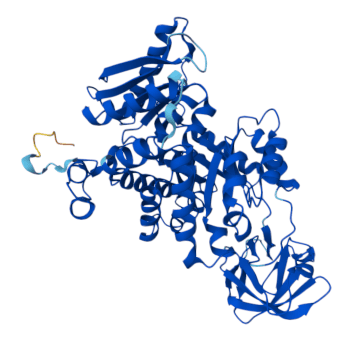
- Description: Pyruvate Kinase (PYK) plays a major role in the final rate-limiting and final step of glycolysis. PYK catalyzes transfer of a phosphate group from phosphoenolpyruvate (PEP) to adenosine 5′-diphosphate (ADP), yielding one molecule of pyruvate and ATP. Pyruvate Kinase is highly specific for phosphoenolpyruvate, but can utilize other dinucleotides (GDP, IDP, dADP, UDP, and CDP) as substrates in place of ADP.
- Synonyms: Phosphoenolpyruvate Kinase; Phosphoenol Transphosphorylase; PYK
- Reaction: ATP + Pyruvate = ADP + Phosphoenolpyruvate + H+
- Unit Definition: One unit will convert 1.0 μmole of phospho(enol)pyruvate to pyruvate per min at pH 7.2 and 30 oC.
- Chemical Purity: ≥ 90% (SDS-PAGE)
- Form: 1X PBS Buffer, pH 7.5; 50% Glycerol
- Storage: ≤ -20 oC; Avoid Freeze-Thaw Cycles
| Product Number | Description - Stable Isotope Position | Availability | Unit Size | Price |
|---|---|---|---|---|
| Q02499 | B. stearothermophilus kpyK [EC 2.7.1.40]; ≥ 100 units/mg protein; from B. stearothermophilus | 30-Day Lead Time | 1 mg | Quote |
| P11974 | O. cuniculus kpyM [EC 2.7.1.40]; ≥ 350 units/mg protein; from Rabbit Muscle | 30-Day Lead Time | 1 mg | Quote |
| Custom Expression | (Please Explore our Custom Expression Options for Insperation) | Variable Lead Times | TBD | Quote |
* Stable isotope labeled proteins are exclusively marketed & sold through Cambridge Isotope Laboratories (CIL).
Ribokinase

- Description: Ribokinase (RBSK) is an enzyme which participates in ribose and deoxyribose phosphate metabolism. The resulting D-ribose-5-phosphate can then be used either for sythesis of nucleotides, histidine, and tryptophan, or as a component of the pentose phosphate pathway. Research has identified RBSK as enzymatic synthesis tools, used to produce nucleosides with modified ribose residues.
- Synonyms: Ribokinase (Phosphorylating); Ribose 5-Phosphotransferase; Ribose 5-Kinase; RBSK
- Reaction: ATP + D-Ribose = ADP + D-Ribose 5-Phosphate + H+
- Unit Definition: One unit will convert 1.0 μmole of D-ribose to D-ribose 5-phosphate per min at pH 7.5 and 30 oC.
- Chemical Purity: ≥ 90% (SDS-PAGE)
- Form: 1X PBS Buffer, pH 7.5; 50% Glycerol
- Storage: ≤ -20 oC; Avoid Freeze-Thaw Cycles
| Product Number | Description - Stable Isotope Position | Availability | Unit Size | Price |
|---|---|---|---|---|
| P0A9J6-1 | E. coli rbsK [EC 2.7.1.15]; ≥ 50 units/mg protein; Recombinant from E. coli | 30-Day Lead Time | 1 mg | Quote |
| Custom Expression | (Please Explore our Custom Expression Options for Insperation) | Variable Lead Times | TBD | Quote |
* Stable isotope labeled proteins are exclusively marketed & sold through Cambridge Isotope Laboratories (CIL).
Ribose-Phosphate Diphosphokinase

- Description: Ribose-Phosphate Diphosphokinase (PRPPS) is involved in the synthesis of nucleotides (purines and pyrimidines), cofactors NAD and NADP, and amino acids histidine and tryptophan. PRPPS links these biosynthetic processes; through the HMP Shunt Pathway from Glucose-6-Phosphate, to the pentose phosphate pathway. Ribose-Phosphate Diphosphokinase exists in bacteria, plants, and animals, and dysfunction of this enzyme undermines many biosynthetic pathways.
- The product phosphoribosyl pyrophosphate acts as an essential component of the purine salvage pathway and the de novo synthesis of purines.
- Synonyms: Phosphoribosyl Diphosphate Synthetase; Ribose-Phosphate Pyrophosphokinase; PRPPS
- Reaction: ATP + D-Ribose 5-Phosphate = 5-Phospho-α-D-Ribose 1-Diphosphate + AMP + H+
- Unit Definition: One unit will interconvert 1.0 μmole of X to Y per min at pH 7.5 and 30 oC.
- Chemical Purity: ≥ 90% (SDS-PAGE)
- Form: 1X PBS Buffer, pH 7.5; 50% Glycerol
- Storage: ≤ -20 oC; Avoid Freeze-Thaw Cycles
| Product Number | Description - Stable Isotope Position | Availability | Unit Size | Price |
|---|---|---|---|---|
| P0A717-1 | E. coli kprS [EC 2.7.6.1]; ≥ 20 units/mg protein; Recombinant from E. coli | 30-Day Lead Time | 1 mg | Quote |
| Custom Expression | (Please Explore our Custom Expression Options for Insperation) | Variable Lead Times | TBD | Quote |
* Stable isotope labeled proteins are exclusively marketed & sold through Cambridge Isotope Laboratories (CIL).
Thymidine Kinase

- Description: Thymidine Kinase (TDK) is found in animals, plants, bacteria, archeans, and virus. TDK plays a key role in the nucleoside salvage pathway, recycling 2′-deoxynucleosides (dN’s) from degrading DNA to re-synthesize 2′-deoxynucleotides (dNTPs), as well as act to produce dNTP’s in the event of downregulation in the de novo nucleotide pathway. TDK also acts in the regulation of DNA synthesis, cell division, and as a virulence factor. TDK has been used as an enzymatic synthesis tool, and as a target in anti-cancer and anti-viral research.
- Synonyms: Deoxyuridine Kinase; 2′-Deoxythymidine Kinase; TDK
- Reaction: ATP + Thymidine = ADP + dTMP + H+
- Unit Definition: One unit will convert 1.0 μmole of thymidine to TMP per min at pH 7.5 and 30 oC.
- Chemical Purity: ≥ 90% (SDS-PAGE)
- Form: 1X PBS Buffer, pH 7.5; 50% Glycerol
- Storage: ≤ -20 oC; Avoid Freeze-Thaw Cycles
| Product Number | Description - Stable Isotope Position | Availability | Unit Size | Price |
|---|---|---|---|---|
| P23331-1 | E. coli kitH [EC 2.7.1.21]; ≥ 50 units/mg protein; Recombinant from E. coli | 30-Day Lead Time | 1 mg | Quote |
| Custom Expression | (Please Explore our Custom Expression Options for Insperation) | Variable Lead Times | TBD | Quote |
* Stable isotope labeled proteins are exclusively marketed & sold through Cambridge Isotope Laboratories (CIL).
Thymidylate Kinase
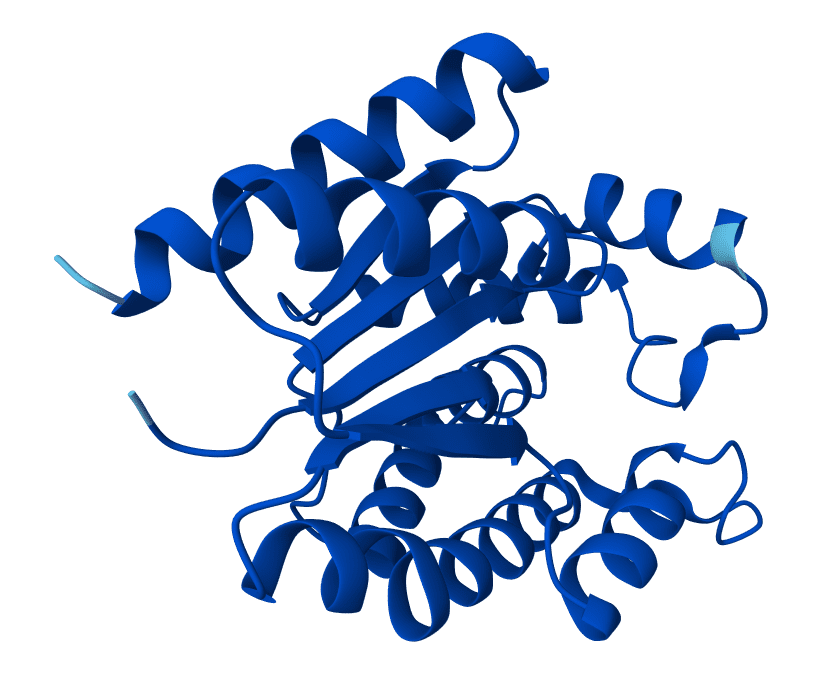
- Description: Thymidylate Kinase (TMPK) is a ubiquitous enzyme, situated at the junction of both de novo and salvage pathways of deoxythymidine triphosphate (dTTP) synthesis, which is essential for DNA synthesis and cellular growth.
- Synonyms: dTMP Kinase; TMPK; TMK
- Reaction: ATP + dTMP = ADP + dTDP
- Unit Definition: One unit will convert 1.0 μmole of ATP and 1.0 μmole of TMP to 1.0 μmoles of ADP and 1.0 μmole of TDP per min at pH 7.5 and 30 oC.
- Chemical Purity: ≥ 90% (SDS-PAGE)
- Form: 1X PBS Buffer, pH 7.5; 50% Glycerol
- Storage: ≤ -20 oC; Avoid Freeze-Thaw Cycles
| Product Number | Description - Stable Isotope Position | Availability | Unit Size | Price |
|---|---|---|---|---|
| P0A720-1 | E. coli kthY [EC 2.7.4.9]; ≥ 10 units/mg protein; Recombinant from E. coli | 30-Day Lead Time | 1 mg | Quote |
| Custom Expression | (Please Explore our Custom Expression Options for Insperation) | Variable Lead Times | TBD | Quote |
* Stable isotope labeled proteins are exclusively marketed & sold through Cambridge Isotope Laboratories (CIL).
Uridine/Cytidine Kinase
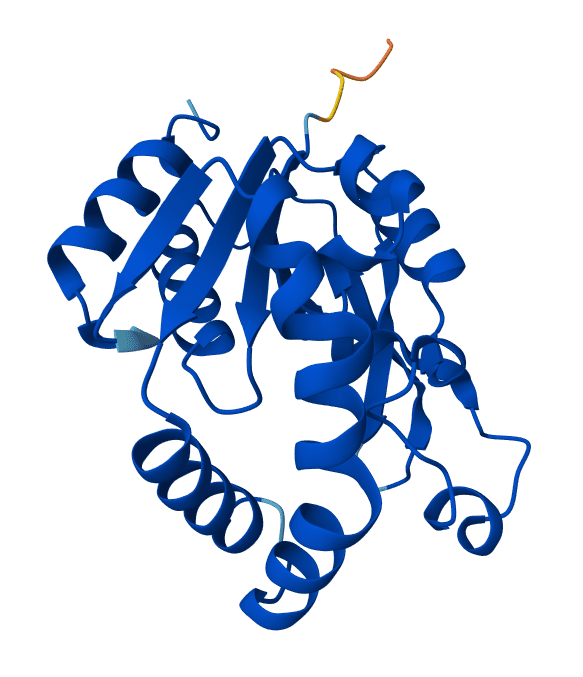
- Description: Uridine/Cytidine Kinases (UDK) plays a crucial role in the biosynthesis of the pyrimidine nucleotides that compose RNA. Pyrimidine biosynthesis can occur through two pathways: de novo synthesis, which relies on L-glutamine as the pathway precursor, and the salvage pathway, which recycles cellular uridine and cytidine. UDK catalyzes the first step of pyrimidine salvage, and is the rate limiting enzyme in the pathway. UDK will not catalyze the phosphorylation of deoxyribonucleosides or purine ribonucleosides. This enzyme can also phosphorylate uridine and cytidine analogs and use both ATP and GTP as a phosphate donor.
- Synonyms: Uridine-Cytidine Kinase; Uridine Kinase; UDK; URK; UK
- Reaction: ATP + Uridine = ADP + UMP + H+
- Unit Definition: One unit will convert 1.0 μmole of uridine to UMP per min at pH 7.5 and 30 oC.
- Chemical Purity: ≥ 90% (SDS-PAGE)
- Form: 1X PBS Buffer, pH 7.5; 50% Glycerol
- Storage: ≤ -20 oC; Avoid Freeze-Thaw Cycles
| Product Number | Description - Stable Isotope Position | Availability | Unit Size | Price |
|---|---|---|---|---|
| P0A8F4-1 | E. coli UdK [EC 2.7.1.48]; ≥ 30 units/mg protein; Recombinant from E. coli | 30-Day Lead Time | 1 mg | Quote |
| Custom Expression | (Please Explore our Custom Expression Options for Insperation) | Variable Lead Times | TBD | Quote |
* Stable isotope labeled proteins are exclusively marketed & sold through Cambridge Isotope Laboratories (CIL).
UMP Kinase
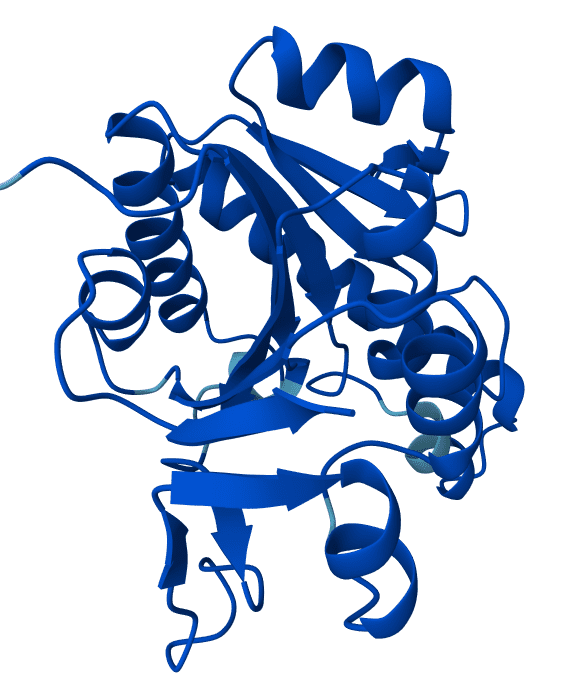
- Description: UMP Kinase (UMPK) is a key enzyme in the synthesis of pyrimidine nucleotide triphosphates. The eukaryotic enzyme [EC 2.7.4.14] has a dual-specificity, phosphorylating both UMP and CMP, while the bacterial enzyme is specific to UMP. The bacterial enzyme shows no sequence similarity to the eukaryotic enzyme or other nucleotide monophosphate kinases. UMPK activity is magnesium-dependent, activated by GTP, and repressed by UTP.
- Synonyms: Uridylate Kinase; Uridine Monophosphate Kinase; UMPK
- Reaction: ATP + UMP = ADP + UDP
- Unit Definition: One unit will convert 1.0 μmole of ATP and 1.0 μmole of UMP to 1.0 μmoles of ADP and 1.0 μmole of UDP per min at pH 7.5 and 30 oC.
- Chemical Purity: ≥ 90% (SDS-PAGE)
- Form: 1X PBS Buffer, pH 7.5; 50% Glycerol
- Storage: ≤ -20 oC; Avoid Freeze-Thaw Cycles
| Product Number | Description - Stable Isotope Position | Availability | Unit Size | Price |
|---|---|---|---|---|
| P0A7E9-1 | E. coli pyrH [EC 2.7.4.22]; ≥ 10 units/mg protein; Recombinant from E. coli | 30-Day Lead Time | 1 mg | Quote |
| Custom Expression | (Please Explore our Custom Expression Options for Insperation) | Variable Lead Times | TBD | Quote |
* Stable isotope labeled proteins are exclusively marketed & sold through Cambridge Isotope Laboratories (CIL).
Ligases
Template
- Description: Add Description Here.
- Synonyms: Name #1; Name #2; Nrame #3
- Reaction: Reactent = Product
- Unit Definition: One unit will interconvert 1.0 μmole of X to Y per min at pH 7.5 and 30 oC.
- Chemical Purity: ≥ 90% (SDS-PAGE)
- Form: 1X PBS Buffer, pH 7.5; 50% Glycerol
- Storage: ≤ -20 oC; Avoid Freeze-Thaw Cycles
| Product Number | Description - Stable Isotope Position | Availability | Unit Size | Price |
|---|---|---|---|---|
| UNIPROT-1 | G. species ABC [EC #.#.#.#]; ≥ 1 units/mg protein; Recombinant from E. coli | 30-Day Lead Time | 1 mg | Quote |
| Custom Expression | (Please Explore our Custom Expression Options for Insperation) | Variable Lead Times | TBD | Quote |
* Stable isotope labeled proteins are exclusively marketed & sold through Cambridge Isotope Laboratories (CIL).
Adenylosuccinate Synthase
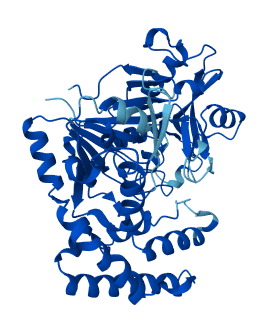
- Description: Adenylosuccinate Synthase (AdSS) plays an important role in the de novo purine biosynthesis pathway, by catalyzing the first committed step in the biosynthesis of AMP. Through a guanosine triphosphate (GTP)-dependent conversion of inosine monophosphate (IMP) and L-aspartic acid to guanosine diphosphate (GDP), phosphate, and N6-(1,2-dicarboxyethyl)-AMP are formed. AdSS is highly conserved and has been characterized from various sources ranging from bacteria through eukaryotes.
- Synonyms: Adenylosuccinate Synthetase; IMP-Aspartate Ligase; AdSS
- Reaction: GTP + IMP + L-Aspartate = GDP + 2 H+ + N6-(1,2-Dicarboxyethyl)-AMP + Phosphate
- Unit Definition: One unit will form 1.0 μmole of GMP per min at pH 7.5 and 30 oC.
- Chemical Purity: ≥ 90% (SDS-PAGE)
- Form: 1X PBS Buffer, pH 7.5; 50% Glycerol
- Storage: ≤ -20 oC; Avoid Freeze-Thaw Cycles
| Product Number | Description - Stable Isotope Position | Availability | Unit Size | Price |
|---|---|---|---|---|
| P0A7D4-1 | E. coli AdSS [EC 6.3.4.4]; ≥ 100 units/mg protein; Recombinant from E. coli | 30-Day Lead Time | 1 mg | Quote |
| Custom Expression | (Please Explore our Custom Expression Options for Insperation) | Variable Lead Times | TBD | Quote |
* Stable isotope labeled proteins are exclusively marketed & sold through Cambridge Isotope Laboratories (CIL).
CTP Synthase
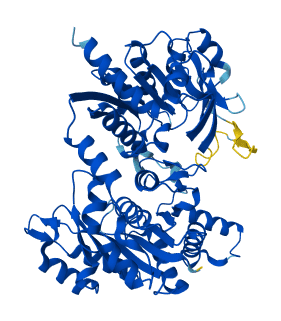
- Description: CTP Synthase (CTPS) catalyzes the last committed step in pyrimidine nucleotide biosynthesis, through the rate-limiting synthesis of cytosine nucleotides from both the de novo and uridine salvage pathways. CTPS is precisely regulated by the intracellular concentrations of CTP and UTP, and has maximal activity at physiological concentrations of ATP, GTP, and L-glutamine. This acts to balance the relative amounts of purine and pyrimidine nucleotides. Upregulated CTP synthase activity has been widely observed in human cancer cells, while mutations in the CTPS confer resistance to cytotoxic chemotherapeutic drugs.
- Synonyms: CTP Synthetase; UTP-Ammonia Ligase; CTPS
- Reaction: ATP + H2O + L-Glutamine + UTP = ADP + CTP + 2 H+ + L-Glutamate + Phosphate
- Unit Definition: One unit will form 1.0 μmole of CTP from UTP per min at pH 7.5 and 30 oC.
- Chemical Purity: ≥ 90% (SDS-PAGE)
- Form: 1X PBS Buffer, pH 7.5; 50% Glycerol
- Storage: ≤ -20 oC; Avoid Freeze-Thaw Cycles
| Product Number | Description - Stable Isotope Position | Availability | Unit Size | Price |
|---|---|---|---|---|
| P0A7E5-1 | E. coli pyrG [EC 6.3.4.2]; ≥ 100 units/mg protein; Recombinant from E. coli | 30-Day Lead Time | 1 mg | Quote |
| Custom Expression | (Please Explore our Custom Expression Options for Insperation) | Variable Lead Times | TBD | Quote |
* Stable isotope labeled proteins are exclusively marketed & sold through Cambridge Isotope Laboratories (CIL).
Glutamine Synthetase
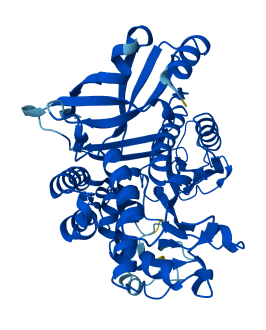
- Description: Glutamine synthetase (GlnS) is widely distributed from bacteria to eukaryotes, playing an essential role in the regulation and metabolism of nitrogen by catalyzing the ATP-dependent condensation of glutamate and ammonia to form glutamine. GlnS can regulate the production of certain amino acids and nucleotides, such as: adenosine monophosphate, histidine, and alanine. Malfunction can lead to liver cirrhosis, chronic hepatitis, hyperplasia and neoplasms, as well as, neurological diseases like Alzheimer’s, epilepsy, and glioblastoma multiforme.
- Synonyms: Glutamate-Ammonia Ligase; L-Glutamine Synthetase; GlnS
- Reaction: ATP + L-Glutamate + NH4+ = ADP + H+ + L-Glutamine + Phosphate
- Unit Definition: One unit will form 1.0 μmole of Gln from Glu and ATP per min at pH 7.5 and 30 oC.
- Chemical Purity: ≥ 90% (SDS-PAGE)
- Form: 1X PBS Buffer, pH 7.5; 50% Glycerol
- Storage: ≤ -20 oC; Avoid Freeze-Thaw Cycles
| Product Number | Description - Stable Isotope Position | Availability | Unit Size | Price |
|---|---|---|---|---|
| P12425-1 | B. subtilis GlnS [EC 6.3.1.2]; ≥ 100 units/mg protein; Recombinant from E. coli | 30-Day Lead Time | 1 mg | Quote |
| P0A9C5-1 | E. coli GlnS [EC 6.3.1.2]; ≥ 100 units/mg protein; Recombinant from E. coli | 30-Day Lead Time | 1 mg | Quote |
| Custom Expression | (Please Explore our Custom Expression Options for Insperation) | Variable Lead Times | TBD | Quote |
* Stable isotope labeled proteins are exclusively marketed & sold through Cambridge Isotope Laboratories (CIL).
GMP Synthase
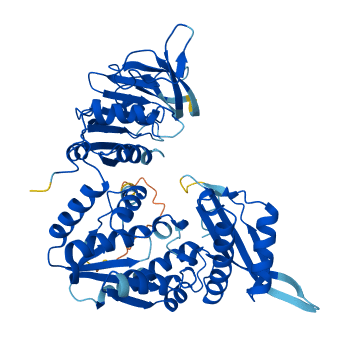
- Description: GMP synthetase (GMPS) converts xanthosine monophosphate (XMP) to guanosine monophosphate (GMP) in the de novo purine biosynthesis pathway. GMPS also plays an essential role in the regulation and metabolism of nitrogen, as well as, being an essential enzyme and virulence factor for many pathogenic organisms.
- Synonyms: GMP Synthetase (Glutamine-Hydrolyzing); GMPS
- Reaction: ATP + H2O + L-Glutamine + XMP = AMP + Diphosphate + GMP + 2 H+ + L-Glutamate
- Unit Definition: One unit will form 1.0 μmole of GMP per min at pH 7.5 and 30 oC.
- Chemical Purity: ≥ 90% (SDS-PAGE)
- Form: 1X PBS Buffer, pH 7.5; 50% Glycerol
- Storage: ≤ -20 oC; Avoid Freeze-Thaw Cycles
| Product Number | Description - Stable Isotope Position | Availability | Unit Size | Price |
|---|---|---|---|---|
| P04079-1 | E. coli GMPS [EC 6.3.5.2]; ≥ 100 units/mg protein; Recombinant from E. coli | 30-Day Lead Time | 1 mg | Quote |
| Custom Expression | (Please Explore our Custom Expression Options for Insperation) | Variable Lead Times | TBD | Quote |
* Stable isotope labeled proteins are exclusively marketed & sold through Cambridge Isotope Laboratories (CIL).
Lyases
Template
- Description: Add Description Here.
- Synonyms: Name #1; Name #2; Nrame #3
- Reaction: Reactent = Product
- Unit Definition: One unit will interconvert 1.0 μmole of X to Y per min at pH 7.5 and 30 oC.
- Chemical Purity: ≥ 90% (SDS-PAGE)
- Form: 1X PBS Buffer, pH 7.5; 50% Glycerol
- Storage: ≤ -20 oC; Avoid Freeze-Thaw Cycles
| Product Number | Description - Stable Isotope Position | Availability | Unit Size | Price |
|---|---|---|---|---|
| UNIPROT-1 | G. species ABC [EC #.#.#.#]; ≥ 1 units/mg protein; Recombinant from E. coli | 30-Day Lead Time | 1 mg | Quote |
| Custom Expression | (Please Explore our Custom Expression Options for Insperation) | Variable Lead Times | TBD | Quote |
* Stable isotope labeled proteins are exclusively marketed & sold through Cambridge Isotope Laboratories (CIL).
Adenylosuccinate Lyase
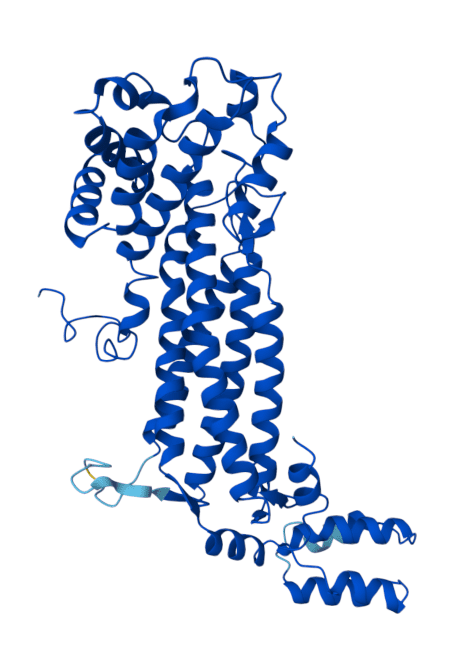
- Description: Adenylosuccinate Lyase (AdSL) is an enzyme that catalyzes two reactions in the de novo purine biosynthetic pathway, forming aminoimidazole-4-carboxamide ribotide (AICAR) and adenylosuccinate (AdS). Both reactions it uses an E1cB elimination reaction mechanism to cleave fumarate. AdSL is important to cells not only because of its involvement in creating purines needed for cellular replication, but also for regulating metabolic processes by controlling the levels of AMP and fumarate in the cell. Point mutations in Adenylosuccinate Lyase cause lowered enzymatic activity causing the clinical symptoms of adenylosuccinate lyase deficiency. ASL is also a new therapeutic target of the malaria causing Plasmodium parasites.
- Synonyms: Adenylosuccinase; Succino AMP-Lyase; AdSL
- Reaction: N6-(1,2-Dicarboxyethyl)-AMP = AMP + Fumarate
- Unit Definition: One unit will form 1.0 μmole of AMP and fumarate from N6-(1,2-dicarboxyethyl)-AMP per min at pH 7.5 and 30 oC.
- Chemical Purity: ≥ 90% (SDS-PAGE)
- Form: 1X PBS Buffer, pH 7.5; 50% Glycerol
- Storage: ≤ -20 oC; Avoid Freeze-Thaw Cycles
| Product Number | Description - Stable Isotope Position | Availability | Unit Size | Price |
|---|---|---|---|---|
| P0AB89-1 | E. coli AdSL [EC 4.3.2.2]; ≥ 10 units/mg protein; Recombinant from E. coli | 30-Day Lead Time | 1 mg | Quote |
| Custom Expression | (Please Explore our Custom Expression Options for Insperation) | Variable Lead Times | TBD | Quote |
* Stable isotope labeled proteins are exclusively marketed & sold through Cambridge Isotope Laboratories (CIL).
N-Acetylneuraminate Lyase

- Description: N-Acetylneuraminate Lyase (NANA) serves to regulate intracellular sialic acid metabolism, and recognition processes. N-Acetylneuraminate (Neu5Ac) is the best known of a 40-membered class of sialic acids, which are typically located at the terminal positions of glycoproteins, glycolipids, and capsular polysaccharides. Thus, sialic acids play important roles viral and bacterial infections, as well as, cellular adhesion and cancer. NANA is useful for enzymatic determination of Neu5Ac in clinical analyses, and for the industrial synthesis of sialic acid.
- Synonyms: N-Acetylneuraminate Pyruvate-Lyase; N-Acetylneuraminic Acid Aldolase; NANA
- Reaction: N-Acetylneuraminate = N-Acetyl-D-Mannosamine (ManNAc) + Pyruvate
- Unit Definition: One unit will form 1.0 μmol Neu5Ac from ManNAc and pyruvate per minute at pH 7.5 and 30 oC.
- Chemical Purity: ≥ 90% (SDS-PAGE)
- Form: 1X PBS Buffer, pH 7.5; 50% Glycerol
- Storage: ≤ -20 oC; Avoid Freeze-Thaw Cycles
| Product Number | Description - Stable Isotope Position | Availability | Unit Size | Price |
|---|---|---|---|---|
| P0A6L4-1 | E. coli NANA [EC 4.1.3.3]; ≥ 50 units/mg protein; Recombinant from E. coli | 30-Day Lead Time | 1 mg | Quote |
| B9DIJ2-1 | S. carnosus NANA [EC 4.1.3.3]; ≥ 10 units/mg protein; Recombinant from E. coli | 30-Day Lead Time | 1 mg | Quote |
| Custom Expression | (Please Explore our Custom Expression Options for Insperation) | Variable Lead Times | TBD | Quote |
* Stable isotope labeled proteins are exclusively marketed & sold through Cambridge Isotope Laboratories (CIL).
Argininosuccinate Lyase

- Description: Argininosuccinate Lyase (ARLY) is the fourth enzyme of the Urea Cycle, involved in the biosynthesis of arginine in all species and the production of urea in ureotelic species. ARLY catalyzes the reversible E1cB elimination reaction of argininosuccinate. Mutations in ARLY result in low activity of the enzyme and Argininosuccinic Aciduria, through increased levels of ammonia, urea, uric acid, and citrulline.
- Synonyms: Arginosuccinase; N-(L-Argininosuccinate) Arginine-Lyase; Nω-(L-Arginino)succinate Arginine-Lyase; ARLY
- Reaction: 2-(Nω-L-Arginino)succinate = Fumarate + L-Arginine
- Unit Definition: One unit will interconvert 1.0 μmole of 2-(Nω-L-arginino)succinate to fumarate + L-arginine per min at pH 7.5 and 30 oC.
- Chemical Purity: ≥ 90% (SDS-PAGE)
- Form: 1X PBS Buffer, pH 7.5; 50% Glycerol
- Storage: ≤ -20 oC; Avoid Freeze-Thaw Cycles
| Product Number | Description - Stable Isotope Position | Availability | Unit Size | Price |
|---|---|---|---|---|
| P11447-1 | E. coli ARLY [EC 4.3.2.1]; ≥ 400 units/mg protein; Recombinant from E. coli | 30-Day Lead Time | 1 mg | Quote |
| Custom Expression | (Please Explore our Custom Expression Options for Insperation) | Variable Lead Times | TBD | Quote |
* Stable isotope labeled proteins are exclusively marketed & sold through Cambridge Isotope Laboratories (CIL).
Aspartate Ammonia-Lyase
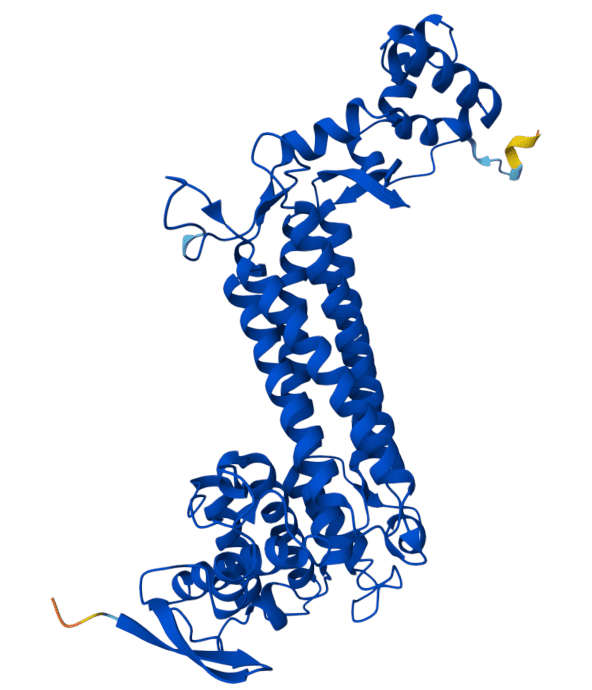
- Description: Aspartate Ammonia-Lyase (ASPase) participates in alanine and aspartate metabolism, as well as, nitrogen metabolism. ASPase is specific for L-aspartate and cannot use structural analogs of L-aspartate such as: D-aspartate, DL-α-methylaspartate, DL-β-methylaspartate, DL-threo-β-hydroxy-aspartate, DL-erythro-β-hydroxyaspartate, L-cysteate, L-α-aminobutyrate, L-asparagine, L-alanine, or L-glutamate. ASPase is useful for clinical analysis of blood clotting and plasminogen activation, as well as, the industrial production of L-aspartic acid and cinnamic acid.
- Synonyms: Aspartase; Fumaric Aminase; ASPase
- Reaction: L-Aspartate = Fumarate + NH4+
- Unit Definition: One unit will interconvert 1.0 μmole of L-aspartate to fumarate and ammonium per min at pH 7.5 and 30 oC.
- Chemical Purity: ≥ 90% (SDS-PAGE)
- Form: 1X PBS Buffer, pH 7.5; 50% Glycerol
- Storage: ≤ -20 oC; Avoid Freeze-Thaw Cycles
| Product Number | Description - Stable Isotope Position | Availability | Unit Size | Price |
|---|---|---|---|---|
| P0AC38-1 | E. coli ASPase [EC 4.3.1.1]; ≥ 350 units/mg protein; Recombinant from E. coli | 30-Day Lead Time | 1 mg | Quote |
| Custom Expression | (Please Explore our Custom Expression Options for Insperation) | Variable Lead Times | TBD | Quote |
* Stable isotope labeled proteins are exclusively marketed & sold through Cambridge Isotope Laboratories (CIL).
Orotidine-5'-Phosphate Decarboxylase
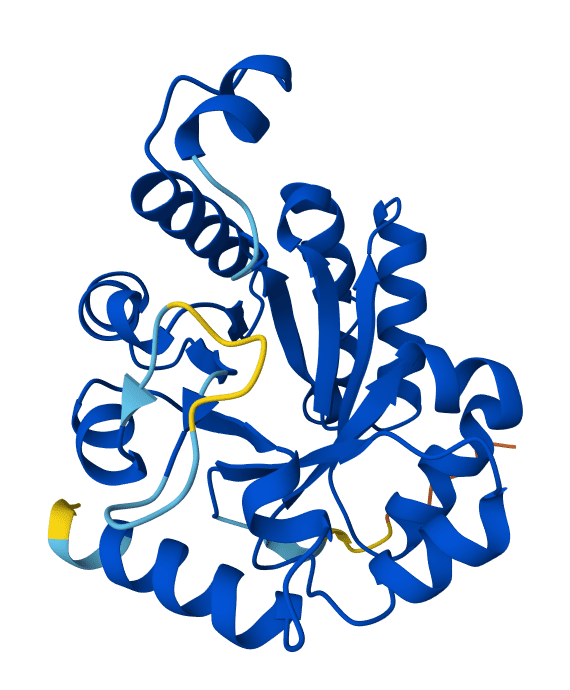
- Description: Orotidine-5′-Phosphate Decarboxylase (OMPDC) is an essential enzyme in the de novo pyrimidine biosynthesis. It catalyzes the decarboxylation of orotidine monophosphate (OMP) to form uridine monophosphate (UMP). OMPDC has been a frequent target for scientific investigation because of its demonstrated extreme catalytic efficiency. This extreme enzymatic efficiency is especially interesting because OMP decarboxylases uses no cofactor, contains no metal sites, or prosthetic groups. The enzyme may be a potential cancer drug target in humans, and as a selection marker for yeast strain engineering.
- Synonyms: Orotidine-5′-Phosphate Carboxy-Lyase; Orotidylic Decarboxylase; OMPDC
- Reaction: H+ + Orotidine-5′-Phosphate = CO2 + Uridine-5′-Phosphate
- Unit Definition: One unit will convert 1.0 μmole of OMP to UMP per min at pH 7.5 and 30 oC.
- Chemical Purity: ≥ 90% (SDS-PAGE)
- Form: 1X PBS Buffer, pH 7.5; 50% Glycerol
- Storage: ≤ -20 oC; Avoid Freeze-Thaw Cycles
| Product Number | Description - Stable Isotope Position | Availability | Unit Size | Price |
|---|---|---|---|---|
| P08244-1 | E. coli OMPDC [EC 4.1.1.23]; ≥ 50 units/mg protein; Recombinant from E. coli | 30-Day Lead Time | 1 mg | Quote |
| Custom Expression | (Please Explore our Custom Expression Options for Insperation) | Variable Lead Times | TBD | Quote |
* Stable isotope labeled proteins are exclusively marketed & sold through Cambridge Isotope Laboratories (CIL).
Pseudouridylate Synthase
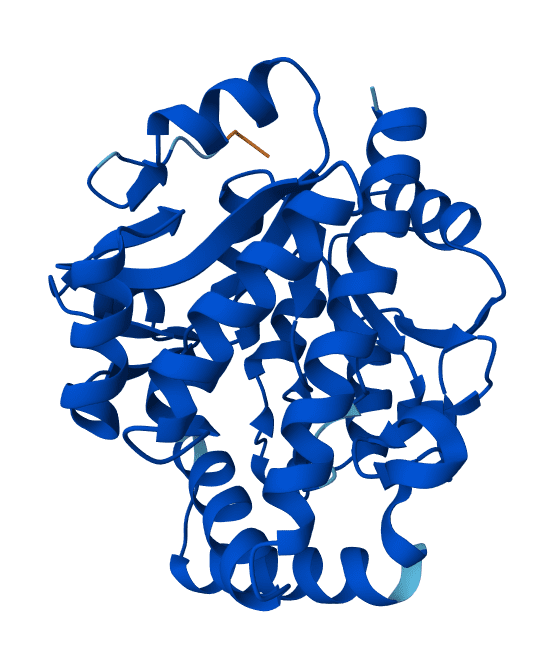
- Description: Pseudouridylate Synthase (ΨMPS) catalyzes the reversible cleavage of pseudouridine-5′-phosphate (ΨMP) to ribose 5-phosphate and uracil. ΨMPS functions biologically as part of a pseudouridine (Ψ) degradation pathway, which recycles this naturally occuring non-classical C-linked nucleoside found in all types of RNA (tRNA, rRNA, snRNA, snoRNA, scaRNA, and mRNA).
- Synonyms: Pseudouridine-5′-Phosphate Glycosidase; Uracil Hydrolyase; ΨMPS
- Reaction: D-Ribose-5-Phosphate + Uracil = H2O + ΨMP
- Unit Definition: One unit will form 1.0 μmole of D-ribose-5-phosphate and uracil from pseudouridine-5′-phosphate per min at pH 7.5 and 30 oC.
- Chemical Purity: ≥ 90% (SDS-PAGE)
- Form: 1X PBS Buffer, pH 7.5; 50% Glycerol
- Storage: ≤ -20 oC; Avoid Freeze-Thaw Cycles
| Product Number | Description - Stable Isotope Position | Availability | Unit Size | Price |
|---|---|---|---|---|
| P33025-1 | E. coli ΨMPS [EC 4.2.1.70]; ≥ 10 units/mg protein; Recombinant from E. coli | 30-Day Lead Time | 1 mg | Quote |
| Custom Expression | (Please Explore our Custom Expression Options for Insperation) | Variable Lead Times | TBD | Quote |
* Stable isotope labeled proteins are exclusively marketed & sold through Cambridge Isotope Laboratories (CIL).
Pyruvate Decarboxylase

- Description: Pyruvate Decarboxylase (PDC) participates in the anaerobic fermentation process of ethanol that occurs predominantly in yeast and some species of fish. PDC has been used to evaluate the power of systematic identification of meaningful metabolic enzyme regulation (SIMMER) for finding unknown yeast regulatory interactions, the residues involved in thiamine pyrophosphate (TPP) binding, as well as, the regulation of fermentation pathways in plant species.
- Synonyms: 2-Oxo-Acid Carboxy-Lyase; α-Carboxylase; α-Ketoacid Carboxylase, PDC
- Reaction: Pyruvate + H+ = Acetaldehyde + CO2
- Unit Definition: One unit will convert 1.0 μmole of pyruvate to acetaldehyde per min at pH 6.0 and 25 oC.
- Chemical Purity: ≥ 90% (SDS-PAGE)
- Form: 1X PBS Buffer, pH 7.5; 50% Glycerol
- Storage: ≤ -20 oC; Avoid Freeze-Thaw Cycles
| Product Number | Description - Stable Isotope Position | Availability | Unit Size | Price |
|---|---|---|---|---|
| P06169-1 | S. cerevisiae PDC [EC 4.1.1.1]; ≥ 20 units/mg protein; Recombinant from E. coli | 30-Day Lead Time | 1 mg | Quote |
| Q93EN4-1 | S. ventriculi PDC [EC 4.1.1.1]; ≥ 20 units/mg protein; Recombinant from E. coli | 30-Day Lead Time | 1 mg | Quote |
| P06672-1 | Z. mobilis PDC [EC 4.1.1.1]; ≥ 20 units/mg protein; Recombinant from E. coli | 30-Day Lead Time | 1 mg | Quote |
| Custom Expression | (Please Explore our Custom Expression Options for Insperation) | Variable Lead Times | TBD | Quote |
* Stable isotope labeled proteins are exclusively marketed & sold through Cambridge Isotope Laboratories (CIL).
Mutases
Template
- Description: Add Description Here.
- Synonyms: Name #1; Name #2; Nrame #3
- Reaction: Reactent = Product
- Unit Definition: One unit will interconvert 1.0 μmole of X to Y per min at pH 7.5 and 30 oC.
- Chemical Purity: ≥ 90% (SDS-PAGE)
- Form: 1X PBS Buffer, pH 7.5; 50% Glycerol
- Storage: ≤ -20 oC; Avoid Freeze-Thaw Cycles
| Product Number | Description - Stable Isotope Position | Availability | Unit Size | Price |
|---|---|---|---|---|
| UNIPROT-1 | G. species ABC [EC #.#.#.#]; ≥ 1 units/mg protein; Recombinant from E. coli | 30-Day Lead Time | 1 mg | Quote |
| Custom Expression | (Please Explore our Custom Expression Options for Insperation) | Variable Lead Times | TBD | Quote |
* Stable isotope labeled proteins are exclusively marketed & sold through Cambridge Isotope Laboratories (CIL).
Phosphoglucomutase

- Description: Phosphoglucomutase (PGM) is essential for protein, lipid, and nucleic acid metabolism, as well as, playing a vital role in glycolysis and gluconeogenesis. PGM is also involved in glycogen and trehalose metabolism in insects, in addition to participating in the development of plants and some microorganisms. PGM deficiency is both a glycogenosis and a congenital disorder of glycosylation, detected by an in vitro study of anaerobic glycolysis revealing a block in the pathway toward lactic acid production.
- Synonyms: Glucose Phosphomutase; Phosphoglucose Mutase; PGM
- Reaction: Glucose-6-Phosphate = Glucose-1-Phosphate
- Unit Definition: One unit will interconvert 1.0 μmole of glucose-6-phosphate to glucose-1-phosphate per min in the presence of α-D-glucose-1,6-bisphosphate at pH 7.5 and 30 oC.
- Chemical Purity: ≥ 90% (SDS-PAGE)
- Form: 1X PBS Buffer, pH 7.5; 50% Glycerol
- Storage: ≤ -20 oC; Avoid Freeze-Thaw Cycles
| Product Number | Description - Stable Isotope Position | Availability | Unit Size | Price |
|---|---|---|---|---|
| P00949 | O. cuniculus PGM [EC 5.4.2.2]; ≥ 100 units/mg protein; from Rabbit Muscle | 30-Day Lead Time | 1 mg | Quote |
| P00949-1 | O. cuniculus PGM [EC 5.4.2.2]; ≥ 100 units/mg protein; Recombinant from E. coli | In Pipeline | - | - |
| Custom Expression | (Please Explore our Custom Expression Options for Insperation) | Variable Lead Times | TBD | Quote |
* Stable isotope labeled proteins are exclusively marketed & sold through Cambridge Isotope Laboratories (CIL).
Phosphoglucosamine Mutase
- Description: Phosphoglucosamine Mutase (PGNM) is involved directly in an essential step of the UDP-N-acetylglucosamine biosynthesis, as well as, the biosyntheses pathways involving peptidoglycan, lipo-polysaccharide, and bacterial cell-walls. The enzyme from Escherichia coli is activated through phosphorylation by ATP, α-D-glucosamine-1,6-bisphosphate, or α-D-glucose 1,6-bisphosphate. It can also catalyse the interconversion of α-D-glucose 1-phosphate and glucose 6-phosphate, although at a much lower rate.
- Synonyms: Glucosamine Phosphomutase; PGnM
- Reaction: α-D-Glucosamine 1-Phosphate = D-Glucosamine 6-Phosphate
- Unit Definition: One unit will interconvert 1.0 μmole of glucosamine-6-phosphate to Glucosamine-1-phosphate per min at pH 7.5 and 30 oC.
- Chemical Purity: ≥ 90% (SDS-PAGE)
- Form: 1X PBS Buffer, pH 7.5; 50% Glycerol
- Storage: ≤ -20 oC; Avoid Freeze-Thaw Cycles
| Product Number | Description - Stable Isotope Position | Availability | Unit Size | Price |
|---|---|---|---|---|
| P31120-1 | E. coli glmM [EC 5.4.2.10]; ≥ 10 units/mg protein; Recombinant from E. coli | 30-Day Lead Time | 1 mg | Quote |
| Custom Expression | (Please Explore our Custom Expression Options for Insperation) | Variable Lead Times | TBD | Quote |
* Stable isotope labeled proteins are exclusively marketed & sold through Cambridge Isotope Laboratories (CIL).
Nucleotidyltransferases
Template
- Description: Add Description Here.
- Synonyms: Name #1; Name #2; Nrame #3
- Reaction: Reactent = Product
- Unit Definition: One unit will interconvert 1.0 μmole of X to Y per min at pH 7.5 and 30 oC.
- Chemical Purity: ≥ 90% (SDS-PAGE)
- Form: 1X PBS Buffer, pH 7.5; 50% Glycerol
- Storage: ≤ -20 oC; Avoid Freeze-Thaw Cycles
| Product Number | Description - Stable Isotope Position | Availability | Unit Size | Price |
|---|---|---|---|---|
| UNIPROT-1 | G. species ABC [EC #.#.#.#]; ≥ 1 units/mg protein; Recombinant from E. coli | 30-Day Lead Time | 1 mg | Quote |
| Custom Expression | (Please Explore our Custom Expression Options for Insperation) | Variable Lead Times | TBD | Quote |
* Stable isotope labeled proteins are exclusively marketed & sold through Cambridge Isotope Laboratories (CIL).
N-Acetylgalactosamine-1-Phosphate Uridylyltransferase
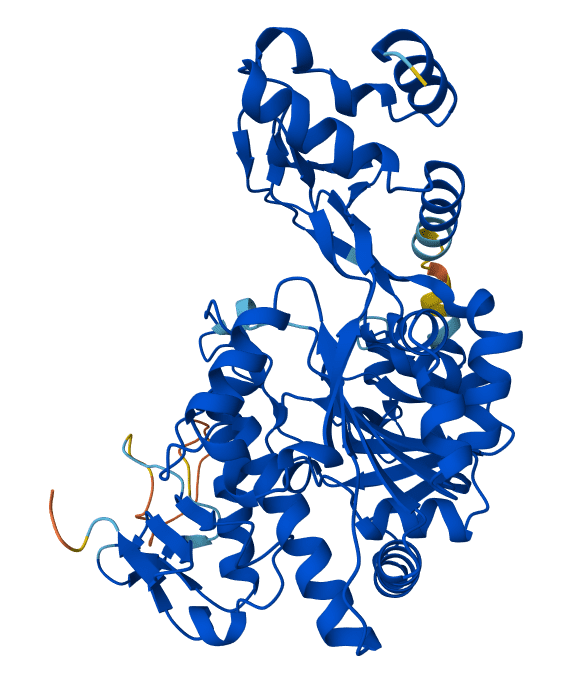
- Description: N-Acetylgalactosamine-1-Phosphate Uridyltransferase (UAP) is a cytoplasmic enzyme involved in the biosynthesis of the nucleotide-activated UDP-GalNAc, which is an essential precursor for the biosynthesis of cell-wall peptidoglycans and lipopolysaccharides. UAP’s from plants and animals commonly possess N-Acetylglucosamine-1-Phosphate Uridylyltransferase [EC 2.7.7.23] activity, and are devoid of the bifunctional Glucosamine-1-Phosphate N-Acetyltransferase [EC 2.3.1.157] activity found in bacteria and archaea.
- Synonyms: UDP-N-Acetylgalactosamine Diphosphorylase; UDP-N-Acetylgalactosamine Pyrophosphorylase; UAP
- Reaction: N-Acetylgalactosamine-1-Phosphate + H+ + UTP = UDP-N-Acetylgalatcosamine + Diphosphate
- Unit Definition: One unit will form 1.0 μmole of N-acetylgalactosamine-1-phosphate from uridine-5′-diphospho-N-acetylgalactosamine-1-phosphate and inorganic pyrophosphate per min at pH 7.6 and 25 oC.
- Chemical Purity: ≥ 90% (SDS-PAGE)
- Form: 1X PBS Buffer, pH 7.5; 50% Glycerol
- Storage: ≤ -20 oC; Avoid Freeze-Thaw Cycles
| Product Number | Description - Stable Isotope Position | Availability | Unit Size | Price |
|---|---|---|---|---|
| Q16222-1 | H. sapiens UAP [EC 2.7.7.83]; ≥ 30 units/mg protein; Recombinant from E. coli | 30-Day Lead Time | 1 mg | Quote |
| Custom Synthesis | (Please Explore our Custom Expression Options for Insperation) | Variable Lead Times | TBD | Quote |
* Stable isotope labeled proteins are exclusively marketed & sold through Cambridge Isotope Laboratories (CIL).
N-Acetylglucosamine-1-Phosphate Uridylyltransferase
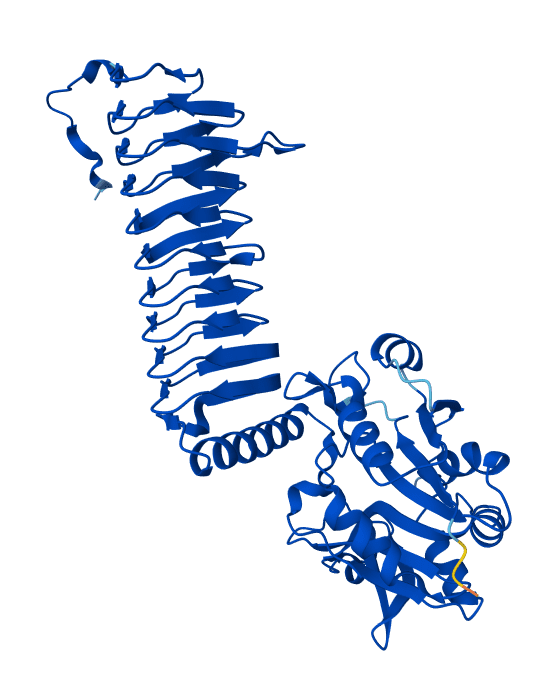
- Description: N-Acetylglucosamine-1-Phosphate Uridyltransferase (UGnP) is a cytoplasmic enzyme involved in the biosynthesis of the nucleotide-activated UDP-GlcNAc, which is an essential precursor for the biosynthesis of cell-wall peptidoglycans and lipopolysaccharides. UGnP from several bacteria (e.g. Escherichia coli, Bacillus subtilis and Haemophilus influenzae) has been shown to be a bifunctional enzyme, possessing Glucosamine-1-Phosphate N-Acetyltransferase [EC 2.3.1.157] activity.
- Synonyms: UDP-N-Acetylglucosamine Diphosphorylase; UDP-N-Acetylglucosamine Pyrophosphorylase; UGnP
- Reaction: N-Acetylglucosamine-1-Phosphate + H+ + UTP = UDP-N-Acetylglucosamine + Diphosphate
- Unit Definition: One unit will form 1.0 μmole of N-acetylglucosamine-1-phosphate from uridine-5′-diphospho-N-acetylglucosamine-1-phosphate and inorganic pyrophosphate per min at pH 7.6 and 25 oC.
- Chemical Purity: ≥ 90% (SDS-PAGE)
- Form: 1X PBS Buffer, pH 7.5; 50% Glycerol
- Storage: ≤ -20 oC; Avoid Freeze-Thaw Cycles
| Product Number | Description - Stable Isotope Position | Availability | Unit Size | Price |
|---|---|---|---|---|
| P0ACC7-1 | E. coli UGnP Δ230-456 [EC 2.7.7.23]; ≥ 10 units/mg protein; Recombinant from E. coli | 30-Day Lead Time | 1 mg | Quote |
| P0ACC7-2 | E. coli UGnP [EC 2.7.7.23] Bi-Functional; ≥ 10 units/mg protein; Recombinant from E. coli | 30-Day Lead Time | 1 mg | Quote |
| Q16222-1 | H. sapiens UGnP [EC 2.7.7.23]; ≥ 10 units/mg protein; Recombinant from E. coli | 30-Day Lead Time | 1 mg | Quote |
| Custom Synthesis | (Please Explore our Custom Expression Options for Insperation) | Variable Lead Times | TBD | Quote |
* Stable isotope labeled proteins are exclusively marketed & sold through Cambridge Isotope Laboratories (CIL).
N-Acylneuraminate Cytidylyltransferase
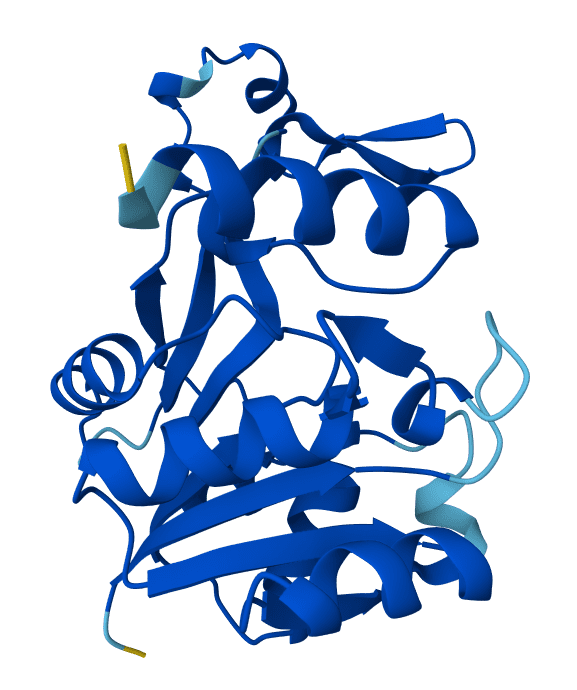
- Description: N-Acylneuraminate Cytidylyltransferase (CSS) is an enzyme; found in bacteria and eukarya, that catalyzes the penultimate step in the addition of sialic acids to the oligosaccharide component of glycoconjugates and is a required component of sialylation pathways. While bacterial and eukaryotic CSS’s share several common catalytic properties, many critical differences have been studied, including the substrate specificity, tertiary structure, inhibitor sensitivity, and cellular localization. Thus, bacterial N-Acylneuraminate Cytidylyltransferases can be targeted by rational drug design strategies.
- Synonyms: CMP-Sialate Diphosphorylase; CMP-Sialate Pyrophosphorylase; CMP-Sialate Synthase
- Reaction: N-Acetylneuraminate + CTP = CMP-N-Acetylneuraminate + Diphosphate
- Unit Definition: One unit will form 1.0 μmole of N-acetylneuraminate from cytidine-5′-phospho-N-acetylneuraminate and inorganic pyrophosphate per min at pH 7.6 and 25 oC.
- Chemical Purity: ≥ 90% (SDS-PAGE)
- Form: 1X PBS Buffer, pH 7.5; 50% Glycerol
- Storage: ≤ -20 oC; Avoid Freeze-Thaw Cycles
| Product Number | Description - Stable Isotope Position | Availability | Unit Size | Price |
|---|---|---|---|---|
| A1KRA1-1 | N. meningitidis CSS [EC 2.7.7.43]; ≥ 10 units/mg protein; Recombinant from E. coli | 30-Day Lead Time | 1 mg | Quote |
| Q9CP68-1 | P. multocida CSS [EC 2.7.7.43]; ≥ 50 units/mg protein; Recombinant from E. coli | 30-Day Lead Time | 1 mg | Quote |
| Custom Synthesis | (Please Explore our Custom Expression Options for Insperation) | Variable Lead Times | TBD | Quote |
* Stable isotope labeled proteins are exclusively marketed & sold through Cambridge Isotope Laboratories (CIL).
Cyclic GMP-AMP Synthase
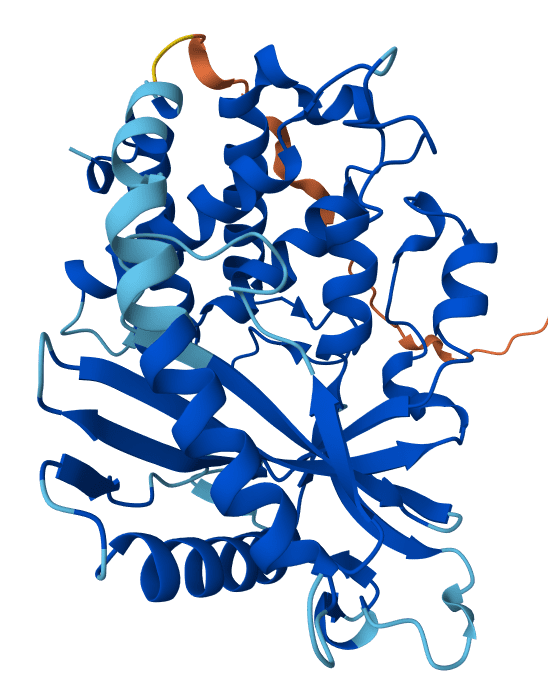
- Description: Cyclic GMP-AMP Synthase (cGAS) is a cytosolic DNA sensor that activates innate immunity type-I interferon (IFN) response. It is part of the cGAS-STING DNA sensing pathway. cGAS binds to microbial DNA, viral DNA, and host DNA that invades the cytoplasm, as well as, the presence of neutrophil extracellular traps (NETs) that are translocated to the cytosol following phagocytosis. The sensing of this DNA results of the synthesis of the second messenger cGAMP, which subsequently binds to and activates the endoplasmic reticulum protein STING to trigger type-I IFN production. cGAS deficiency results vulnerability to lethal infection by DNA viruses and RNA viruses. In addition, cGAS has been shown to be an innate immune sensor of retroviruses.
- Synonyms: cGAMP Synthase; Mab-21 Domain-Containing Protein; cGAS
- Reaction: ATP + GTP = 2′,3′-cGAMP + 2 Diphosphate
- Unit Definition: One unit will form 1.0 μmole of 2′,3′-cGAMP per min at pH 7.5 and 37 oC.
- Chemical Purity: ≥ 90% (SDS-PAGE)
- Form: 1X PBS Buffer, pH 7.5; 50% Glycerol
- Storage: ≤ -20 oC; Avoid Freeze-Thaw Cycles
| Product Number | Description - Stable Isotope Position | Availability | Unit Size | Price |
|---|---|---|---|---|
| Q8N884-1 | H. sapiens cGAS [EC 2.7.7.86]; ≥ 1 unit/mg protein; Recombinant from E. coli | 30-Day Lead Time | 1 mg | Quote |
| Custom Synthesis | (Please Explore our Custom Expression Options for Insperation) | Variable Lead Times | TBD | Quote |
* Stable isotope labeled proteins are exclusively marketed & sold through Cambridge Isotope Laboratories (CIL).
Diguanylate Cyclase
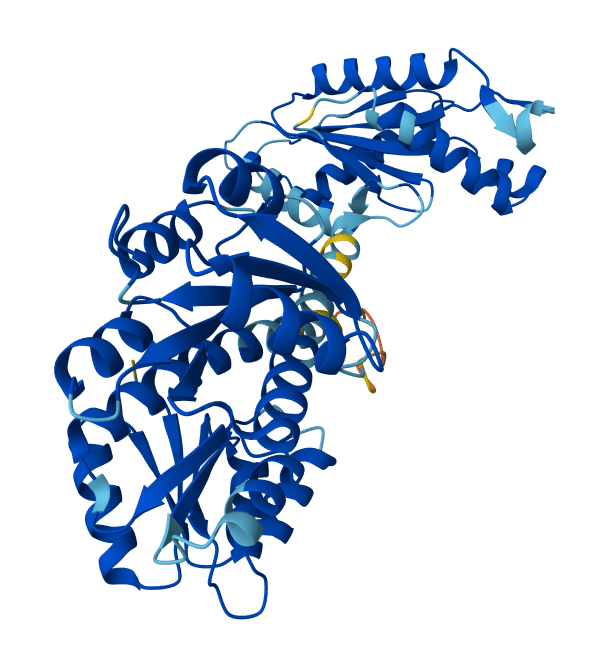
- Description: Diguanylate Cyclase (DGC) catalyzes the formation of the ubiquitous STING agonist and bacterial second messenger, cyclic-di-GMP that mediates various physiological aspects of diverse environmental and pathogenic bacteria. Cyclic-di-GMP plays critical aspects in bacterial: motility, bioluminescence, dispersion, virulence, adhesion, secretion, community behaviour, biofilm formation, and cell cycle progression. Cyclic-di-GMP also has anti-cancer cell proliferation activity, as well as, induces elevated CD4 receptor expression and cell cycle arrest.
- Synonyms: Diguanylate Kinase; DGC
- Reaction: 2 GTP = 3′,3′-c-di-GMP + 2 Diphosphate
- Unit Definition: One unit will form 1.0 μmole of 3′,3′-c-di-GMP per min at pH 7.5 and 37 oC.
- Chemical Purity: ≥ 90% (SDS-PAGE)
- Form: 1X PBS Buffer, pH 7.5; 50% Glycerol
- Storage: ≤ -20 oC; Avoid Freeze-Thaw Cycles
| Product Number | Description - Stable Isotope Position | Availability | Unit Size | Price |
|---|---|---|---|---|
| Q9KVG7-1 | V. cholerae serotype O1 DGC [EC 2.7.7.65]; ≥ 15 units/mg protein; Recombinant from E. coli | 30-Day Lead Time | 1 mg | Quote |
| Custom Synthesis | (Please Explore our Custom Expression Options for Insperation) | Variable Lead Times | TBD | Quote |
* Stable isotope labeled proteins are exclusively marketed & sold through Cambridge Isotope Laboratories (CIL).
DNA-Directed RNA Polymerase
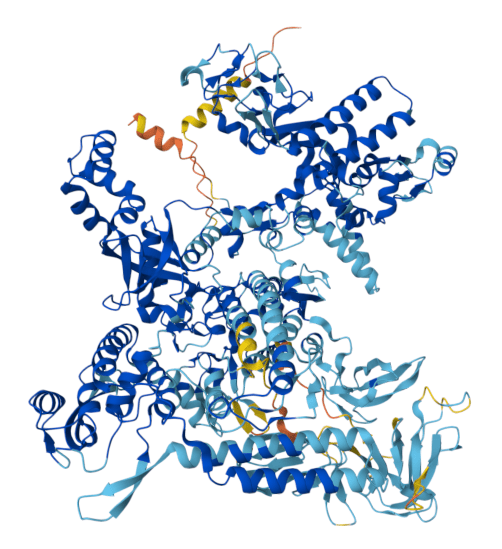
- Description: DNA-Directed RNA Polymerase (RNAP) is an essential enzyme in the replicating systems of prokaryotic and eukaryotic organisms, as well as, cytoplasmic DNA viruses. RNAP catalyzes the synthesis of RNA complementary strand (5’→3′) to the single-stranded DNA or double-stranded DNA template strand downstream of the promoter. Applications of Bacteriophage T7 RNA Polymerase include: the in vitro synthesis of radiolabeled RNA, and for studies related to RNA structure, processing, and catalysis.
- Synonyms: DNA-Dependent RNA Polymerase; RNA Nucleotidyltransferase (DNA-Directed)
- Reaction: rNTP + RNAn = Diphosphate + RNAn+1
- Unit Definition: One unit will incorporate 1.0 μmole of rATP into RNA per min at pH 7.5 and 37 oC.
- Chemical Purity: ≥ 90% (SDS-PAGE)
- Form: 1X PBS Buffer, pH 7.5; 50% Glycerol
- Storage: ≤ -20 oC; Avoid Freeze-Thaw Cycles
| Product Number | Description - Stable Isotope Position | Availability | Unit Size | Price |
|---|---|---|---|---|
| P00573-1 | Bacteriophage T7 RNAP [EC 2.7.7.6]; ≥ 5 units/mg protein; Recombinant from E. coli | In Pipeline | - | - |
| Custom Synthesis | (Please Explore our Custom Expression Options for Insperation) | Variable Lead Times | - | - |
* Stable isotope labeled proteins are exclusively marketed & sold through Cambridge Isotope Laboratories (CIL).
Glucose-1-Phosphate Cytidylyltransferase
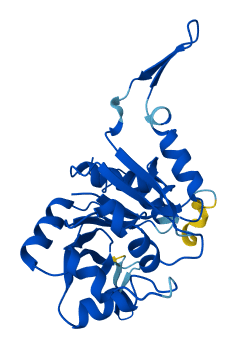
- Description: Glucose-1-Phosphate Cytidylyltransferase (CGP) is found predominanty in bacteria and archaea, where it participates in nucleotide sugars metabolism. CGP’s are critical to the biosynthesis of Gram-negative bacterial O-lipopolysaccharide surface antigens. These lipopolysaccharides in turn, play a role in pathogenicity and are recognized by the immunological defense system of the host. Tyvelose is a 3,6-dideoxyhexose found in the O-antigen of the surface lipopolysaccharides of some pathogenic bacteria, synthesized via a complex biochemical pathway that is initiated by the formation of CDP-D-glucose.
- Synonyms: CDP-Glucose Diphosphorylase; CDP-Glucose Pyrophosphorylase
- Reaction: Glucose-1-Phosphate + H+ + CTP = CDP-Glucose + Diphosphate
- Unit Definition: One unit will form 1.0 μmole of glucose-1-phosphate from cytidine-5′-diphosphoglucose and inorganic pyrophosphate per min at pH 7.6 and 25 oC.
- Chemical Purity: ≥ 90% (SDS-PAGE)
- Form: 1X PBS Buffer, pH 7.5; 50% Glycerol
- Storage: ≤ -20 oC; Avoid Freeze-Thaw Cycles
| Product Number | Description - Stable Isotope Position | Availability | Unit Size | Price |
|---|---|---|---|---|
| E4NWX4-1 | B. bifidum CGP [EC 2.7.7.33]; ≥ 10 units/mg protein; Recombinant from E. coli | 30-Day Lead Time | 1 mg | Quote |
| Custom Synthesis | (Please Explore our Custom Expression Options for Insperation) | Variable Lead Times | TBD | Quote |
* Stable isotope labeled proteins are exclusively marketed & sold through Cambridge Isotope Laboratories (CIL).
Glucose-1-Phosphate Thymidylyltransferase
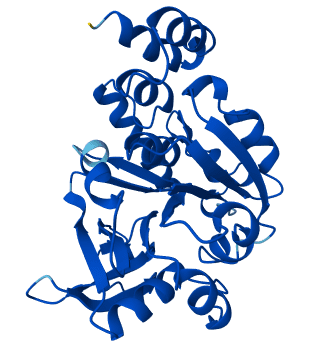
- Description: Glucose-1-Phosphate Thymidylyltransferase (TGP) is found predominanty in bacteria and archaea, where it participates in a variety of metabolic pathways: nucleotide sugars metabolism, streptomycin biosynthesis, and polyketide sugar unit biosynthesis. TGP’s also are critical to the biosynthesis of dTDP-L-rhamnose, an essential component of cell-walls and O-lipopolysaccharide surface antigens.
- Synonyms: dTDP-Glucose Diphosphorylase; dTDP-Glucose Pyrophosphorylase
- Reaction: Glucose-1-Phosphate + H+ + dTTP = dTDP-Glucose + Diphosphate
- Unit Definition: One unit will form 1.0 μmole of glucose-1-phosphate from thymidine-5′-diphosphoglucose and inorganic pyrophosphate per min at pH 7.6 and 25 oC.
- Chemical Purity: ≥ 90% (SDS-PAGE)
- Form: 1X PBS Buffer, pH 7.5; 50% Glycerol
- Storage: ≤ -20 oC; Avoid Freeze-Thaw Cycles
| Product Number | Description - Stable Isotope Position | Availability | Unit Size | Price |
|---|---|---|---|---|
| E4NWX4-1 | B. bifidum TGP [EC 2.7.7.24]; ≥ 100 units/mg protein; Recombinant from E. coli | 30-Day Lead Time | 1 mg | Quote |
| Custom Synthesis | (Please Explore our Custom Expression Options for Insperation) | Variable Lead Times | TBD | Quote |
* Stable isotope labeled proteins are exclusively marketed & sold through Cambridge Isotope Laboratories (CIL).
Glucose-1-Phosphate Uridylyltransferase
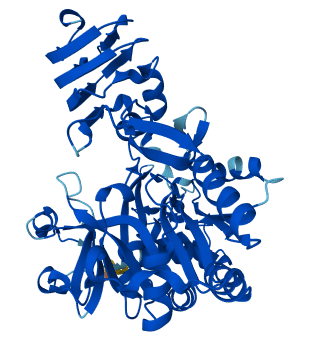
- Description: Glucose-1-Phosphate Uridylyltransferase (UGP) is an enzyme found in all three domains of life (bacteria, eukarya, and archaea) and plays key roles in galactose metabolism, glycogenesis, glycoprotein synthesis, glycolipid synthesis, and cell-wall synthesis. Mutations or downregulation of UGP can result in galactosemia, Barakat-Perenthaler syndrome, impared glycogen synthesis, and cancer. Moreover, UGP has been found to be an important virulence factor in a variety of pathogens including bacteria and protozoa.
- Synonyms: UDP-Glucose Diphosphorylase; UDP-Glucose Pyrophosphorylase; UGP
- Reaction: Glucose-1-Phosphate + H+ + UTP = UDP-Glucose + Diphosphate
- Unit Definition: One unit will form 1.0 μmole of glucose-1-phosphate from uridine-5′-diphosphoglucose and inorganic pyrophosphate per min at pH 7.6 and 25 oC.
- Chemical Purity: ≥ 90% (SDS-PAGE)
- Form: 1X PBS Buffer, pH 7.5; 50% Glycerol
- Storage: ≤ -20 oC; Avoid Freeze-Thaw Cycles
| Product Number | Description - Stable Isotope Position | Availability | Unit Size | Price |
|---|---|---|---|---|
| E4NWX4-1 | B. bifidum ugpA [EC 2.7.7.9]; ≥ 150 units/mg protein; Recombinant from E. coli | 30-Day Lead Time | 1 mg | Quote |
| Q43772-1 | H. vulgare ugpA [EC 2.7.7.9]; ≥ 40 units/mg protein; Recombinant from E. coli | 30-Day Lead Time | 1 mg | Quote |
| P32861 | S. cerevisiae ugpA [EC 2.7.7.9]; ≥ 20 units/mg protein; from Baker's Yeast | 30-Day Lead Time | 1 mg | Quote |
| Custom Synthesis | (Please Explore our Custom Expression Options for Insperation) | Variable Lead Times | TBD | Quote |
* Stable isotope labeled proteins are exclusively marketed & sold through Cambridge Isotope Laboratories (CIL).
Monosaccharide-1-Phosphate Uridylyltransferase
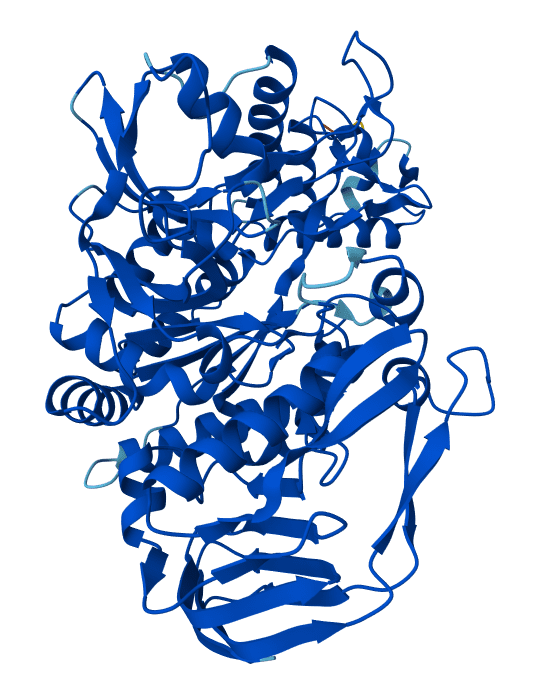
- Description: Monosaccharide-1-Phosphate Uridylyltransferase (USP) is an enzyme found predominantly in eukaryotes, where it plays key roles in galactose metabolism and salvage pathways for synthesis of nucleotide sugars. USP may also function as the terminal enzyme of the myo-inositol oxidation (MIO) pathway. USP’s commonly show broad substrate specificity toward monosaccharide-1-phosphates, catalyzing the formation of: UDP-Glc, UDP-Gal, UDP-GlcA, UDP-L-Ara, and UDP-Xyl. Conversely, the monosaccharide-1-phosphates of mannose and fucose are not substrates, and UTP cannot typically be replaced by other nucleotide triphosphates.
- Synonyms: UDP-Sugar Pyrophosphorylase; USP
- Reaction: Monosaccharide-1-Phosphate + H+ + UTP = UDP-Monosaccharide + Diphosphate
- Unit Definition: One unit will form 1.0 μmole of Glucose-1-Phosphate from Uridine-5′-Diphosphoglucose and Inorganic Pyrophosphate per min at pH 7.6 and 25 oC.
- Chemical Purity: ≥ 90% (SDS-PAGE)
- Form: 1X PBS Buffer, pH 7.5; 50% Glycerol
- Storage: ≤ -20 oC; Avoid Freeze-Thaw Cycles
| Product Number | Description - Stable Isotope Position | Availability | Unit Size | Price |
|---|---|---|---|---|
| E4NWX4-1 | B. bifidum USP [EC 2.7.7.64]; ≥ 150 units/mg protein; Recombinant from E. coli | 30-Day Lead Time | 1 mg | Quote |
| Custom Synthesis | (Please Explore our Custom Expression Options for Insperation) | Variable Lead Times | TBD | Quote |
* Stable isotope labeled proteins are exclusively marketed & sold through Cambridge Isotope Laboratories (CIL).
Phosphoribosyltransferases
Template
- Description: Add Description Here.
- Synonyms: Name #1; Name #2; Nrame #3
- Reaction: Reactent = Product
- Unit Definition: One unit will interconvert 1.0 μmole of X to Y per min at pH 7.5 and 30 oC.
- Chemical Purity: ≥ 90% (SDS-PAGE)
- Form: 1X PBS Buffer, pH 7.5; 50% Glycerol
- Storage: ≤ -20 oC; Avoid Freeze-Thaw Cycles
| Product Number | Description - Stable Isotope Position | Availability | Unit Size | Price |
|---|---|---|---|---|
| UNIPROT-1 | G. species ABC [EC #.#.#.#]; ≥ 1 units/mg protein; Recombinant from E. coli | 30-Day Lead Time | 1 mg | Quote |
| Custom Expression | (Please Explore our Custom Expression Options for Insperation) | Variable Lead Times | TBD | Quote |
* Stable isotope labeled proteins are exclusively marketed & sold through Cambridge Isotope Laboratories (CIL).
Adenine Phosphoribosyltransferase
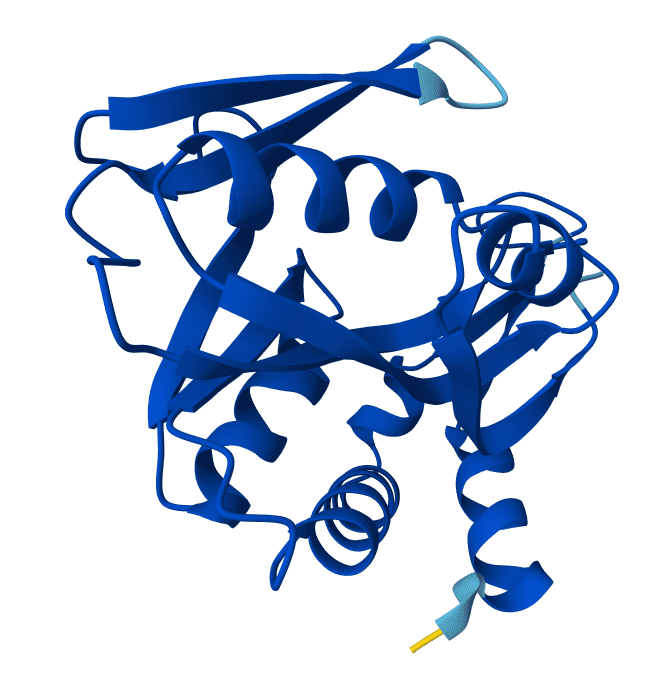
- Description: Adenine Phosphoribosyltransferase (APRTase) catalyzes a salvage reaction resulting in the formation of AMP, that is a less energically costly alternative to de novo purine nucleotide synthesis. APRTase is widely distributed in nature; from bacteria to eukaryotes, with APRTase providing the sole source of AMP in parasitic protozoa such as Giardia. APRTase deficiency in humans contributes to the formation of kidney stones (urolithiasis) and to potential kidney failure.
- Synonyms: AMP Diphosphorylase; Transphosphoribosidase
- Reaction: AMP + Diphosphate = PRPP + Adenine
- Unit Definition: One unit will synthesize 1.0 μmole of AMP per min from adenine and PRPP at pH 7.5 and 25 oC.
- Chemical Purity: ≥ 90% (SDS-PAGE)
- Form: 1X PBS Buffer, pH 7.5; 50% Glycerol
- Storage: ≤ -20 oC; Avoid Freeze-Thaw Cycles
| Product Number | Description - Stable Isotope Position | Availability | Unit Size | Price |
|---|---|---|---|---|
| P69503-1 | E. coli APRTase [EC 2.4.2.7]; ≥ 80 units/mg protein; Recombinant from E. coli | 30-Day Lead Time | 1 mg | Quote |
| Custom Expression | (Please Explore our Custom Expression Options for Insperation) | Variable Lead Times | TBD | Quote |
* Stable isotope labeled proteins are exclusively marketed & sold through Cambridge Isotope Laboratories (CIL).
Hypoxanthine Phosphoribosyltransferase

- Description: Hypoxanthine Phosphoribosyltransferase (HPRTase) catalyzes a salvage reaction resulting in the formation of IMP and GMP, that are less energically costly alternatives to de novo purine nucleotide synthesis. HPRTase is widely distributed in nature; from bacteria to eukaryotes, with HPRTase providing the sole source of GMP in parasitic protozoa such as Leishmania. HPRTase deficiency and mutations in the human enzyme contributes to diseases such as: hyperuricemia, gout, Kelley-Seegmiller syndrome, and Lesch-Nyhan syndrome.
- Synonyms: IMP Diphosphorylase; Guanine Phosphoribosyltransferase
- Reaction: IMP + Diphosphate = PRPP + Hypoxanthine
- Unit Definition: One unit will synthesize 1.0 μmole of IMP per min from hypoxanthine and PRPP at pH 7.5 and 25 oC.
- Chemical Purity: ≥ 90% (SDS-PAGE)
- Form: 1X PBS Buffer, pH 7.5; 50% Glycerol
- Storage: ≤ -20 oC; Avoid Freeze-Thaw Cycles
| Product Number | Description - Stable Isotope Position | Availability | Unit Size | Price |
|---|---|---|---|---|
| P0A9M2-1 | E. coli HPRTase [EC 2.4.2.8]; ≥ 150 units/mg protein; Recombinant from E. coli | 30-Day Lead Time | 1 mg | Quote |
| Custom Expression | (Please Explore our Custom Expression Options for Insperation) | Variable Lead Times | TBD | Quote |
* Stable isotope labeled proteins are exclusively marketed & sold through Cambridge Isotope Laboratories (CIL).
Nicotinamide Phosphoribosyltransferase
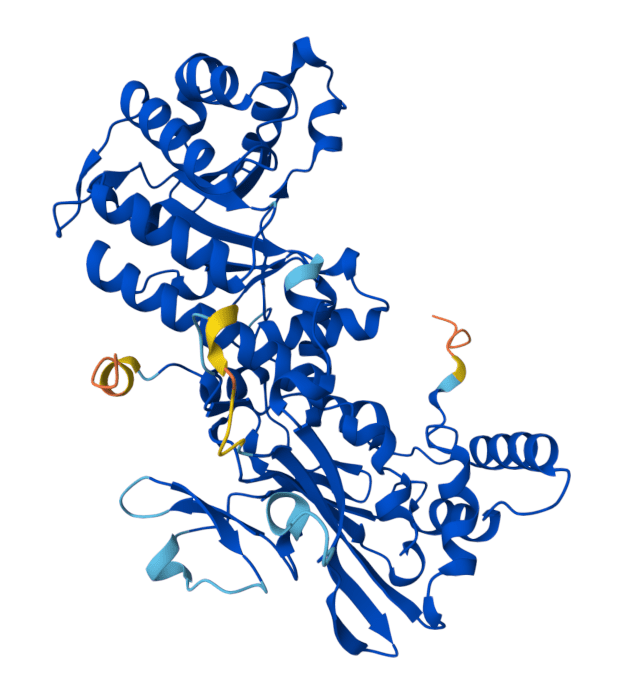
- Description: Nicotinamide Phosphoribosyltransferase (NAMPTase) catalyzes the salvage reaction resulting in the rate-limiting formation of nicotinamide mononucleotide (NMN), which is responsible for most of the NAD+ formation in mammals. NAMPTase has been reported to be a cytokine which promotes B cell maturation (through that activation of TLR4), inhibits neutrophil apoptosis, as well as, playing a role in the modulation of circadian clock function.
- Synonyms: NMN Diphosphorylase; NMN Pyrophosphorylase
- Reaction: NMN + ADP + Diphosphate = PRPP + ATP + Nicotinamide
- Unit Definition: One unit will synthesize 1.0 μmole of NMN per min from nicotinamide and PRPP at pH 7.5 and 25 oC.
- Chemical Purity: ≥ 90% (SDS-PAGE)
- Form: 1X PBS Buffer, pH 7.5; 50% Glycerol
- Storage: ≤ -20 oC; Avoid Freeze-Thaw Cycles
| Product Number | Description - Stable Isotope Position | Availability | Unit Size | Price |
|---|---|---|---|---|
| P43490-1 | H. sapiens NAMPTase [EC 2.4.2.12]; ≥ 1 unit/mg protein; Recombinant from E. coli | In Pipeline | - | - |
| Custom Expression | (Please Explore our Custom Expression Options for Insperation) | Variable Lead Times | - | - |
* Stable isotope labeled proteins are exclusively marketed & sold through Cambridge Isotope Laboratories (CIL).
Nicotinate Phosphoribosyltransferase
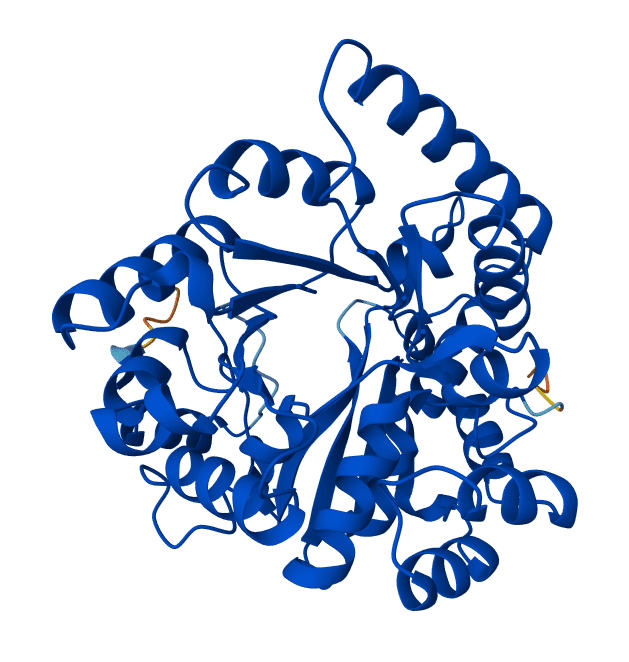
- Description: Nicotinate Phosphoribosyltransferase (NicPRTase) catalyzes the pyridine nucleotide salvage reaction resulting in the rate-limiting formation of nicotinate mononucleotide (NicMN), which is responsible for most of the NAD+ formation in bacteria. NicPRTase is a pleiotropic protein implicated in the pathogenesis of acute respiratory distress syndrome, aging, cancer, coronary heart diseases, diabetes, nonalcoholic fatty liver disease, obesity, rheumatoid arthritis, and sepsis.
- Synonyms: niacin ribonucleotidase; nicotinic acid mononucleotide glycohydrolase
- Reaction: PRPP + ATP + H2O + Nicotinate = ADP + Diphosphate + NicMN + Phosphate
- Unit Definition: One unit will synthesize 1.0 μmole of NicMN per min from nicotinate, PRPP, and ATP at pH 7.5 and 25 oC.
- Chemical Purity: ≥ 90% (SDS-PAGE)
- Form: 1X PBS Buffer, pH 7.5; 50% Glycerol
- Storage: ≤ -20 oC; Avoid Freeze-Thaw Cycles
| Product Number | Description - Stable Isotope Position | Availability | Unit Size | Price |
|---|---|---|---|---|
| P18133-1 | E. coli NicPRTase [EC 6.3.4.21]; ≥ 20 units/mg protein; Recombinant from E. coli | 30-Day Lead Time | 1 mg | Quote |
| Custom Expression | (Please Explore our Custom Expression Options for Insperation) | Variable Lead Times | TBD | Quote |
* Stable isotope labeled proteins are exclusively marketed & sold through Cambridge Isotope Laboratories (CIL).
Orotate Phosphoribosyltransferase
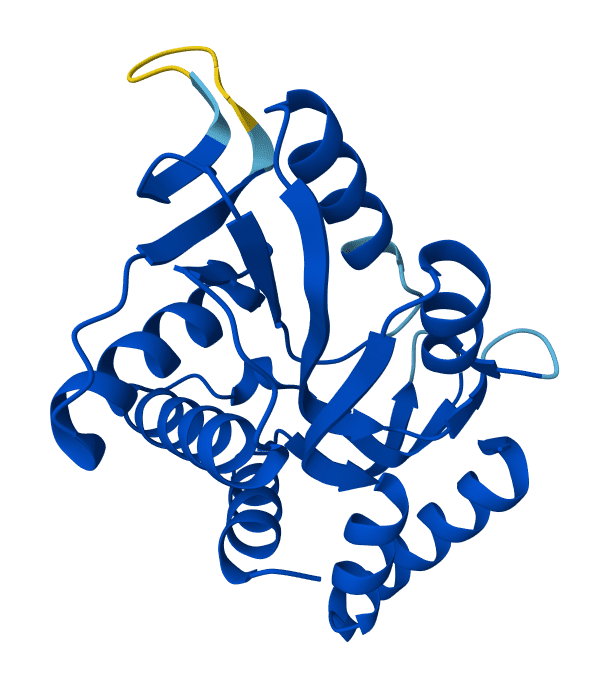
- Description: Orotate Phosphoribosyltransferase (OPRTase) is part of the de novo pyrimidine synthesis pathway, catalyzing the formation of OMP from orotate and phosphoribosyl pyrophosphate. In yeast and bacteria, OPRTase is an independent enzyme with a unique gene coding for the protein, whereas in mammals and other multicellular organisms, the catalytic function is carried out by a domain of the bifunctional enzyme UMP synthase [EC 4.1.1.23]. Defects in OPRTase have been implicated in numerous medical conditions, including: orotic aciduria, megaloblastic anemia, and orotic acid crystalluria.
- Synonyms: Orotidine-5′-Phosphate Pyrophosphorylase; Orotidylic Acid Phosphorylase
- Reaction: Diphosphate + OMP = PRPP + Orotate
- Unit Definition: One unit will synthesize 1.0 μmole of OMP per min from orotate and PRPP at pH 7.5 and 25 oC.
- Chemical Purity: ≥ 90% (SDS-PAGE)
- Form: 1X PBS Buffer, pH 7.5; 50% Glycerol
- Storage: ≤ -20 oC; Avoid Freeze-Thaw Cycles
| Product Number | Description - Stable Isotope Position | Availability | Unit Size | Price |
|---|---|---|---|---|
| P0A7E3-1 | E. coli OPRTase [EC 2.4.2.10]; ≥ 30 units/mg protein; Recombinant from E. coli | 30-Day Lead Time | 1 mg | Quote |
| Custom Expression | (Please Explore our Custom Expression Options for Insperation) | Variable Lead Times | TBD | Quote |
* Stable isotope labeled proteins are exclusively marketed & sold through Cambridge Isotope Laboratories (CIL).
Uracil Phosphoribosyltransferase
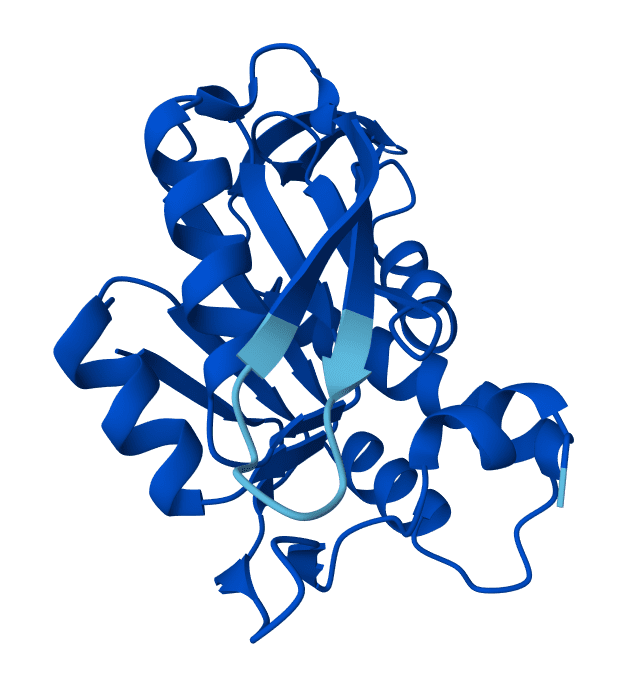
- Description: Uracil Phosphoribosyltransferase (UPRTase) catalyzes a salvage reaction resulting in the formation of UMP, that is a less energically costly alternative to de novo pyrimidine synthesis. UPRTase is widely distributed in nature, from bacteria to eukaryotes. The UPRTase enzyme is a potential target for rational design of drugs to treat parasitic infections and cancer.
- Synonyms: UMP Diphosphorylase; UMP Pyrophosphorylase
- Reaction: Diphosphate + UMP = PRPP + Uracil
- Unit Definition: One unit will synthesize 1.0 μmole of UMP per min from uracil and PRPP at pH 7.5 and 25 oC.
- Chemical Purity: ≥ 90% (SDS-PAGE)
- Form: 1X PBS Buffer, pH 7.5; 50% Glycerol
- Storage: ≤ -20 oC; Avoid Freeze-Thaw Cycles
| Product Number | Description - Stable Isotope Position | Availability | Unit Size | Price |
|---|---|---|---|---|
| P0A8F0-1 | E. coli UPRTase [EC 2.4.2.9]; ≥ 1 unit/mg protein; Recombinant from E. coli | 30-Day Lead Time | 1 mg | Quote |
| Custom Expression | (Please Explore our Custom Expression Options for Insperation) | Variable Lead Times | TBD | Quote |
* Stable isotope labeled proteins are exclusively marketed & sold through Cambridge Isotope Laboratories (CIL).
Xanthine Phosphoribosyltransferase

- Description: Xanthine Phosphoribosyltransferase (XPRTase) catalyzes a salvage reaction resulting in the formation of XMP, which is a less energically costly alternative to de novo purine synthesis. XPRTase is widely distributed in nature, from bacteria to eukaryotes. In E. coli, two distinct 6-oxopurine PRTases are expressed, with very different specificities for hypoxanthine, guanine, and xanthine. Enzyme kinetics suggests HPRTase [EC 2.4.2.8] is primarily responsible for the synthesis of IMP, while XPRTase [EC 2.4.2.22] salvages guanine and xanthine. The XPRTase enzyme is a potential target for rational design of drugs to treat parasitic infections.
- Synonyms: Xanthine-Guanine Phosphoribosyltransferase; Xanthylate Pyrophosphorylase
- Reaction: Diphosphate + XMP = PRPP + Xanthine
- Unit Definition: One unit will synthesize 1.0 μmole of XMP per min from uracil and PRPP at pH 7.5 and 25 oC.
- Chemical Purity: ≥ 90% (SDS-PAGE)
- Form: 1X PBS Buffer, pH 7.5; 50% Glycerol
- Storage: ≤ -20 oC; Avoid Freeze-Thaw Cycles
| Product Number | Description - Stable Isotope Position | Availability | Unit Size | Price |
|---|---|---|---|---|
| P0A9M5-1 | E. coli XPRTase [EC 2.4.2.22]; ≥ 30 units/mg protein; Recombinant from E. coli | 30-Day Lead Time | 1 mg | Quote |
| Custom Expression | (Please Explore our Custom Expression Options for Insperation) | Variable Lead Times | TBD | Quote |
* Stable isotope labeled proteins are exclusively marketed & sold through Cambridge Isotope Laboratories (CIL).
Phosphorylases
Template
- Description: Add Description Here.
- Synonyms: Name #1; Name #2; Nrame #3
- Reaction: Reactent = Product
- Unit Definition: One unit will interconvert 1.0 μmole of X to Y per min at pH 7.5 and 30 oC.
- Chemical Purity: ≥ 90% (SDS-PAGE)
- Form: 1X PBS Buffer, pH 7.5; 50% Glycerol
- Storage: ≤ -20 oC; Avoid Freeze-Thaw Cycles
| Product Number | Description - Stable Isotope Position | Availability | Unit Size | Price |
|---|---|---|---|---|
| UNIPROT-1 | G. species ABC [EC #.#.#.#]; ≥ 1 units/mg protein; Recombinant from E. coli | 30-Day Lead Time | 1 mg | Quote |
| Custom Expression | (Please Explore our Custom Expression Options for Insperation) | Variable Lead Times | TBD | Quote |
* Stable isotope labeled proteins are exclusively marketed & sold through Cambridge Isotope Laboratories (CIL).
Purine-Nucleoside Phosphorylase
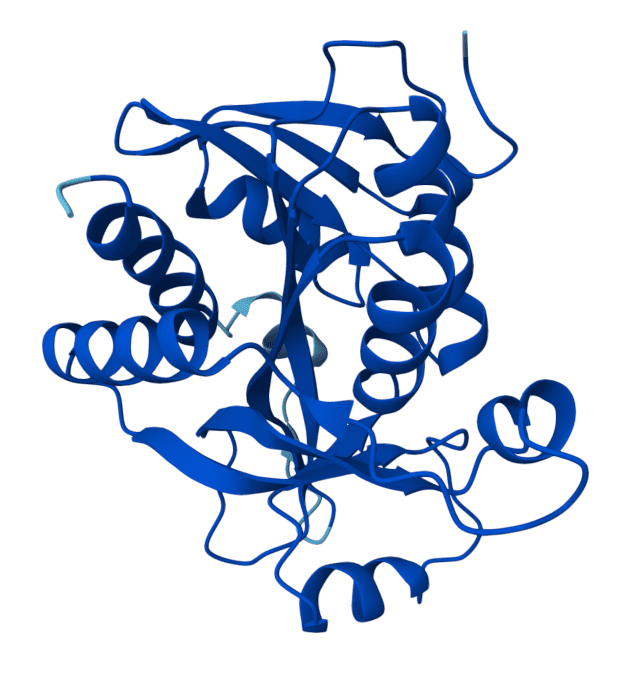
- Description: Purine-Nucleoside Phosphorylase (PuNPase) is widely distributed in nature; from bacteria to eukaryotes, participating in the purine salvage pathway and the reversible cleavage of inosine to hypoxanthine and guanosine to guanine. Human PuNPase is a target for therapeutic T-cell immune response intervention, while bacterial PuPNases have been used in the study inhibition of PuPNase deficiency resulting in neurologic manifestations.
- Synonyms: Inosine Phosphorylase; PNPase
- Reaction: Purine Nucleoside + Phosphate = Purine Nucleobase + Ribose-1-Phosphate
- Unit Definition: One unit will hydrolyze 1.0 μmole of inosine per min at pH 7.5 and 25 oC.
- Chemical Purity: ≥ 90% (SDS-PAGE)
- Form: 1X PBS Buffer, pH 7.5; 50% Glycerol
- Storage: ≤ -20 oC; Avoid Freeze-Thaw Cycles
| Product Number | Description - Stable Isotope Position | Availability | Unit Size | Price |
|---|---|---|---|---|
| P0ABP8-1 | E. coli PuNPase [EC 2.4.2.1]; ≥ 10 units/mg protein; Recombinant from E. coli | 30-Day Lead Time | 1 mg | Quote |
| P00491-1 | H. sapiens PuNPase [EC 2.4.2.1]; ≥ 20 units/mg protein; Recombinant from E. coli | 30-Day Lead Time | 1 mg | Quote |
| Custom Expression | (Please Explore our Custom Expression Options for Insperation) | Variable Lead Times | TBD | Quote |
* Stable isotope labeled proteins are exclusively marketed & sold through Cambridge Isotope Laboratories (CIL).
Pyrimidine-Nucleoside Phosphorylase
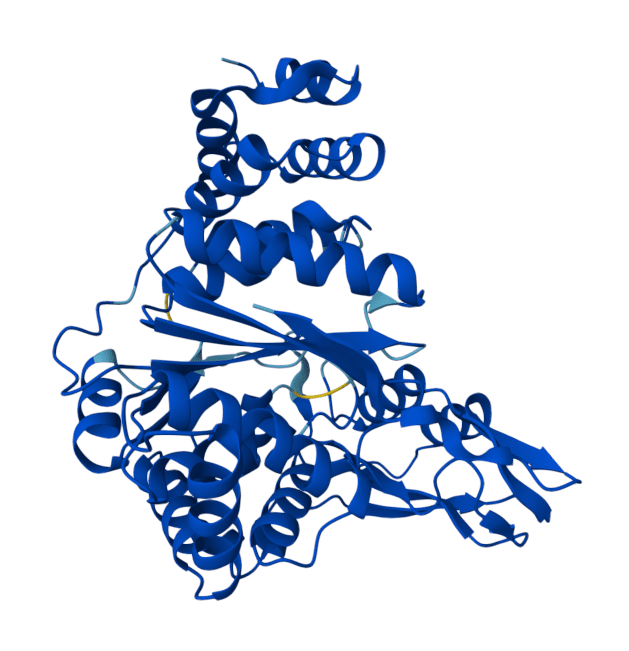
- Description: Pyrimidine-Nucleoside Phosphorylase (PyNPase) is widely distributed in nature; from bacteria to eukaryotes, participating in the pyrimidine salvage pathway and the reversible cleavage of both uridine to uracil and thymidine to thymine. PyNPase plays a significant role in breast cancer angiogenesis, and may be used as a marker to predict the malignant potential of breast cancer lymph node metastasis.
- Synonyms: PDP; Py-NPase
- Reaction: Pyrimidine Nucleoside + Phosphate = Pyrimidine Nucleobase + Ribose-1-Phosphate
- Unit Definition: One unit will hydrolyze 1.0 μmole of thymidine per min at pH 7.5 and 25 oC.
- Chemical Purity: ≥ 90% (SDS-PAGE)
- Form: 1X PBS Buffer, pH 7.5; 50% Glycerol
- Storage: ≤ -20 oC; Avoid Freeze-Thaw Cycles
| Product Number | Description - Stable Isotope Position | Availability | Unit Size | Price |
|---|---|---|---|---|
| P77836-1 | B. stearothermophilus PyNPase [EC 2.4.2.2]; ≥ 100 units/mg protein; Recombinant from E. coli | 30-Day Lead Time | 1 mg | Quote |
| P39142-1 | B. subtilis PyNPase [EC 2.4.2.2]; ≥ 50 units/mg protein; Recombinant from E. coli | 30-Day Lead Time | 1 mg | Quote |
| Custom Expression | (Please Explore our Custom Expression Options for Insperation) | Variable Lead Times | TBD | Quote |
* Stable isotope labeled proteins are exclusively marketed & sold through Cambridge Isotope Laboratories (CIL).
Racemases
Template
- Description: Add Description Here.
- Synonyms: Name #1; Name #2; Nrame #3
- Reaction: Reactent = Product
- Unit Definition: One unit will interconvert 1.0 μmole of X to Y per min at pH 7.5 and 30 oC.
- Chemical Purity: ≥ 90% (SDS-PAGE)
- Form: 1X PBS Buffer, pH 7.5; 50% Glycerol
- Storage: ≤ -20 oC; Avoid Freeze-Thaw Cycles
| Product Number | Description - Stable Isotope Position | Availability | Unit Size | Price |
|---|---|---|---|---|
| UNIPROT-1 | G. species ABC [EC #.#.#.#]; ≥ 1 units/mg protein; Recombinant from E. coli | 30-Day Lead Time | 1 mg | Quote |
| Custom Expression | (Please Explore our Custom Expression Options for Insperation) | Variable Lead Times | TBD | Quote |
* Stable isotope labeled proteins are exclusively marketed & sold through Cambridge Isotope Laboratories (CIL).
Broad-Specificity Amino-Acid Racemase

- Description: Broad-Specificity Amino-Acid Racemase (BSRS) utilizes a broad range of substrates, reversibly racemizing 10-19 of the natural chiral amino acids. Among these substrates, lysine and arginine are generally the most efficient, followed by the non-β-branched aliphatic (Ala, Leu, Met, Ser, Cys, Gln, and Asn) and the aromatic positively charged histidine. BSRS display minimal activity towards β-branched aliphatic (Ile, Val and Thr) and no active toward negatively charged (Glu and Asp) or aromatic (Tyr, Trp and Phe) amino acids. BSRS can also catalyze the racemization of several amino acids that are not typically incorporated into proteins (ornithine and norleucine), enabling bacteria to generate non-canonical D-amino acids (NCDAAs), whose roles and impact on microbial physiology, including modulation of cell wall structure and dissolution of biofilms.
- Synonyms: Broad-Spectrum Amino-Acid Racemase; BSRS
- Reaction: L-Amino Acid = D-Amino Acid
- Unit Definition: One unit will interconvert 1.0 μmole of an L-amino Acid to a D-amino Acid per min at pH 9.5 and 25 oC.
- Chemical Purity: ≥ 90% (SDS-PAGE)
- Form: 1X PBS Buffer, pH 7.5; 50% Glycerol
- Storage: ≤ -20 oC; Avoid Freeze-Thaw Cycles
| Product Number | Description - Stable Isotope Position | Availability | Unit Size | Price |
|---|---|---|---|---|
| I0J1I6-1 | P. taetrolens BSRS [EC 5.1.1.10]; ≥ 90 units/mg protein; Recombinant from E. coli | 30-Day Lead Time | 1 mg | Quote |
| Q9KSE5-1 | V. cholerae BSRS [EC 5.1.1.10]; ≥ 30 units/mg protein; Recombinant from E. coli | 30-Day Lead Time | 1 mg | Quote |
| Custom Expression | (Please Explore our Custom Expression Options for Insperation) | Variable Lead Times | TBD | Quote |
* Stable isotope labeled proteins are exclusively marketed & sold through Cambridge Isotope Laboratories (CIL).
Reductases
Template
- Description: Add Description Here.
- Synonyms: Name #1; Name #2; Nrame #3
- Reaction: Reactent = Product
- Unit Definition: One unit will interconvert 1.0 μmole of X to Y per min at pH 7.5 and 30 oC.
- Chemical Purity: ≥ 90% (SDS-PAGE)
- Form: 1X PBS Buffer, pH 7.5; 50% Glycerol
- Storage: ≤ -20 oC; Avoid Freeze-Thaw Cycles
| Product Number | Description - Stable Isotope Position | Availability | Unit Size | Price |
|---|---|---|---|---|
| UNIPROT-1 | G. species ABC [EC #.#.#.#]; ≥ 1 units/mg protein; Recombinant from E. coli | 30-Day Lead Time | 1 mg | Quote |
| Custom Expression | (Please Explore our Custom Expression Options for Insperation) | Variable Lead Times | TBD | Quote |
* Stable isotope labeled proteins are exclusively marketed & sold through Cambridge Isotope Laboratories (CIL).
Ribonucleoside-Triphosphate Reductase
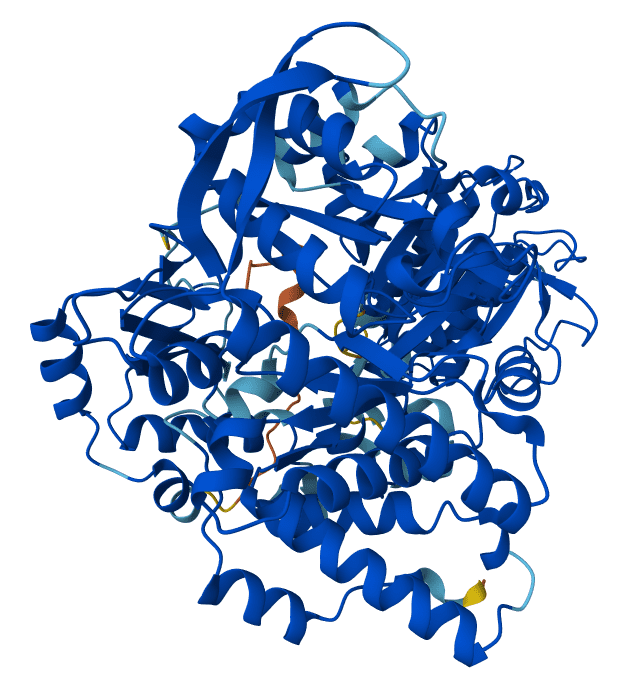
- Description: Ribonucleoside-Triphosphate Reductase (RTPR), characterized from the bacterium Lactobacillus leichmannii, is similar to class II ribonucleoside-diphosphate reductase [EC 1.17.4.1]; however, it is specific for the triphosphate versions of its substrates. The enzyme contains an adenosylcobalamin cofactor that is involved in generation of a transient thiyl (sulfanyl) radical on a cysteine residue.
- Synonyms: Ribonucleotide Reductase; 2′-Deoxyribonucleoside-Triphosphate:oxidized-Thioredoxin 2′-Oxidoreductase
- Reaction: [Thioredoxin]-Disulfide + dNTP + H2O = [Thioredoxin]-Dithiol + rNTP
- Unit Definition: One unit will synthesize 1.0 μmole of dNTP per min from an rNTP at pH 7.5 and 37 oC.
- Chemical Purity: ≥ 90% (SDS-PAGE)
- Form: 1X PBS Buffer, 10 mM Dithiothreitol, 0.1 mM CoB12, pH 7.5; 50% Glycerol
- Storage: ≤ -20 oC; Avoid Freeze-Thaw Cycles
| Product Number | Description - Stable Isotope Position | Availability | Unit Size | Price |
|---|---|---|---|---|
| Q59490-1 | L. leichmannii RTPR [EC 1.17.4.2]; ≥ 200 units/mg protein; Recombinant from E. coli | 30-Day Lead Time | 1 mg | Quote |
| Custom Expression | (Please Explore our Custom Expression Options for Insperation) | Variable Lead Times | TBD | Quote |
* Stable isotope labeled proteins are exclusively marketed & sold through Cambridge Isotope Laboratories (CIL).
Thioredoxin-Disulfide Reductase
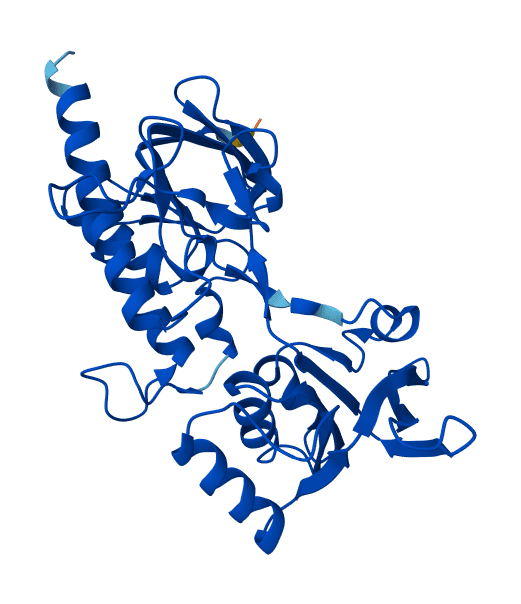
- Description: Thioredoxin-Disulfide Reductase (TRXR) is an NADPH-dependent, FAD-containing disulfide reductase that plays an important role in cell proliferation. TRXR is widely distributed in nature, from bacteria to eukaryotes. In bacteria, TRXR can also catalyze the reduction of glutaredoxin. Since the activity of this enzyme is essential for cell growth and survival, it is a good target for anti-tumor therapy, as well as, novel antibiotics against antibiotic resistant bacteria. TRXR from Escherichia coli can be used in peroxidase-coupled thioredoxin system assay for assessing the peroxidase activitiy of Cys-based thiol peroxidases.
- Synonyms: NADPH:Oxidized Thioredoxin Oxidoreductase; Thioredoxin Reductase (NADPH)
- Reaction: [Thioredoxin]-Dithiol + NADP+ = [Thioredoxin]-Disulfide + H+ + NADPH
- Unit Definition: One unit will reduce 1.0 μmole of [thioredoxin]-disulfide per min with NADPH at pH 7.5 and 25 oC.
- Chemical Purity: ≥ 90% (SDS-PAGE)
- Form: 1X PBS Buffer, pH 7.5; 50% Glycerol
- Storage: ≤ -20 oC; Avoid Freeze-Thaw Cycles
| Product Number | Description - Stable Isotope Position | Availability | Unit Size | Price |
|---|---|---|---|---|
| P0A9P4-1 | E. coli TRXR [EC 1.8.1.9] NADP/H Dependant; ≥ 50 units/mg protein; Recombinant from E. coli | 30-Day Lead Time | 1 mg | Quote |
| Custom Expression | (Please Explore our Custom Expression Options for Insperation) | Variable Lead Times | TBD | Quote |
* Stable isotope labeled proteins are exclusively marketed & sold through Cambridge Isotope Laboratories (CIL).
Other Proteins
Template
- Description: Add Description Here.
- Synonyms: Name #1; Name #2; Nrame #3
- Reaction: Reactent = Product
- Unit Definition: One unit will interconvert 1.0 μmole of X to Y per min at pH 7.5 and 30 oC.
- Chemical Purity: ≥ 90% (SDS-PAGE)
- Form: 1X PBS Buffer, pH 7.5; 50% Glycerol
- Storage: ≤ -20 oC; Avoid Freeze-Thaw Cycles
| Product Number | Description - Stable Isotope Position | Availability | Unit Size | Price |
|---|---|---|---|---|
| UNIPROT-1 | G. species ABC [EC #.#.#.#]; ≥ 1 units/mg protein; Recombinant from E. coli | 30-Day Lead Time | 1 mg | Quote |
| Custom Expression | (Please Explore our Custom Expression Options for Insperation) | Variable Lead Times | TBD | Quote |
* Stable isotope labeled proteins are exclusively marketed & sold through Cambridge Isotope Laboratories (CIL).
Casein*
- Description: Thioredoxin (TRX) participates in various redox reactions through the reversible oxidation of its active center dithiol to a disulfide and catalyzes dithiol-disulfide exchange reactions.
- Synonyms: Name1; Name2; TRX
- Reaction: Purine Nucleoside + Phosphate = Purine Nucleobase + Ribose-1-Phosphate
- Unit Definition: One unit will hydrolyze 1.0 μmole of Inosine per min at pH 7.5 and 25 oC.
- Chemical Purity: ≥ 90% (SDS)
- Form: 1X PBS Buffer, pH 7.5; 50% Glycerol
- Storage: ≤ -20 oC; Avoid Freeze-Thaw Cycles
| Product Number | Description - Stable Isotope Position | Availability | Unit Size | Price |
|---|---|---|---|---|
| UNIPROT-1 | E. coli TrxA [EC ?.?.?.?]; ≥ 10.0 μmole/min/mg protein; Recombinant from E. coli | 30-Day Lead Time | 100 Units | Quote |
| Custom Synthesis | (Please Explore our Custom Expression Options for Insperation) | Variable Lead Times | 100+ Units | Quote |
* Stable isotope labeled proteins are exclusively marketed & sold through Cambridge Isotope Laboratories (CIL).
Immunoglobulin-Binding Domain B1

- Description: Immunoglobulin-Binding Protein G (GB1) is expressed in group C and G streptococcal bacteria much like protein A, but with differing binding specificities for the Fc region of polyclonal and monoclonal IgG-type antibodies. The native GB1 also binds albumin, but because serum albumin is a major contaminant of antibody sources, the albumin binding site is often removed from recombinant forms of protein. GB1 is a cell surface protein that has found application in purifying antibodies, or labeled with a fluorophore or a single-stranded DNA strand and used in immunofluorescence and super-resolution imaging. The GB1 domain can also be used as an NMR protein standard or as part of a fusion protein to keep previously insoluble domain proteins folded and in solution.
- Synonyms: Protein G; GA Module; GB1
- Chemical Purity: ≥ 90% (SDS-PAGE)
- Form: 1.5 mM His6-TEV-GB1 (L230-E356), 1X PBS Buffer (pH 6.5), 0.1 mM DSS, 0.02% NaN3 in 90% H2O (v/v) H2O/D2O
- Storage: ≤ 8 oC; Avoid Freezing Sample
| Product Number | Description - Stable Isotope Position | Availability | Unit Size | Price |
|---|---|---|---|---|
| P06654-1 | Streptococcus sp. strain G 148 His6-TEV-GB1 (Natural Abundance); Recombinant from E. coli | 30-Day Lead Time | 1 NMR Tube | $1,000.00 |
| CLM-New-CA | Streptococcus sp. strain G 148 His6-TEV-GB1 (13C358, 99%); Recombinant from E. coli | 30-Day Lead Time | 1 NMR Tube | CIL |
| NLM-New-CA | Streptococcus sp. strain G 148 His6-TEV-GB1 (15N97, 98%); Recombinant from E. coli | 30-Day Lead Time | 1 NMR Tube | CIL |
| CNLM-8663-CA | Streptococcus sp. strain G 148 His6-TEV-GB1 (13C358, 99%; 15N97, 98%); Recombinant from E. coli | Low Stock | 1 NMR Tube | CIL |
| Custom Synthesis | (Please Explore our Custom Expression Options for Insperation) | Variable Lead Times | TBD | Quote |
* Stable isotope labeled proteins are exclusively marketed & sold through Cambridge Isotope Laboratories (CIL).
Insulin-Like Growth Factor 1 (IGF-1) Somatomedin C*
- Description: Insulin-like growth factor-binding proteins (IGF-BPs) form high affinity complexes with both insulin-like growth factor- I and II (IGF-I and IGF-II). Currently there are seven named IGF-BPs. Insulin-like growth factor-binding protein-1 (IGF-BP1) is a 25.4kDa cysteine-rich secreted protein. It is the most abundant IGF-BP in amniotic fluid and is expressed in liver, decidua and kidneys. Levels of IGF-BP1 in serum are lowest after food. It binds to both IGF-I and IGF-II with equal affinity. Phosphorylated IGF-BP1 hinders IGF actions, whereas non-phosphorylated IGF-BP1 is stimulatory. Recombinant human IGF-BP1 is a 25.4kDa protein consisting of 235 amino acid residues (Isoform A).
- Synonyms: Name1; Name2; TRX
- Reaction: Purine Nucleoside + Phosphate = Purine Nucleobase + Ribose-1-Phosphate
- Unit Definition: N/A
- Chemical Purity: ≥ 90% (SDS-PAGE)
- Form: 1X PBS Buffer, pH 7.5; 50% Glycerol
- Storage: ≤ -20 oC; Avoid Freeze-Thaw Cycles
| Product Number | Description - Stable Isotope Position | Availability | Unit Size | Price |
|---|---|---|---|---|
| P05019-1 | H. sapiens His6-trxA-TEV-IGF1 (G48-A118) protein; Recombinant from E. coli | 30-Day Lead Time | 1 mg | Quote |
| Custom Synthesis | (Please Explore our Custom Expression Options for Insperation) | Variable Lead Times | ≥ 10 mg | Quote |
* Stable isotope labeled proteins are exclusively marketed & sold through Cambridge Isotope Laboratories (CIL).
α-Lactalbumin

- Description: α-Lactalbumin (LALBA) is a small, globular protein found in all milk studied to date. α-Lactalbumin consists of a single polypeptide chain with 8 cysteines which form disulfide bridges. α-Lactalbumin binds several metal ions, including calcium, which is thought to play a role in the regeneration of native α-Lactalbumin from the reduced, denatured form. α-Lactalbumin also has a distinct zinc binding site that is thought to play a role in the binding of the lactose synthase complex, by altering the substrate specificity of UDP-Galactose:β-1,4-galactosyltransferase 1 [EC 2.4.1.22] and increasing the rate of lactose formation. α-Lactalbumin may also improve immune responsiveness, increase levels of glutathione systemically in animals, as well as, possess antiviral, anti-apoptotic, and anti-tumor activities. α-Lactalbumin from bovine milk has been used as a supplement of basal medium, and as a marker for sodium dodecyl sulfate-polyacrylamide gel electrophoresis (SDS-PAGE).
- Synonyms: Whey Protein; LALBA
- Chemical Purity: ≥ 90% (SDS-PAGE)
- Form: 1X PBS Buffer, pH 7.5; 50% Glycerol
- Storage: ≤ -20 oC; Avoid Freeze-Thaw Cycles
| Product Number | Description - Stable Isotope Position | Availability | Unit Size | Price |
|---|---|---|---|---|
| P00711 | B. taurus LALBA protein; from Bovine Milk | 30-Day Lead Time | 1 mg | Quote |
| P00709 | H. sapiens LALBA protein; from Human Milk | 30-Day Lead Time | 1 mg | Quote |
| Custom Expression | (Please Explore our Custom Expression Options for Insperation) | Variable Lead Times | TBD | Quote |
* Stable isotope labeled proteins are exclusively marketed & sold through Cambridge Isotope Laboratories (CIL).
Thioredoxin
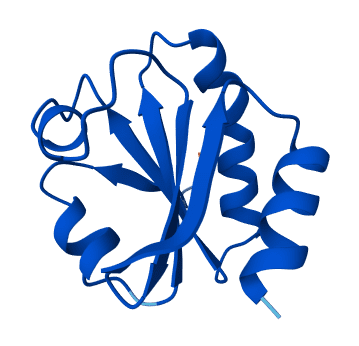
- Description: Thioredoxin (TrxA) is a class of small redox proteins known to be present in all organisms. TrxA participates in various redox reactions through the reversible oxidation of its active center dithiol to a disulfide and catalyzes dithiol-disulfide exchange reactions.
- Synonyms: TrxA; TRX; TXN
- Reaction: [Thioredoxin]-Dithiol + NAD(P)+ = [Thioredoxin]-Disulfide + H+ + NAD(P)H
- Unit Definition: One unit (insulin reduction unit) is calculated by measuring the change of 1.0 absorbance unit at 650 nm with 330 µM DTT per min at pH 6.5 and 25 oC
- Chemical Purity: ≥ 90% (SDS-PAGE)
- Form: 1X PBS Buffer, pH 7.5; 50% Glycerol
- Storage: ≤ -20 oC; Avoid Freeze-Thaw Cycles
| Product Number | Description - Stable Isotope Position | Availability | Unit Size | Price |
|---|---|---|---|---|
| P0AA25-1 | E. coli TrxA; ≥ 3 units/mg protein; Recombinant from E. coli | 30-Day Lead Time | 1 mg | Quote |
| Custom Synthesis | (Please Explore our Custom Expression Options for Insperation) | Variable Lead Times | TBD | Quote |
* Stable isotope labeled proteins are exclusively marketed & sold through Cambridge Isotope Laboratories (CIL).
Custom Expression Options
CASSIA, LLC has many years of experience in protein expression and purification as a result of our in vitro enzymatic synthesis program for nucleosides, nuceotides, and nucleotide-sugars. High throughput E.coli expression platforms offer a cost-effective option for stable isotope labeled protein expression to help expedite target projects. However, recombinant protein production is not always straightforward, as many factors can impact protein expression and purification. To address some of the labor-intensive and time-consuming optimization uncertainties and challenges, CASSIA, LLC protein expression experts offer custom bacterial expression services with cutting-edge solutions. Now customers can flexibly choose an option that fits their requirements, from codon optimization to gene synthesis to small-scale testing and scale-up, together with protein purification and characterization. CASSIA, LLC has built a well-equipped lab and employs skilled researchers and partners that ensure we have the ability to provide high-quality results at an affordable price.
Possible Applications:
- NMR Spectroscopy – these studies assess the structure, function, and interactions within a system or organism.
- Proteomics and Metabolomics – used as internal standards for precise quantification, allowing the accurate measurement of protein expression levels using mass spectrometry.
- Quality Control – isotope labeled peptides can be used to monitor the purity and integrity during large-scale protein production, ensuring that the final product meets quality standards.
CASSIA, LLC aims to offer excellent custom protein expression proposals for our clients. Our professional R&D team generates custom proposals for our clients according to their requirements, and we aim to meet our client’s needs beyond what they expected. Please explore some examples of available custom isotopomers CASSIA, LLC can utilize. If you are interested in our services, please feel free to contact us.
Available Stable Isotopomers
| Product Number | Description - Stable Isotope Position | Availability | Unit Size | Price |
|---|---|---|---|---|
| Custom Expression | Ammonium Chloride (Natural Abundance) | Variable Lead Times | TBD | Quote |
| Custom Expression | Ammonium Chloride (15N, 99%) | Variable Lead Times | TBD | Quote |
| Custom Expression | Ammonium Sulfate (Natural Abundance) | Variable Lead Times | TBD | Quote |
| Custom Expression | Ammonium Sulfate (15N2, 5%) | Variable Lead Times | TBD | Quote |
| Custom Expression | Ammonium Sulfate (15N2, 10%) | Variable Lead Times | TBD | Quote |
| Custom Expression | Ammonium Sulfate (15N2, 98%) | Variable Lead Times | TBD | Quote |
| Custom Expression | Ammonium Sulfate (15N2, 99%) | Variable Lead Times | TBD | Quote |
| Custom Expression | Deuterium Oxide (D, 70%) | Variable Lead Times | TBD | Quote |
| Custom Expression | Deuterium Oxide (D, 99.9%) | Variable Lead Times | TBD | Quote |
| Custom Expression | Deuterium Oxide (D, 99.96%) | Variable Lead Times | TBD | Quote |
| Custom Expression | D-Glucose (Natural Abundance) | Variable Lead Times | TBD | Quote |
| Custom Expression | D-Glucose (1,2,3,4,5,6-12C6, 99.9%) | Variable Lead Times | TBD | Quote |
| Custom Expression | D-Glucose (1,2,3,4,5,6,6'-D7, 98%) | Variable Lead Times | TBD | Quote |
| Custom Expression | D-Glucose (1,2,3,4,5,6-13C6, 99%) | Variable Lead Times | TBD | Quote |
| Custom Expression | D-Glucose (1,2,3,4,5,6-13C6, 99%; 1,2,3,4,5,6,6'-D7, 98%) | Variable Lead Times | TBD | Quote |
| Custom Expression | Water (Natural Abundance) | Variable Lead Times | TBD | Quote |
* Stable isotope labeled proteins are exclusively marketed & sold through Cambridge Isotope Laboratories (CIL).
